STONE HOUSES, MANSIONS AND OTHER OLD
HOUSES
OF THE NORTH COUNTRY
Originally published in The Watertown Daily Times
(730) Articles and photos by David Lane, Newspaper Staff
The traveler passing along the main routes, whether highway or rail,
through the hamlet of Felts Mills, is attracted to a beautiful Georgian
colonial house of red brick with limestone trim which stands a short distance
to the northward "on the east side of the road leading from Felts
Mills to Champion," according to the description in the deeds. Deeds
of almost a hundred years old also refer to it as the Hugh Roberts brick
house.
Not much is known of Hugh Roberts except that on September 18 1832 he paid Christopher Poor $900 for 107.22 acres of land which probably included the site of this house. Undoubtedly the house was erected shortly thereafter and the owner, making a substantial amount dealing 10 cattle, eventually pulled up stakes and removed to Chicago, where he prospered in the real estate business.
To whom he sold this brick house, the record does not show, but it was
likely his brother, Joshua. In any event on September 7 1857 Joshua sold
the horse and a lot having 63 feet frontage and 72 feet rear to his brother,
Charles, for $900. These boys and two other brothers, Stephen and David,
were sons of Daniel and Sarah Winner Roberts, Quakers, who had come up
to Philadelphia in 1805 with Robert Comfort, Josiah Walton, Thomas Coxe,
John and Thomas Townsend and Benjamin and Thomas Gilbert from General Jacob
Brown's Buck's county, Pennsylvania.
Charles Roberts was born near Philadelphia June 4 1831 and moved to Felts Mills when about 14. There he eventually became a prosperous manufacturer of carriages, axe helves and whiffletrees, and was also a merchant.
Across the street resided Henry H Babcock and it is said that after Babcock established a carriage factory in Watertown, Charles Roberts thought of joining him. Instead he came here about 1890 to form the retail and wholesale grocery house of Roberts & Sons, where part of the Bee Hive store now is. Charles Roberts died April 23 1910 but two of his sons, Charles A Roberts and the late Frank L Roberts together with their sister, Miss Ada Roberts, continued the business until July 1 1912.
All of the five children of Charles Roberts were born in the Felts Mills
red brick bouse. Daniel C, the eldest, was early a local clothing clerk
in this city who became one of the first associates of Fred M Kirby in
the 5-and-10 cent business and died a millionaire June 4 1940. Clarence
W Roberts, another son, was also a Kirby associate and store manager who
died at Meadville Pennsylvania, August 1 1944. Frank L, died in this city June 21
1929. Charles A, in recent years a real estate dealer, was president of
the Lincoln League in 1938-9.
Charles and Almira Freeman Roberts sold the brick house February 12 1867 to Mrs Emily Francis Middleton, widow of Robert Middleton, of Champion. By her will it passed to Celestia E Francis March 6 1890 who sold it April 7 1908 to Nellie A Sweet. The latter sold it to Irving Croan, an accomplished artist, April 16 1915 and he in turn disposed of it to William O Douglas November 9 1918. Mr Douglas sold to Oscar P Feistel, Taggart Paper corporation employe, the present owner and occupant September 6 1924. The house has a beautiful entrance and cornices, is excellently crafted and maintained.
For a century at least this fine old house has been known as the Christopher Middleton place, although it was built for Elias Clark in the middle 1830s. Elias Clark was one of five brothers who came from Halifax, Vermont, in 1803 and settled in the Rutland Hollow area of what is now Jefferson County. Between the Rutland Hollow road and a county road in the extreme north end of the town of Rutland there is a high ridge road known as Clark's hill overlooking the village of Black River and commanding a beautiful vista of that section of the picturesque valley of the Black River. It was upon this hill that Asa Clark built his beautiful Georgian colonial mansion of native limestone in 1835. The next house beyond it to the eastward is this Elias Clark or Christopher Middleton place.
Its construction was of that sturdy old type which employed the use of brick between the studs in the outside walls. Architecturally the house is well proportioned and designed with a dignified front entrance and a handsome main gable, cornices and semi-elliptical gable window.
But Elias Clark, father of twelve children evenly divided between sons and daughters, remained upon this farm less than a decade, for on May 2 1843 he and his wife Leafy, sold it and its 143.27 acres to Zuriel Penniman also of Rutland, for $3,243. Penniman, also one of the county's early settlers, was a native of New Hampshire.
After an ownership of little more than a year Zuriel and Nancy Everett Penniman sold the property to Christopher Middleton for $4,298.10. One of the well known Middleton family of this county, Christopher, son of John and Susannah Parkinson Middleton, was born in 1809 and in 1845 married Dorcas H Jones of Champion. Following his death, his will recorded October 4 1892 disclosed that he had given half of his residuary estate to his widow. Accordingly on December 7 1893 Andrew C Middleton as executor, sold the other half to her for $3,045 and at that time the property included another parcel of 31.195 acres.
Attorney Sam Child as executor of the estate of Mrs Dorcas H Middleton in turn sold the entire property to Alfred Fox of the town of Clayton for $4500 on February 18 1902 and he held it until January 12 1910 when he and his wife, Lois A Fox, conveyed it to their son-in-law and daughter, Frederick E and Lottie M Knutly, the present occupants.
Like the Asa Clark house this one of Elias Clark occupies high and commanding country.
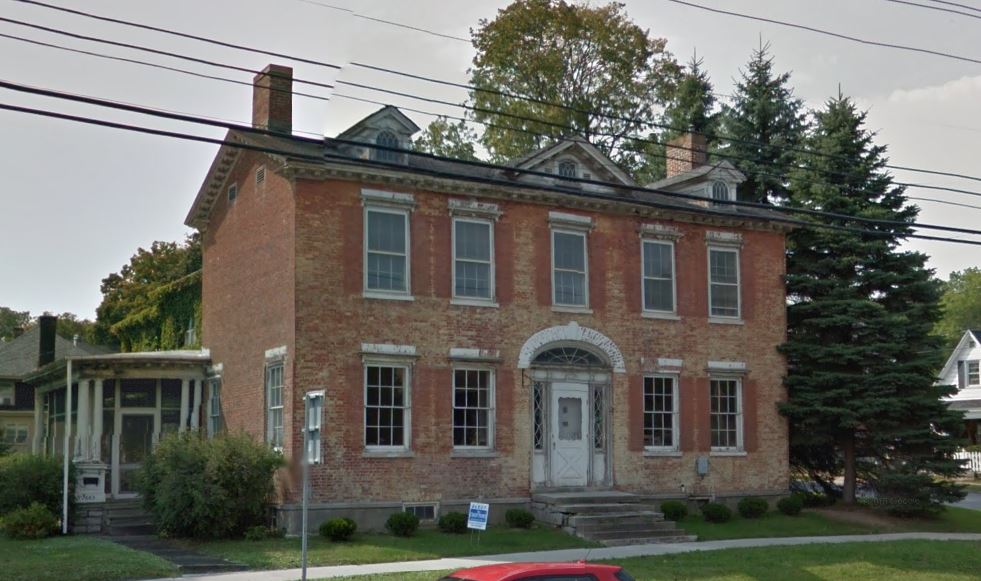
Tlie red brick Georgian colonial residence of Dickinson E Griffith at 254 State Street, Lowville, is one of the most attractive in the north country. It is at the corner of State St and Waters terrace and across State St from Lowville academy. Approximately 133 years ago the main part of the house was erected by Paul Abbott, a tailor, native of Pomfret, Connecticut, who settled in Lowville in 1805. Mr Griffith, present owner and occupant, is general counsel for the J P Lewis company, of Beaver Falls, and subsidiaries, manufacturers of paper and paper and pulp products. Mr Griffith acquired the property January 18 1928 from the estate of V Lansing waters, who died February 8 1914 and who had for a long time been head of V L Waters & Company, Lowville dry goods merchants. Mr Waters had purchased the house and premises from heirs of the Knox family July 10 1882 and after Mr Waters death his widow, Mrs Sarah Waters continued to reside there.
Besides being one of-the most beautiful houses it is one of the most historic in Lowville and was the second brick one to be constructed in that village, the first having been built on Shady avenue on the site of the John Doig residence by Captain Jonathan Rogers. Captain Rogers, native of Westfield, Massachusetts, was a blacksmith who settled there in 1798 and built Lowville's first frame house. On April 20 1801 Nicholas Low, for whom the town and village of Lowville were named, sold the site upon which the present Griffith residence stands, to Captain Rogers and in turn he sold it to Paul Abbott April 27 1807. Abbott bought a piece from Isaac W Bostwick January 12 1810 and added to the rear.
When Paul Abbott died March 19 1831 the property went to his widow, Patty and children, and it remained in the family until September 17 1841 when Merritt M Norton bought it. Norton had been a man of prominence, but he died intestate October 17 1846 and the real estate had to be partitioned to pay his debts. On October 13 1851 it was accordingly conveyed by Mary Jane Norton to Harvey Shull, member of another prominent Lowville family, who transferred it August 24 1852 to Ziba Knox, an outstanding early Lewis county lawyer and statesman.
Native, of Vermont. Judge Knox came to Lowville about 1817 studied law in Isaac W Bostwick's office, became a partner of Charles Dayan, who was a land agent for James D LeRay and Jacob Brown until 1833 state, senator in 1826 and congressman in 1830. Judge Knox practiced law, was a magistrate several years, was long a trustee of Lowville academy and died September 6 1868. His widow, Lucy P Knox retained the home until her death November 21 1881 and the next year it passed to V L Waters, who added Waters Terrace.
Waters also made some changes in the house in the 1890s removing a wooden wing at the rear, building a brick addition and removing a circular stairway to open the front hall into a new stair hall in the new part. Of interest historically is the fact that Paul Abbott had the walls up and was putting on the roof, when word came that the British were invading Sackets Harbor at the beginning of the War of 1812. Dropping his work he left his wife, who was ill with a young baby, and answered the call to arms. Nearly two months later he returned. He was chairman of the building committee of the old academy.
THE HUNGERFORD MANSION—Hidden by shrubbery and tall trees there is a Georgian colonial native limestone house on the south side of Court Street which eludes the notice of the majority of the passing public. Built approximately 130 years ago it was one day one of Watertown's leading mansions, residence of a member of one of this community's leading families. Numbered 335 Court Street it sits far back on a high-terraced lawn and adjoins the east side of St. Patrick's orphanage, of which it is used as the infirmary. It was conveyed to the orphanage November 10 1928 by the Society of St. Patrick's church, which had acquired it with its .78 of an acre of land from Patrick arid Ellen Cotter May 9 1893 and the Cotters in turn had purchased it from Sarah K Jones on February 23 of the same year.
A century ago it was known as the Marcus Hungerford mansion. Born here August 30 1817 Marcus Hungerford was a son of Orville Hungerford, early Watertown merchant, banker and first president of the Watertown & Rome Railroad company, first to tap this north country with a railway line.
Aged but 46 years and five days Marcus Hungerford was a comparatively young man when he died September 3 1863 and little is known of him today even by members of the Hungerford family, but early directories listed him as a speculator and contractor. He was survived by his widow, Sarah S Hungerford, a son, Marcus S Hungerford, and daughter, Helen May of Nyack, and a daughter, Jennie, and a son, Edmund, of Watertown, but his estate was negligible. All of his children were minors when he died. A descendant, Randolph Mann, now resides in Nyack.
The story of the Marcus Hungerford mansion, which has a red brick wing, goes back to Henry Johnson, an early builder who had married Ada, daughter of Stanton Brown, proprietor of a tavern on site of Crowner hotel. On January 17 1822 Johnson bought two adjoining lots from Aaron and Betsey Hildreth of Denmark. On one he built a brick house, which soon became the property of John Mortimer and later of Dr J Mortimer Crawe. It was torn down only a few years ago. Next Johnson built the stone mansion and lived in it until May 17 1833 when he sold it to Henry Smith of Monroe, Michigan, for $2,500. Smith kept it until March 15 1813 when he sold it to Marcus Hungerford for $2,000 but Smith's address was still Monroe and so he apparently never lived in the local house. After the death of Marcus Hungerford his widow retained the place until her death in 1867 and on December 16 1868 her daughter, Jennie A, disposed of her interest to Paul Settle, who kept it only until December 3 1869 when he sold it to his son-in-law, Charles E Jones of Ballston Spa.
Jones had come here to interest himself in the Cataract flour mill, but apparently lived but a short time thereafter and August 6 1873 it was sold to Sarah K Jones by Edgar North as referee in a court action. She retained the property until February 23 1893 when she sold to Patrick Cotter. It is of historical interest that at the beginning of the first decade of Watertown Henry Coffeen had planned to have the business heart of the community in that section. December 12 1810 John M Canfield bought the Hungerford and Crawe lots of Chancey Calhoun and John Hathaway. The Hildreth deed of 1822 describes them as on the southwesterly side of the road leading through the village to the court house.
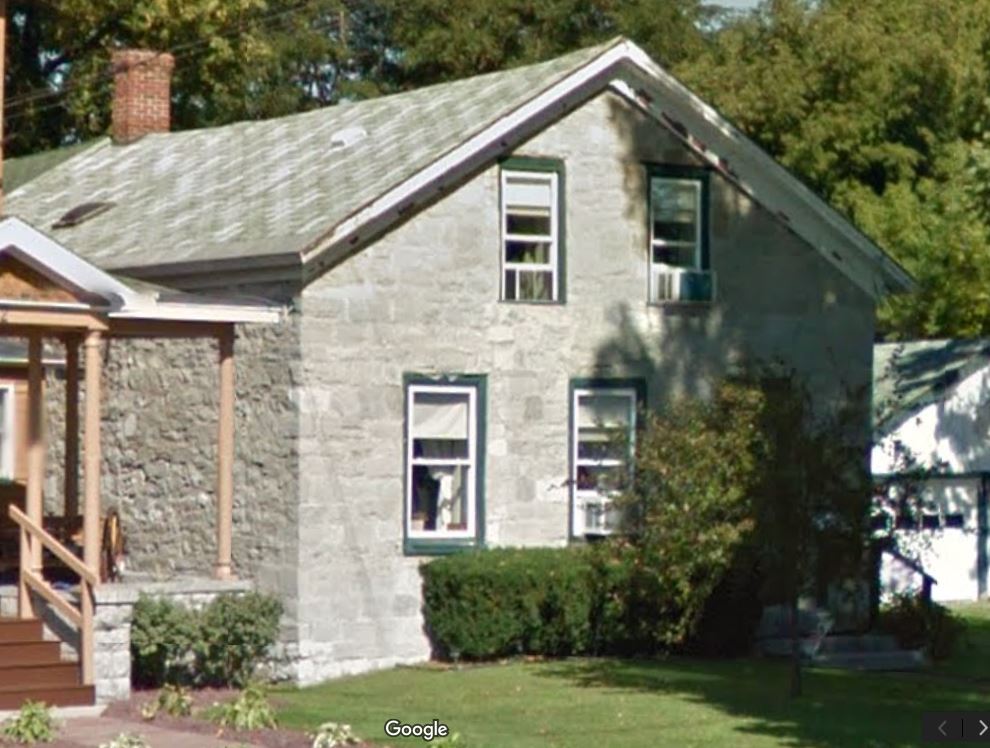
Reminiscent of the days when the village of Brownville was not only a thriving industrial community but promised to become one of the great industrial centers of the North Country is this little native limestone house said to have been built by Thomas L Knap in the 1830's.
Knap, who had come to Brownville in 1829 from New Berlin, NY, to manage the business of his brother, Tracy S Knap, oa July 20 1833 bought of Zebina Gould the land of which the half acre on which this house stands was a part. He paid $200 and probably built the house shortly afterward. He became one of the most enterprising men of the village, building a large flour mill, a tannery, a linseed oil mill and became the manager of the Jefferson Lead company formed June 30 1838. In 1849 he was president of the village and in 1850 supervisor of the town. Later he moved to Pittsburgh, Pennsylvania, to become industrially prominent.
But mingled in the history of the house is another name, that of Charles Smith of Cooperstown, who joined with John A Cathcart and Elizur Fairman to incorporate the Brownville Cotton company, April 6 1831 and take over the cotton factory built by a $100,000 company organized February 9 1814 by John Paddock, John Brown, Thomas Loomis Jr, Thomas J Whiteside and Hoel Lawrence.
It had been thought at that time that Brownville was an excellent place for the textile industry because it was near lake navigation.
December 30 1841 Knap sold this house for $600 to Gideon Tillinghast, a prominent Brownville merchant, who had come from Little Falls, but he and his wife, Diana, sold the property on April 1 1846 to Charles Smith and William H Averill of Cooperstown for $1,300. There is a question whether Smith ever lived in the house, but he gave the use of it to his son-in-law, Frederick W Andrews, who was associated with him in the cotton industry and who was residing there in the 1850s. The cotton factory closed in 1856. January 18 1859 Smith's heirs sold the house to James S Frisbie, another prominent Brownville resident for $1,000. Mrs William Penn Massey another daughter of Smith, joined with Mrs Andrews and the other Smith heirs in that sale. The early records of the Presbyterian church of Brownville show that Smith and members of his family were active.members, and Smith's many bequests to religious societies show that he was deeply active in Christian affairs. January 31 1865 Frisbie sold to Mrs OIney W (Lydia) Randall, who conveyed to John W Ayers March 1 1871 and the same day he conveyed it to George E Hunter March 18 1879 Hunter sold to Kate M Knapp, Sarah E Knapp and Orinda A Knapp Parker of the town of Watertown.
Orinda was the wife of James Parker, militia captain, justice of the peace, several years treasurer of the Jefferson County Agricultural society, whose mother was a cousin of General Sam Houston and whose father, James Parker Sr, native of New Hampshire, fought in the Revolution and died in the town of Watertown January 26 1828. The property passed down through the Knapp and Parker heirs until it came to Fred C Parker, Brownville, and Ralph E Parker, Washington, D C, who sold it March 27 1941 to Michael T McCarthy, and on February 29 1944 he and his wife, Francis D, disposed of it to Mr and Mrs Joseph H LaLonde, the present owners.
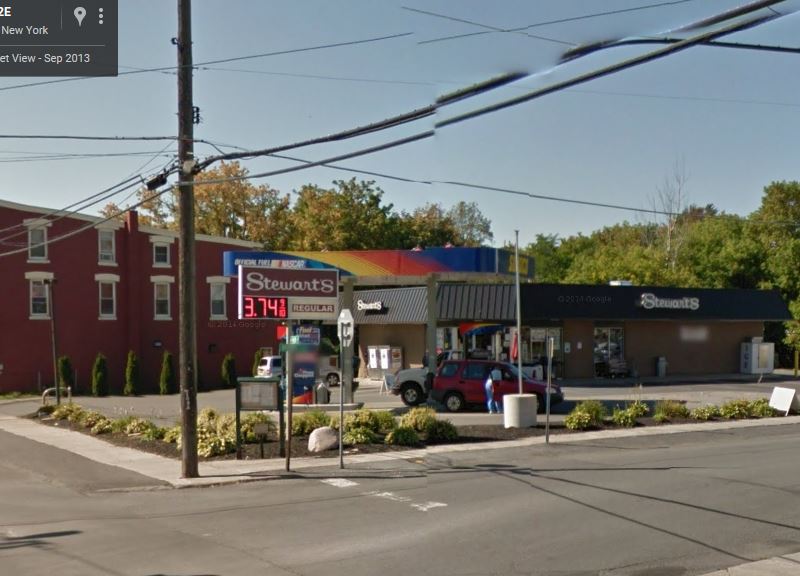
Brownville, one of the oldest communities in Jefferson County, is also
the home of one of the North Country's oldest hotels, the Brownville hotel.
It was built by Henry Caswell and Moody Emerson in 1820 upon land once
owned by Major General Jacob Brown, founder of the town and village of
Brownville, land agent for James D LeRay de Chaumont and hero of the War
of 1812. And the year after this hostelry was erected Major General Brown
became the general-in-chief of the United States army.
This fine old native limestone hotel of three stories stands at the southwest corner of Basin and Main Streets and upon its site the first hotel in Brownville was built, a wooden structure erected in 1805 by Jeremiah Phelps. Upon the east side of Main Street and only a couple of blocks to the northward still stands General Brown's fine old limestone mansion, built only five years before the hotel. It is said that LeRay, friend of Franklin, Washington and Hamilton, stopped at the Brownville Hotel many times with his distinguished guests en route from his mansion at LeRaysville to the beautiful old stone house of his son, Vincent, at Cape Vincent. Doubtless also General Brown and not a few of his notable friends were patrons of the hotel on occasions.
Sylvester Reed was one of the first, if not the first, to operate the Brownville Hotel, and in partnership with William Lord, Hoel Lawrence, Edmund Kirby, James Shields, William S Ely and John E Brown purchased it from Caswell, a Brownville man, and Emerson, a Watertown man, March 30 1831 for $4,191. This syndicate comprised Brownville's leading business men of that day.
Charles P Plumb, another prominent Brownville resident, agreed September 26 1840 to buy the hotel from the syndicate for $4,500 and pay Nancy Swayze $3.50 a year rental for the surplus water led to the hotel by an aqueduct from a spring. Plumb disposed of the property February 1 1849 to Samuel W Fields for $1,197 and September 1 1853 Fields sold it to Lewis Maynard, who held it until March 24 1860 when he sold it to Isaac Hart of German Flats, Herkimer county, for $3,600.
In 1866 Hart sold to Samuel H Gardenier and March 12 1870 his heirs conveyed it to James Patrick. There were a number of other conveyances down through the years until it came into possession of Lettie S Allen, who disposed of it to John A Beach July 21 1918. September 30 1926 he sold to Fred C Wheeler, who operated it a year and deeded it to Frank A McGrath September 13 1927. McGrath sold it June 1 1928 to Margaret Failing of the town of Clifton, who retained it until August 30 1937 when she disposed of it to Harry J Fisher of Brownville, the present owner, for $14,000. While he brought it up-to-date with the installation of many modern appointments and conveniences, it retains the atmosphere and fundamental appearance of the sturdy hostelry that it was a century and a quarter ago. Mr Fisher came to Brownville from Utica and originally was from Little Falls.
33113 County Rt 197 Carthage NY
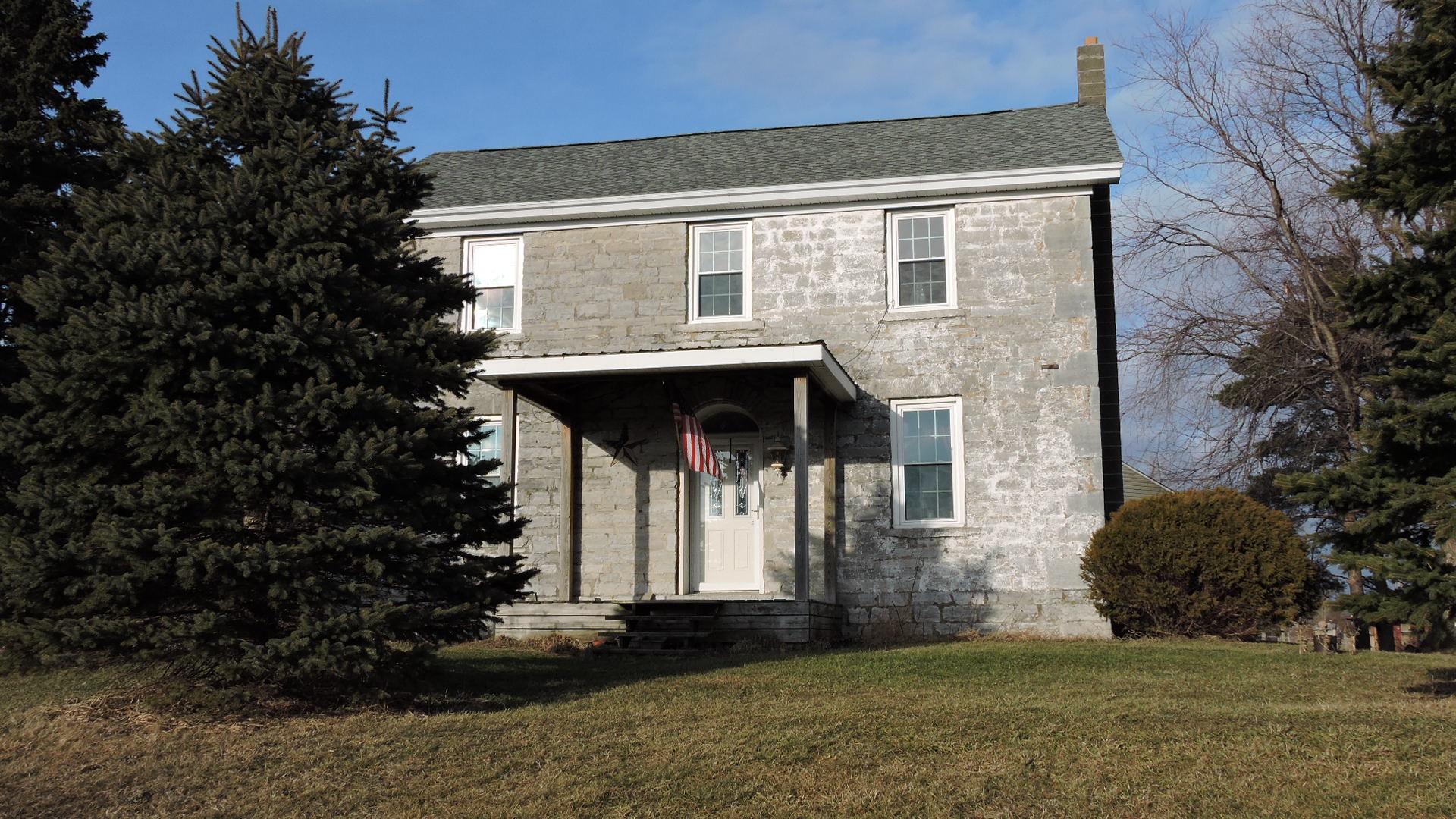
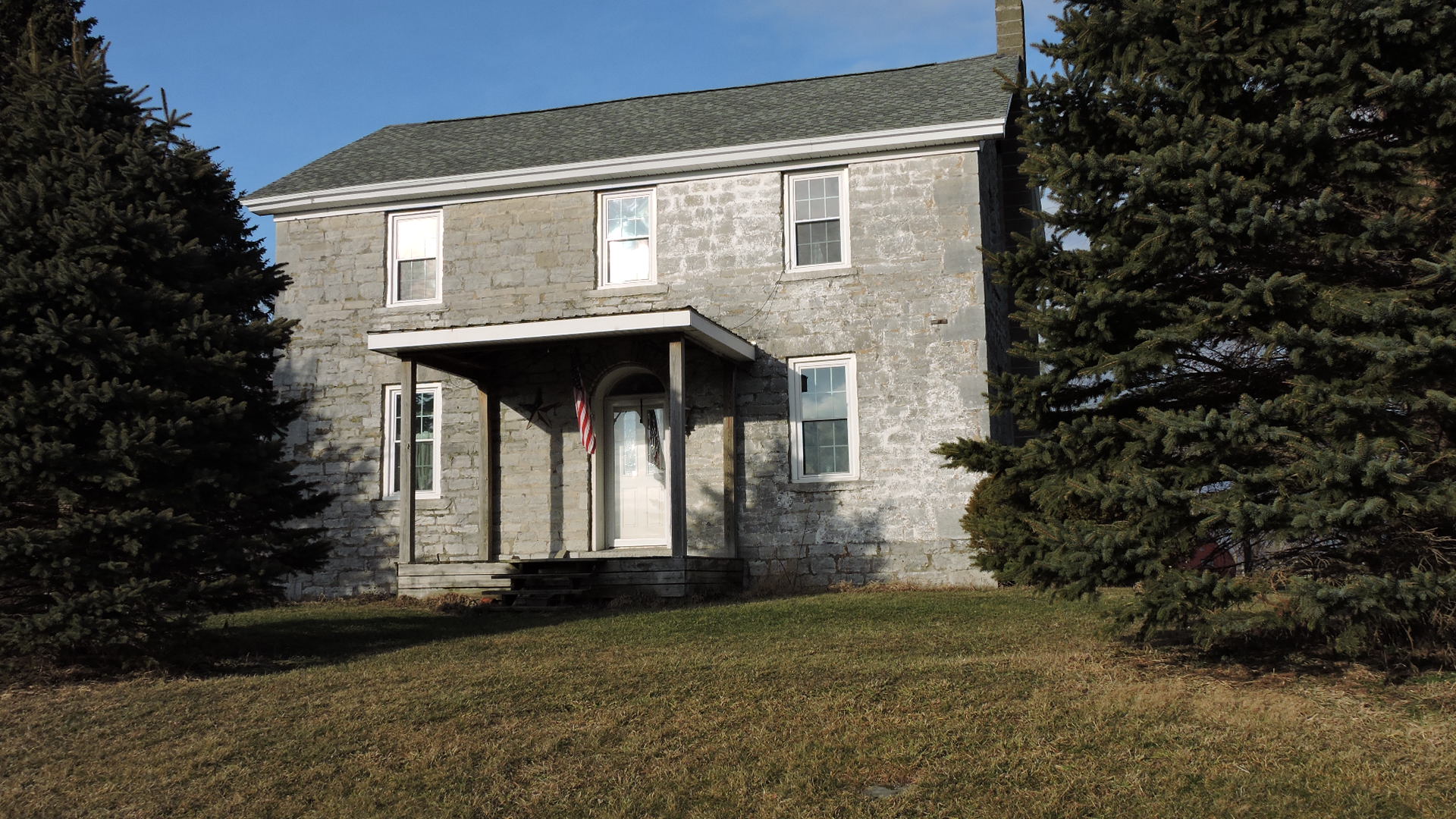
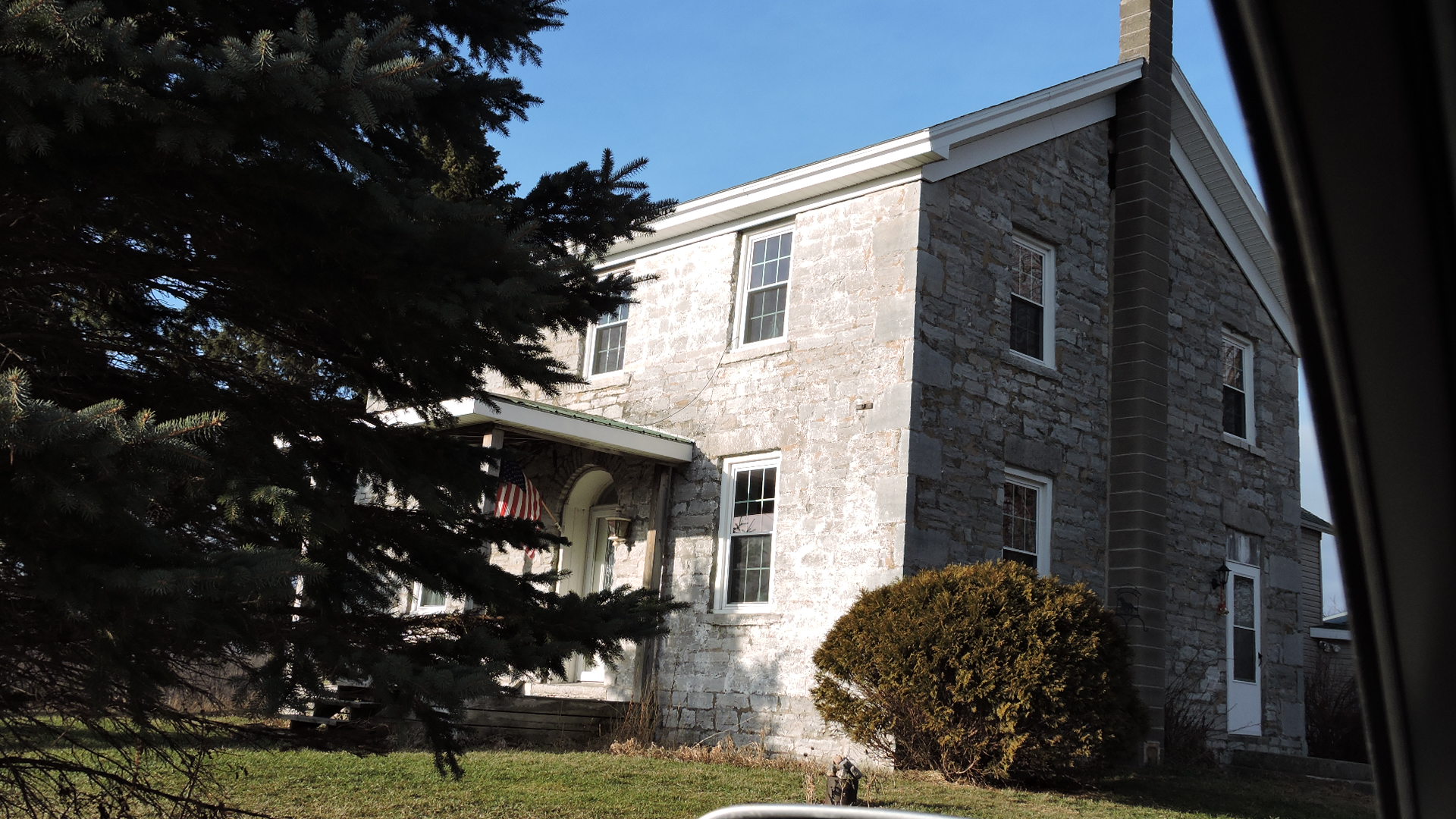
Lewis and Peck are names of some of the first settlers of the town of Champion or of Jefferson County and several members of these two families became substantial farmers in that section of the town which lies between Champion village and the Black River. In fact the modest little limestone house shown today was owned by prominent members of both of these families.
At the beginning of the 19th century Arnold and Eseck Lewis pioneered in Champion and on July 11 1---(illegible) Arnold Lewis sold 100 acres of land on the Champion-Felts Mills road to Eseck Lewis. Eseck later added to this acreage and is believed to have built this house, which is probably well over a century and a quarter old. Eseck Lewis became one of the leaders and one of the most substantial men in the town, serving it as supervisor in 1821 and 1827 and in 1844.
October 29 1853 Eseck and his wife, Hannah, sold the farm, then consisting of about 145 acres, minus about 19 acres devoted to a burying ground, to Alden S Bates for $5,800. Bates retained the property until March 1 1868 when he and his wife, Hannah E Bates, then reported to be residents of the town of LeRay, disposed of it to George A Thompson for $7,425. The farm was then described as consisting of 135 acres less the burying ground acreage. Thompson kept it about ten years and on January 18 1878 he and his wife, Margaret, sold it to Emerson Peck for $6,380.
Excluding the 18.84 acres of the burying ground the farm then consisted of 116.16 acres. Mr Peck and his twin sister, Emily, were born in the town of Champion April 29 1843 children of John Peck and grandchildren of Joseph Peck, blacksmith and armorer of the Revolution at Middlebury, Connecticut, who settled in Champion in 1803.
Emerson Peck never resided on this farm, which he purchased merely as an investment, but remained on the Peck homestead about a mile away. His sister, Emily, however, who married David N Locklin, another Champion farmer, became a tenant upon it and lived there with her family for 28 years from 1878. Emerson Peck, for seven years assessor of the town, for several years treasurer of the Methodist church of Great Bend, added 30 acres to the farm in 1901 and when he died in April 1926 he willed it all to his daughter, Mrs Florence M Morgan of this city. Mrs Morgan, who is a sister of John Turner Peck, a retired grocer of this city, retained the farm until last year when she sold it to Floyd Taylor, who recently is reported to have sold it to Melvin Burke. Thus its ownership has been in the Emerson Peck family more than 66 years.
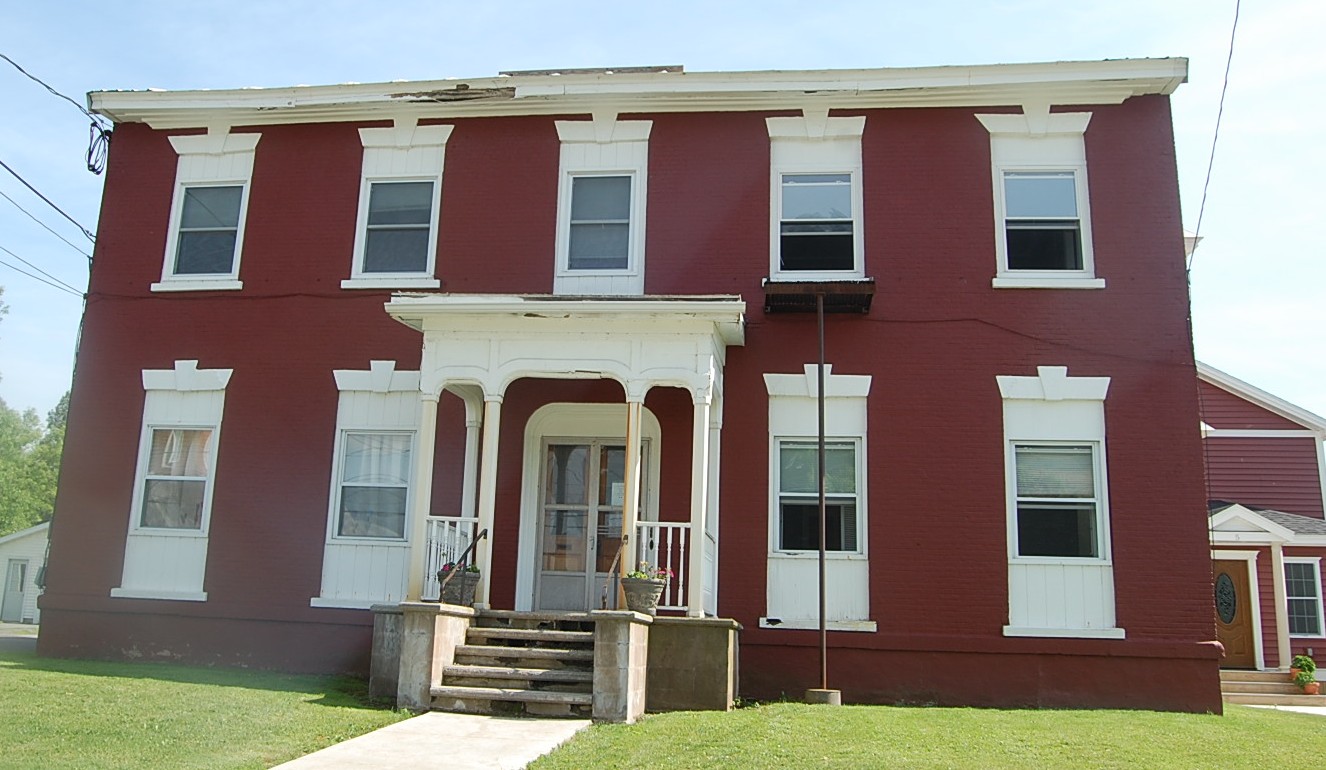
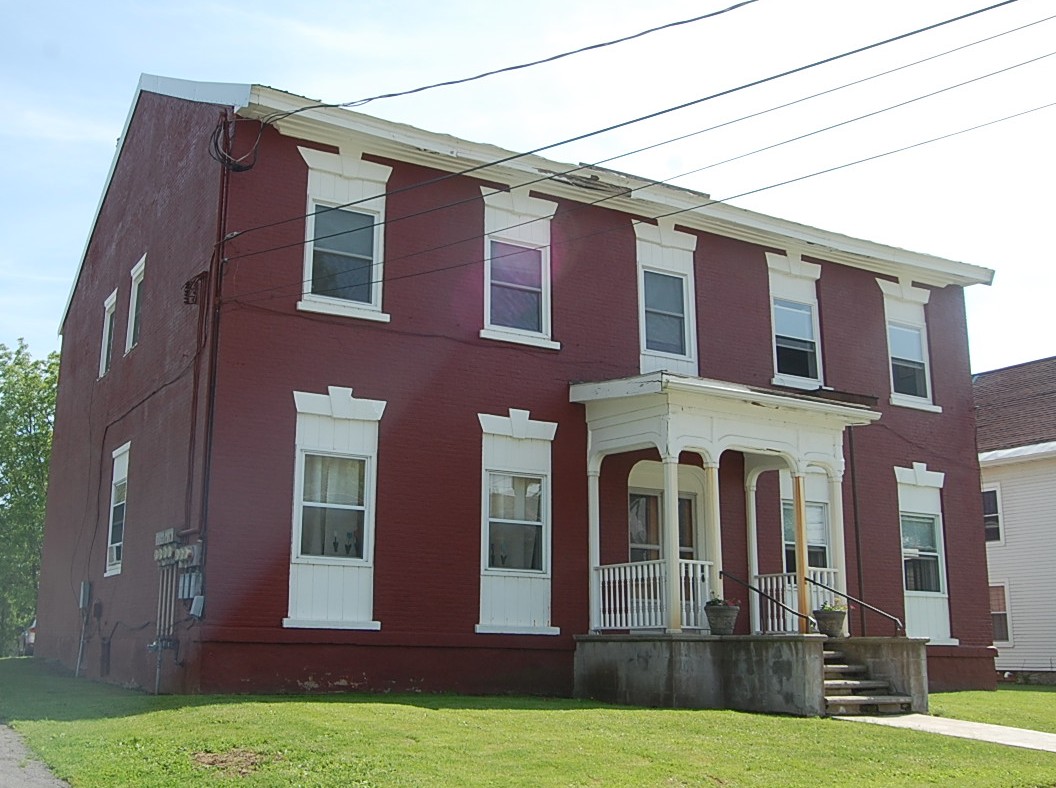
Clarence A Whittier, former mayor of Adams, merchant, farmer, distant relative of John Greenleaf Whittier, the poet, possessor of a veritable museum of fine antiques and historical relics, owns and resides in the red brick Georgian colonial mansion, which is 129 years old and was the first bank building of the Jefferson County Bank the first bank Jefferson County ever had.
Located on the west side of Church Street, referred to in old deeds as
"Meeting House Square," village of Adams, this fine, sturdy
old building is a richly historic structure of a most historic neighborhood.
Besides being the county's first bank building it was used by Jason Marsh
as a school for young men in 1829 and as late as 1856 Reverend M C Manning,
a Baptist minister was teaching a select school there. Prior to the latter
it had been the residence of Robert B Doxtater, merchant and first superintendent
of the Watertown & Rome Railroad, and son of William Doxtater, [corrected
info - David Lane was incorrect stating that WILLIAM was the pioneer]
who was the son of Pioneer Peter Doxtater, first to receive a deed of
land in the town of Adams. Later Eli J Seeber, father-in-law of Mr Whittier,
friend of Theodore Roosevelt and assemblyman from this county's second
district in 1883-4 owned and resided in this house.
Two doors northward is the site of the first church in Adams, the Presbyterian,
and in between it and the old bank Reverend Cuthbert C Frost, present pastor,
occupies the parsonage. Third door southward resided the late Isaac L
Hunt, who was also Theodore Roosevelt's friend, and also was assemblyman
in 1881-2-3. Before Mr Hunt, his father-in-law, W A Gilbert, assemblyman
1850-1, Congressman 1854 owned and occupied that house. Diagonally across
the street resided General Solon D Hungerford, founder of Hungerford's Bank
and of Hungerford Collegiate Institute.
The Jefferson County Bank was incorporated April 17 1816 with John Paddock first president. Jealousy between Watertown and Brownville for location of the bank resulted in the neutral point of Adams being selected. July 6 1816 three-quarters of an acre on the notheast corner of Meeting House Square and the road to Sandy Creek was bought from Joseph P Rossiter for $250 and the brick building erected but by 1819 the bank had proven unsuccessful and December 1 1824 it was sold to William Hart as trustee for those who had contributed to build the building.
So April 22 1833 he sold it under chancery court decree to William Doxtater, who used it as a tenement building for a time, finally remodelling it as a residence for his son, Robert B Doxtater on the latter's marriage. September 20 1837 William and Betsey Doxtater conveyed it to their son together with the stone store on the site where the Doxtater tannery formerly stood for $4,000. R B Doxtater finally moved to Rome and August 1 1852 sold the brick house to William W Nellis for $1,500. April 15 1854 Nellis sold it to Philander Smith, who disposed of it October 9 1868 to Mrs Susan Maxon and on February 6 1900 her executor, Judge Charles H Walts, deeded it to Eli J Seeber for $2,100. Besides having been assemblyman he had been supervisor of Clayton and August 28 1931 died at 93 willing all his real estate to his daughter, Mrs Mary H Whittier, who died December 8 1938. The property is now owned by her husband.
The Jefferson County bank, which opened in Adams in 1817 bought of Noah W Kiniston January 4 1825 for $300 at the corner of Washington and Stone Streets, city, and became a free bank under articles of association October 18 1865 it became the Jefferson County National Bank, which was bought by the Watertown National Bank September 3 1943.
Out on Barnard's Point at Morristown, St. Lawrence county, is the dignified
old Georgian colonial mansion that Lieutenant Colonel David Ford built some time
prior to 1817. With its massive, high, white-columned portico it overlooks
the village and is one of the historic landmarks viewed each year by thousands
of passengers crossing the St. Lawrence on the Morristown-Brockville ferry.
And it was in the house of Colonel Ford that President James Monroe spent
the night of August 1 1817 while on his way from Plattsburgh to Sackets
Harbor during his inspection tour of the nation's military posts.
Today the mansion is owned and used as a summer home by Charles Shepard
Chapman, of Denville, N J, distinguished American artist who painted
the 40-foot panorama of the Grand Canyon of the Colorado in 1939 for the
American Museum of Natural History, besides having won many coveted prizes
for the creations from his brush and palette.
Mr Chapman is himself a native of Morristown, born June 2 1879 son of Henry Augustus and Laura Shepard Chapman, and great-grandson of Augustus Chapman who was associated with Samuel Stocking and James Averill 120 years ago in ownership of most of the town of Morristown. Here Colonel Ford had been the first land agent and original colonizing spirit.
Ford, a native of Morristown, NJ, for which some say the town and village of Morristown were named rather than for Gouverneur Morris, owned at the turn of the 19th century, had started settlement in 1804 and built the first house in the village in 1808. When a St. Lawrence county militia regiment was organized there April 5 1805 Joseph Edsall was named first major and David Ford second major, but through the machinations Of Ford and his brother, Judge Nathan Ford, David Ford was made lieutenant colonel over Edsall in the winter of 1807.
The wrangle over this was carried to the governor and the Council of Appointment. The latter restored Edsall to seniority in 1809 but in 1810 Ford was made the ranking lieutenant-colonel the second time and in 1811 both were dismissed for the good of the regiment. However, when the town of Morristown was formed from Oswegatchie May 27 1821 Colonel Ford was chosen the first supervisor, and all of the time until his death he was an important figure in the Ogdensburg-Morristown section of St. Lawrence county.
His limestone mansion was acquired about 1888 by Henry A Chapman, who had been born in Morristown July 2 1850 and had become one of its most popular citizens. For several years he was a village trustee, he was a generous contributor to churches, schools and civic organizations, had operated a paper mill four years and became one of the founders of the First National Bank of Ogdensburg. In 1874 he had married Laura Shepard and they had three sons, Henry Hooker Chapman, Charles Shepard Chapman and George Augustus Chapman. Charles S Chapman, present owner of the house, studied at Pratt Institute and Chase's Art School. May 16 1911 he married Miss Adele Blanche Ahrens of Leonia, NJ. His paintings have been hung in the National Academy of Fine Arts, Carnegie Institute, Corcoran Art Gallery, Art Institute of Chicago and Buffalo Academy of Fine Arts .
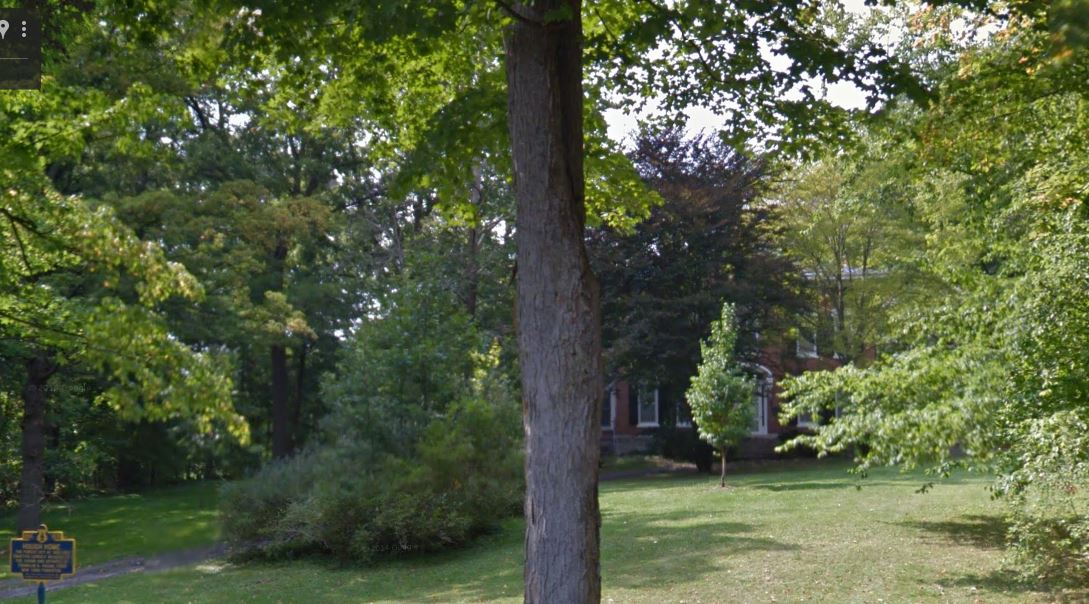
Dr Franklin B Hough, noted historian and physician, was born in the town of Martinsburg, Lewis county, July 20 1822 and died in Lowville July 11 1885. The large red brick mansion, which he caused to be built about 85 years ago upon high ground rising up from the west side of hilly Collins Street in Lowville was owned and occupied by him for the last 25 years of his life. It is only half a block from Dayan Street, that main Lowville thoroughfare which leads to Watertown.
Never has it been out of the family since his death and today it is owned by his granddaughter, Miss Marjorie Galloway Hough, graduate of Elmira college for teachers, and author, among other things, of a history of Lowville academy.
Upwards of two acres of land constitute the grounds bordered on either side by high cedar-hedges. Many trees, sugar maples, elms and conifers stud the front lawn. The street walk in front is of red sandstone flags and from the street a winding drive threads its way to the south side of the big mansion. Near the street is the iron marker erected by the New York state education and conservation departments in 1935 which states: "The Forest Act of 1885 was enacted largely because of the vision and efforts of Franklin B Hough, first New York forester."
The mansion is tall and stately and its large rooms are high. It is not of colonial design but more of the Queen Ann type and within it Dr Hough housed a library of about 15,000 volumes. The site was bought May 19 1860 from Giles C and Esther A J Easton by Dr Hough for $500 when he returned to the North Country from Albany, and some years before that it had been owned by Maria C Collins.
Descendant of a long line of New Englanders, the first of whom was William,
the immigrant ancestor, Dr Hough was born on a farm near Martinsburg village,
son of Lewis county's first physician, Dr Horatio Gates Hough and Martha
Pitcher Hough. Franklin graduated from Lowville academy at 14 attended
the Black River Literary and Religious Institute in Watertown, was graduated
from Union college in 1843 and from Western Reserve medical college in
1848 practiced at Somerville from then to 1852. He went to Albany that
year to index historical papers of the state; supervised the first state
census in 1855 and also that of 1865. He had charge of the federal census
in the state in 1870. In 1872 he was appointed to investigate possibilities
of a forest reserve. On August 30 1876 he was made federal forestry agent.
He toured European forests in 1880. He started the American Journal of
Forestry in 1882 published the first forestry textbook, and in 1885 drafted
memoranda for New York state's original conservation law. In the Civil
war he was surgeon of the 97th New York Infantry.
Of the 78 works he published, first was a list of Lewis county plant life in 1846. In 1852 he started "History of St. Lawrence and Franklin Counties" and completed it in 14 months. He brought our "History of Jefferson County" in 1854 and "History of Lewis County" in 1860. He also published "History of the Thousand Islands." First he married Maria S Eggleston. His second wife was Mariah E Killam. He bought his first real estate, farm land in Martinsburg, June 18 1844 of his brother, Horatio. Romeyn Beck Hough, son of Dr Hough, was curator of birds and mammals at Cornell university. At 19 his collection of birds was exhibited at the Centennial Exposition, Philadelphia, 1876 and in 1893 he had charge of New York state's forestry exhibit, Chicago. He was author of the 15-volume American Woods, and also the Handbook of Trees. He died September 2 1924. His son, Lieutenant Colonel Romeyn B Hough Jr, was brother of Marjorie G Hough, and was librarian of the Army War college, Washington, DC, and died December 22 1942.
33490 Co Rt 3 Carthage NY
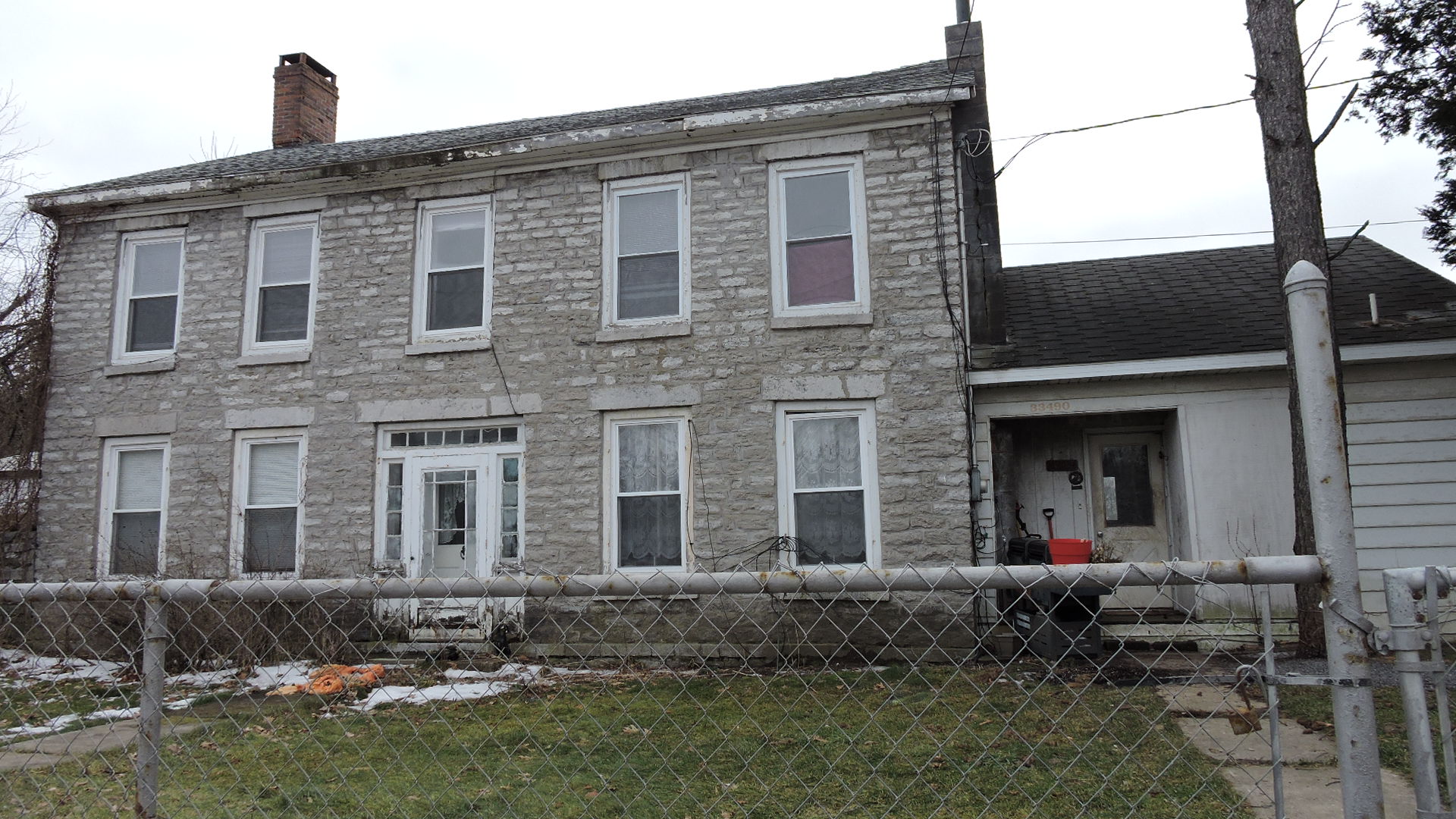
An unusually well-styled native limestone house of Georgian-colonial architecture occupies a sightly location on the south side of the Watertown-Carthage state highway a short distance beyond Great Bend toward Deferiet. Its history is elusive but it is known to be over a century old. Orson Stewart, a native of Grand Isle county, Vermont, bought it March 1 1855 for $3,325 from Daniel and Sarah Ann McNeil, William J and Lovina Bentley and Daniel and Almira Potter. Potter, a native of Connecticut and one of the prominent business men and promoters of Great Bend and that region of the town of Champion in the fore part of the last century, had acquired it of John Stevens August 28 1846 but when his financial affairs became such that he was compelled to assign his heavy real estate holdings to McNeil and Bentley January 10 1855 this was included and shortly afterward Stewart bought it. While verification is not readily obtainable it is understood to have been owned by William J Clark about 1835.
A lover of fine horses, Orson Stewart who was also an ardent Whig became one of the first members of the Republican party in Jefferson County. He was a son of James Stewart, a Vermonter who came to Champion in 1812 and soon took up land at the bend of the Black River near Great Bend. This James cleared and there he died February 22 1835 at the age of 63. Orson Stewart married Sophronia Maria Clark, daughter of William Clark who had come to Champion from Clark's Hill, Chatham, Connecticut, in 1835. Clark was a Whig and Unitarian and settled in the Great Bend area near Martin Street. Thomas Nelson Stewart, son of Orson, grew up in the stone house from the age of eight and eventually bought it September 17 1896 from Minnie M Stewart, adding to its acreage. He was a Republican, a constable for two years and was active in the Great Bend grange. In January 1867 he married Minnie Slack who died a year and a half later and in 1871 he married Mary Chard, who died in 1895. He next married Olive Hubbard who also pre-deceased him and July 29 1911 he sold the house and farm to William Wallace Olds, whose estate retained it until recently when it was reported to have been sold to Harold Lewis of Great Bend. The house is attractively planned, has a fine front door and doorway and possesses excellent possibilities for restoration to its original grandeur.
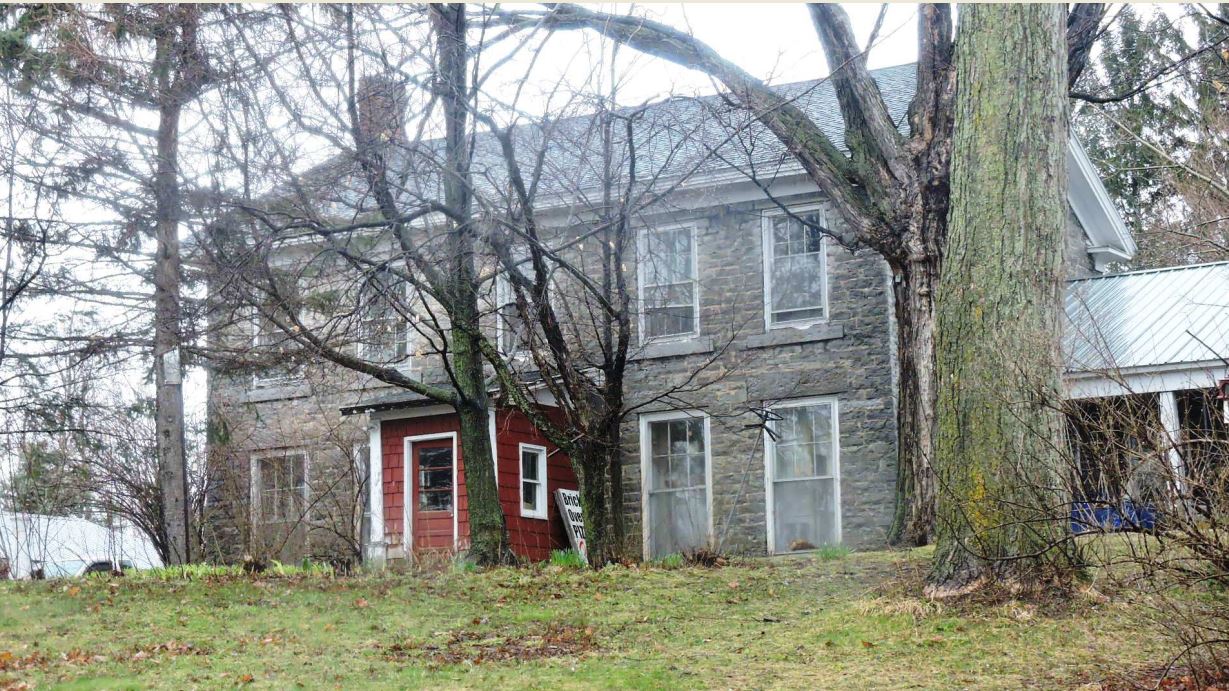
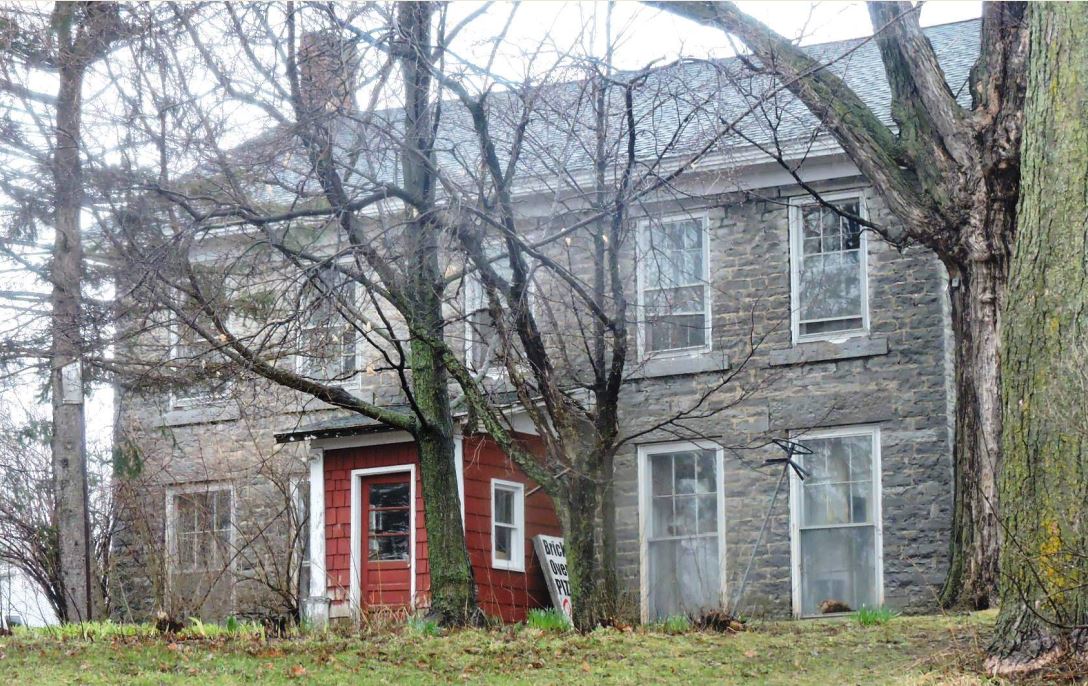
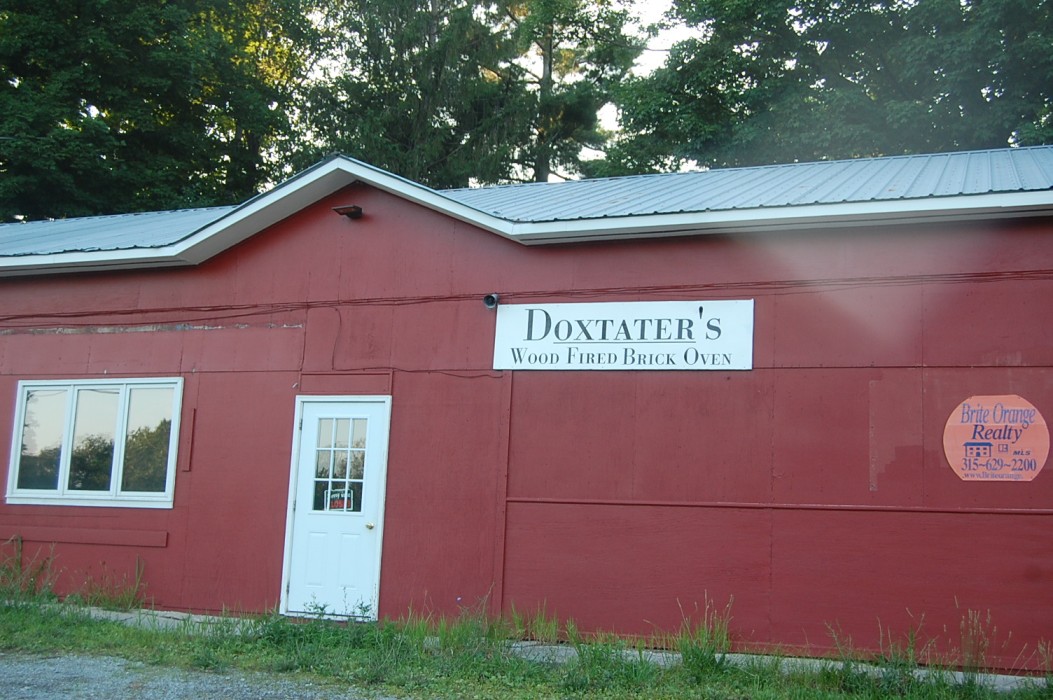
Along the historic old Military road that swings through Pamelia Four Corners on its way northward to Plattsburgh after having started out from Sackets Harbor are many fine old stone houses, but none is more beautiful as to design or setting than that of William E Rogers just across the road from the old Methodist church. Like so many of the old stone houses of this North Country it is of Georgian colonial type, broad and impressive with its original small-paned windows retained and its beautiful front entrance set squarely in the middle of the body of the house. The blue limestone, of which it was built, was quarried near the house and laid up by skilled craftsmen into the structure, which was once the grand mansion of Charles G Harger. The date of its building was probably about 1839 the year that Harger, then a young man of 29 had purchased a lot of 28.9 acres of land from Washington Coster, a north country land speculator from New York City.
A graceful drive sweeps from the highway in the arc of a circle to and past the front door, which is well back from the road, and through the lush foliage of dignified old maples the sun is filtered into artistic splashes arcoss the facade of the big house. The Harger family played a leading role in the development of Pamelia Four Corners. In 1837 Abrarn M Harger was its second postmaster and in 1850 was supervisor of the town. Charles G Harger was a leading merchant and meat packer, whose products went to Sackets Harbor and then by ship to Montreal and other markets.
It is said that he had high hopes for the future of Pamelia Four Corners until the railroad came through in 1854 and failed to make it a station point as he had wanted. So on September 1 1859 he and his wife, Maria Irene, sold his mansion property to Walter Fox, who was also a merchant. Mr Fox kept the property until October 10 1866 when he sold it to Jacob H Markell of St. Johnsville for $5,500 or $1,250 more than he paid for it. Markell and wife, Catharine F, also received $5,500 for it from Anthony F Sheffner, father-in-law of Mr Rogers, March 8 1871.
Mr Sheffner was one of the leading merchants of the Corners, operating what was known as the Grange Store and when he died in 1911 he willed the mansion property to his daughter, Mrs William E (Etta S) Rogers. Mrs Rogers died November 13 1938 and her husband, a resident of the place for nearly 60 years, continues to operate the farm, engaging extensively in the poultry business.
Charles G Harger, after leaving Pamelia Four Corners, came to this city and in 1866 established the Charles G Harger & Son bank at 5 Court Street where the Flatiron building now is, but this was closed after ten years and for the next dozen years he lived on a farm seven miles from Theresa. Eventually he moved to Theresa village where he died January 29 1901.
Log cabins built by early North Country settlers were always picturesque affairs and that of Matthew Moore and his wife, Mary McCarthy Moore, in the Jingleville district of the town of Canton, St. Lawrence county, was no exception. Symbol of the hard-bitten, primitive life of the pioneers, this particular cabin was built about 95 years ago upon the 40-acre tract of St. Lawrence county farm land, which Matthew Moore and his wife had laken up shortly after their coming to this country from County Cork, Ireland, to begin life anew in the land of promise and freedom.
The logs were cut upon the site, notched at the ends and joined, the bark being left on. It was the customary story-and-a-half affair with small-paned windows and the roof was covered with shingles, the broad chimney of common red brick protruding through the ridge of the roof near the rear gable. At first there was a flat-pitch to this roof, but later it was elevated to give more room in the loft, at the same time adding to the attractiveness of the little building, which has been down and disappeared from the scene many years ago.
This was the original home in this country of Mr and Mrs Matthew Moore, their two sons and four daughters and in it also was born one of their grandsons, John A Finnigan, editor and publisher of The Commercial Advertiser, Canton. Two of the daughters of Matthew Moore were Hannah who married James Finnigan and Mary who married Michael McCormick. James and Hannah Finnigan were the parents of John A Finnigan and among the children of Michael and Mary McCormick was Henry J McCormick, Syracuse, formerly of this city, who has long been a legal adviser for the Central New York Power corporation.
Mr Finnigan, who on September 9 will finish his 49th year as editor and publisher of Canton's Commercial Advertiser, one of the finest weekly newspapers in the east, spent his early years in this cabin. When he was four years old, he removed with his parenls to a place on the Gouverneur road near Canton and at the end of another four years returned to the log house for a year. During that year Editor Finnigan attended the little Jingleville school in School District No. 3 which was one of the first in the township of Canton. From the log cabin, when he was a lad of nine, he removed with his parents lo the frame house that had just been built about a mile away on the present Wesley Rich place on the Jingleville road.
When The Commercial Advertiser's editor and publisher was born, the log cabin domicile of his birth stood on a lane, which tapped the public highway, but later a road was put through to connect with the road to old Jerusalem Corners located between Dekalb Junction and Canton. This road is now abandoned and although the right-of-way still exists it is impassable to motor traffic.
It was in the years after the Finnigan family removed to the frame house that John A Finnigan concluded his preparatory education by graduating from the Canton Union school and then he matriculated at St. Lawrence university, where he received his sheepskin in the class of 1893. In the case of Mr Finnigan his early education came before preparatory schools were known as high schools and for him the Canton Union school served in the same high school capacity, providing the groundwork for his admission to college.
Next he was principal of the Parishville school for a year and from the summer of 1894 to September 18 he studied law in the office of County Judge Ledyard Hale in Canton.
The Cuban insurrection had broken out in 1896 and for three months during that summer Mr Finnigan was in Cuba as a war correspondent. The Cuban leaders were creating quite a spirited war against Spain and Mr Finnigan was a contemporary of such famous writers as Stephen Crane, Walter Wellman and Fitz Hugh Lee, but some of his dispatches fell into the hands of General ("Butcher") Weyler, commander of the Spanish forces and Weyler caused him to be ejected from Cuba.
Mr Finnigan had gone into The Commercial Advertiser office September 9 1896 as local editor and partner of J D Tracey, the partnership becoming Tracey & Finnigan. Mr Tracey died in October 1897 and Mr Finnigan to take over complete charge of the paper. Mrs Tracey died March 1900 and Mr Finnigan became sole owner of the paper assuming full title as editor and publisher. From 1896 to date Mr Finnigan's journalistic record has been a notable one.
But notwithstanding it all Mr Finnigan is fond of recalling his log-cabin days when that cabin was on a lane off the traveled highway. And he also recalls that following the Civil war his Grandmother Moore had removed to Canton village where she had a home on Gouverneur Street, at which home he earned his first $5 as a boy in his teens painting his grandmother's white house, a house today part of a larger dwelling.
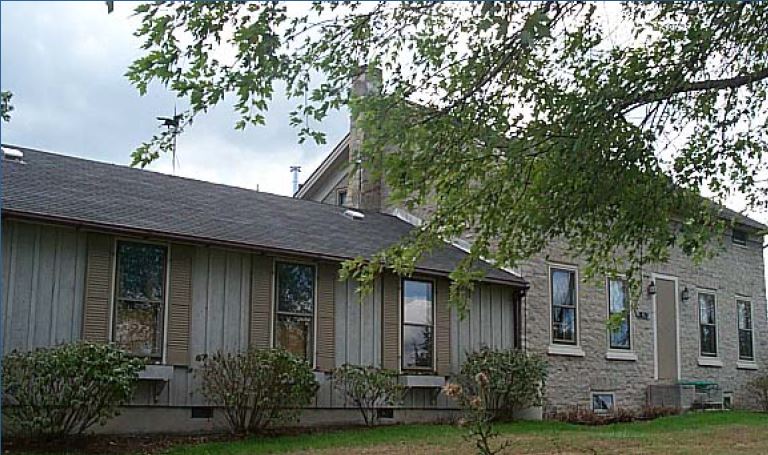
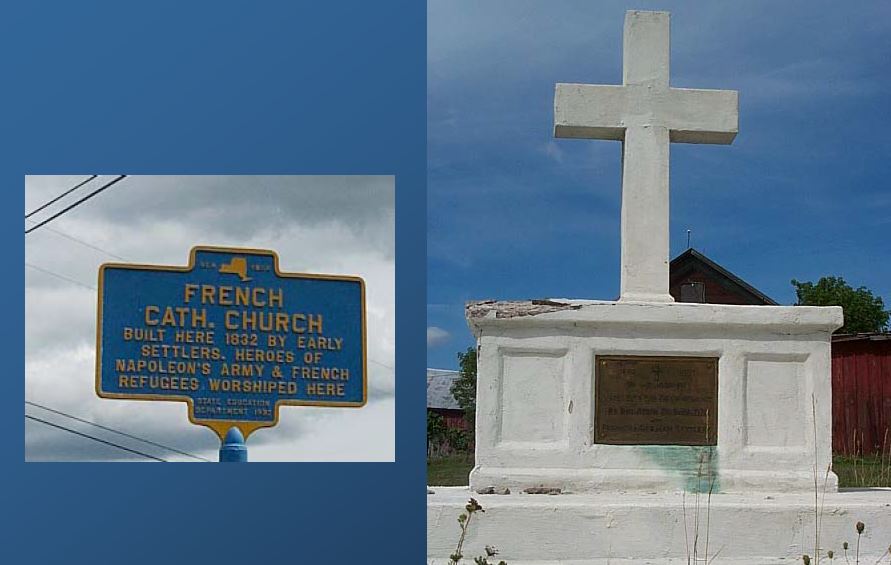
Stone houses abundantly dot the town of Cape Vincent and several of them are to be found in the Rosiere and French Settlement district. Here in the 1830's through the influence of James D LeRay de Chaumont came a number of Roman Catholic settlers from both France and Germany to take up farms. They were sincere, hardworking people and became substantial citizens of this country.
One was Joseph Wiley, a widower from Germany, who came in 1832 bringing
his children with him. He erected a log house. One of his children was
Ignatious, a skilled stone mason by trade and about 1847 the log cabin
was replaced by the plain but attractive limestone house shown above.
This house, which is just off the old Cape Vincent turnpike and not far
from Rosiere, consists of ten rooms. Some yards away from the front of
the house flows Kent's creek and from the creek bed came the stone used
in building the house. Not far away the town's first grist mill was built
on the banks of this creek in 1809. Ernest G Wiley, prosperous farmer
and owner of the house and its 208 acres today recalls that his grandfather,
Ignatious, the stone mason, was a giant of a man weighing 260 pounds and
standing six feet four inches tall. He had not been long in the town when
he was called upon to build the-old woolen mill in Dexter. Another example
of his workmanship was the fine old Alfred Dezengremel stone house in
the Rosiere area and in 1865 when Antoine Duvillard planned the big stone
grist mill on the shores of the St. Lawrence in the village of Cape Vincent
Ignatious Wiley was selected to do the stone work.
At the present time this building is the federal fish hatchery and has been since July 1895 when George Grant sold it to the government, having purchased it in January of that year to make such disposition of it. Ignatious Wiley died July 2 1886 and willed his property to his children. His son, Frank Wiley, eventually became the owner of the farm and its old stone house.
He operated the farm for several years. He was born in the town of Cape Vincent October 4 1847 about the time the house was erected and his first wife was Mary Ellens.
One of their children was Ernest G Wiley, present owner of the property. Frank Wiley died July 31 1933 and under the provisions of his will the house and farm went to his son, Ernest. In the early history of the property there was also a stone barn, which Ignatious had onstructed, but this was built over by Frank Wiley about 1894 and only the stone lower part was retained in that reconstruction. Ernest Wiley relates that his grandfather was the builder of the Catholic church in the village of Cape Vincent. It was another monument to his skill.
111 Washington
Called the Arthur Walrath House on another site, on the National Register of Historic Places
Two small, simply-designed native limestone houses stand side by side
on the East side of Washington or Church Street just north of the railroad
tracks in the village of Brownville. Both are of a vintage of about a
century and a quarter ago, and one of them owned by Mark Twain Barrett
was early the home of Thomas Loomis Jr who was one of the trustees of
the cotton company formed in Brownville in February 1814. The other, fast
to the north of it, now owned by Mrs Estella M Walrath whose son, Landscape
Gardener Arthur M Walrath has his attractive flower gardens at
the rear, was the home of Luther Gilson. There is a tradition that the
two houses were built at the same time, about 1815-1816 when the General
Jacob Brown mansion was erected.
Luther Gilson, a man of prominence in the early history of Brownville, later moved to Watertown and on January 2 1835 paid $3,000 of Micah Sterling for the "Mansion House," a two-story stone hotel, which Sterling had erected in 1826 on the north side of Public Square about where the W T Grant store now is. Gilson died January 29 1839 and the next year Norris M Woodruff, first owner of the Woodruff hotel, acquired the property.
February 10 1821 Gilson gave Judge Brown $193.12 1/2 cents for 23 perches, over half an acre of land, which bordered the north line of the property of Thomas Loomis Jr. The price paid by Gilson would seem to indicate that he built the stone house upon the site about that time, for on June 10 1826 he and his wife Mehitabel sold the house and lot lo Charles Smith of Otsego county for $1100.
Smith, John A Cathcart of Rochester and Elizur Fairman took over the cotton mill in 1826 the same year Smith purchased this house, and then reorganized the company. March 7 1827 Smith sold the house to Cathcart. When Brownville village was incorporated April 5 1828 Cathcart became the first village treasurer and his house undoubtedly remained in his family several years for February 16 1869 William A and Laura Cathcart of Bay City, Michigan, sold the property to Mrs Sophronia Norton for $2,000. John A Cathcart had been a Rochester merchant before coming to Brownville and also operated a general store in Brownville, which he left to his son when he died in 1852.
Sophronia Norton disposed of the house to Hiram Holcomb of East Bloomfield, NY, April 1 1876 for $1,950. Holcomb was vitally interested in the textile industry and came to this city early, playing an important role in the organization of the Watertown Cotton Company and the Watertown Woolen Company. On November 29 1898 J S Hamlin of East Bloomfield, as executor of Holcomb's estate, sold the little Brownville stone house to Mrs Jane Walrath, who held it until January 10 1901 when she conveyed it to Merlon A Walrath and his wife, Mrs Eslella M Walrath. Upon Mr Walrath's death a few years ago the title to the property lodged solely with his widow the present owner. Her son, Arthur M Walrath, is now engaged upon an excellent job of restoring the interior, and plans to remove the unharrnonious front porch and restore the exterior at a later date
Of the pillared, two-story portico houses in Jefferson County that at 136 South Massey Street, is an interesting type. Further interest is lent to it by the fact that for a quarter of a century it was the residence of Mrs Catherine C Brockway, widow of Beman Brockway, founder and long editor-publisher of The Watertown Daily Times. Mr Brockway, one of the outstanding newspaper editors of his time in the state, intimate friend of Horace Greeley and of Gov. Reuben E Fenton, died December 16 1892. He resided at 56 Arsenal Street, a little westerly of the Grand Union super-market. The following spring, March 4 1893 Mrs Brockway paid $5,000 to Mrs Hatlie O Phillips, wife of Lewis F Phillips, and resided until her death September 23 1918 in the pillared house, her daughter by a prior marriage, Mrs Sarah E Allen Banister, residing with her.
A native of Scotland. Mrs Brockway, who was originally Miss Catherine Campbell, first married John C Allen and was widowed. In the spring of 1892 she became the third wife of Mr Brockway, his first two wives having died several years apart. Mrs Catherine Campbell Brockway left only her daughter, Mrs Banister, as her heir and Mrs Banister survived her mother only three weeks. She died October 12 1918. John F Maloney as her executor sold the house to Mr and Mrs Fred B Marshall, who retained it until about a year ago when they sold it to Gerald L DeLancett.
Stephen Boon, one of the city's early house-builders, for whom Boon Street was named, built this house nearly 100 years ago. He purchased the lot from Esther Bragg of Newport, NY April 15 1847 for $200 erected the house and November 18 1852 disposed of it to Harlow Scovil, carriage manufacturer whose shop was about where the Chamber of Commerce building now is. The Scovils resided there about a dozen years, Mr Scovils wife, Alzina, selling it to John Budlong March 14 1865. Mr Budlong conveyed it to Delia A Moore August 21 1867. After that there were two or three transfers until Mrs Phillips acquired it October 28 1884 from Sidney and Rosette F Cooper.
Before Esther Bragg owned the lot it was a part of the Benedict property, she having purchased it as part of a five-acre tract between Arsenal Street and Hart Massey's land for $500 from George A Benedict of Cleveland, OH, Harriet A and Amelia C Benedict of Watertown. The Benedicts, members of a wealthy early Watertown family for one of whom Benedict Street was named, had earlier purchased the plot of land from Oren Stone. The design of the house was undoubtedly conceived by Mr Boon, who is said to have had such a natural ability in that direction that he took a chair upon a lot, sat down and without any drawings directed the excavators to dig the cellar so many feet this way and a certain number of feet the other way. Then the cellar wall was built and up rose the structure, usually attractive in appearance
Placed about 200 feet back from the east side of South State Street in the village of Turin is an attractive native limestone house, said to have been constructed by Ethan Perry, a Turin tannery owner, in 1842. Located as it is upon a large site with fine old shade trees in front, it possesses many possibilities for a country residence, and Mr and Mrs Francis Sliter, present owners, have planned a restoration of unused fireplaces and other original features.
Built of Trenton limestone quarried near Lyons Falls the eleven-room house with fine front entrance bordered by rectangular transom and sidelights displays not only a fine quality of stone but excellent craftsmanship in its two-foot thick walls. There is a capacious central hall with a stairway equipped with a beautiful rail and slender, graceful spindles. This stairway leads to two second-story landings. Over the front door is a capstone ten feet long and two feet thick wtih keystone carved in two-inch relief in ils middle. The interior woodwork is unusually good and originally there was a fireplace in each front room, while the service fireplace in the kitchen is large and supplemented with brick oven.
Suffering financial reverses Ethan Perry sold the property to Anthony W Collins April 1 1846 and went to California during the gold rush of 1849. Born February 10 1797 Anthony Collins was the son of Jonathan Collins, a Revolutionary veteran who had just come from Connecticut and became a man of prominence in this North Country. November 20 1804 Jonathan was chairman of the Denmark convention which voted to set off from Oneida the twin counties of Jefferson and Lewis.
From 1809 to 1815 he was first judge of Lewis county and in 1820 was a presidential elector. Jonathan Collins' brother, General Oliver Collins of Oneida county served on the frontier during the War of 1812. Anthony W Collins lived in this house until his death May 17 1870. Wayne Collins, son of Anthony Collins, later occupied the house and sold it to Charles S Gsell who remained there 20 years. Wayne Collins had a son, Charles W Collins now residing at Pittsburgh, Pennsylvania.
J Edgar Jones succeeded Gsell as owner of this property and lived there several years, ultimately removing to California. After Jones the owner was Emmett R Rupert, and he was followed by W Carl Jackson and Willis O Higby.
Charles W Collins is authority for the statement that originally there were many trees about this beautiful old mansion and that at one time as many as a hundred maples were tapped in the making of syrup and sugar. Most of these are now gone, but a line of stately old trees still borders the front of the lot along the street, which is part of the main state highway from Watertown to Boonville and Utica. The mansion is one of the most attractive of the many in Lewis county.
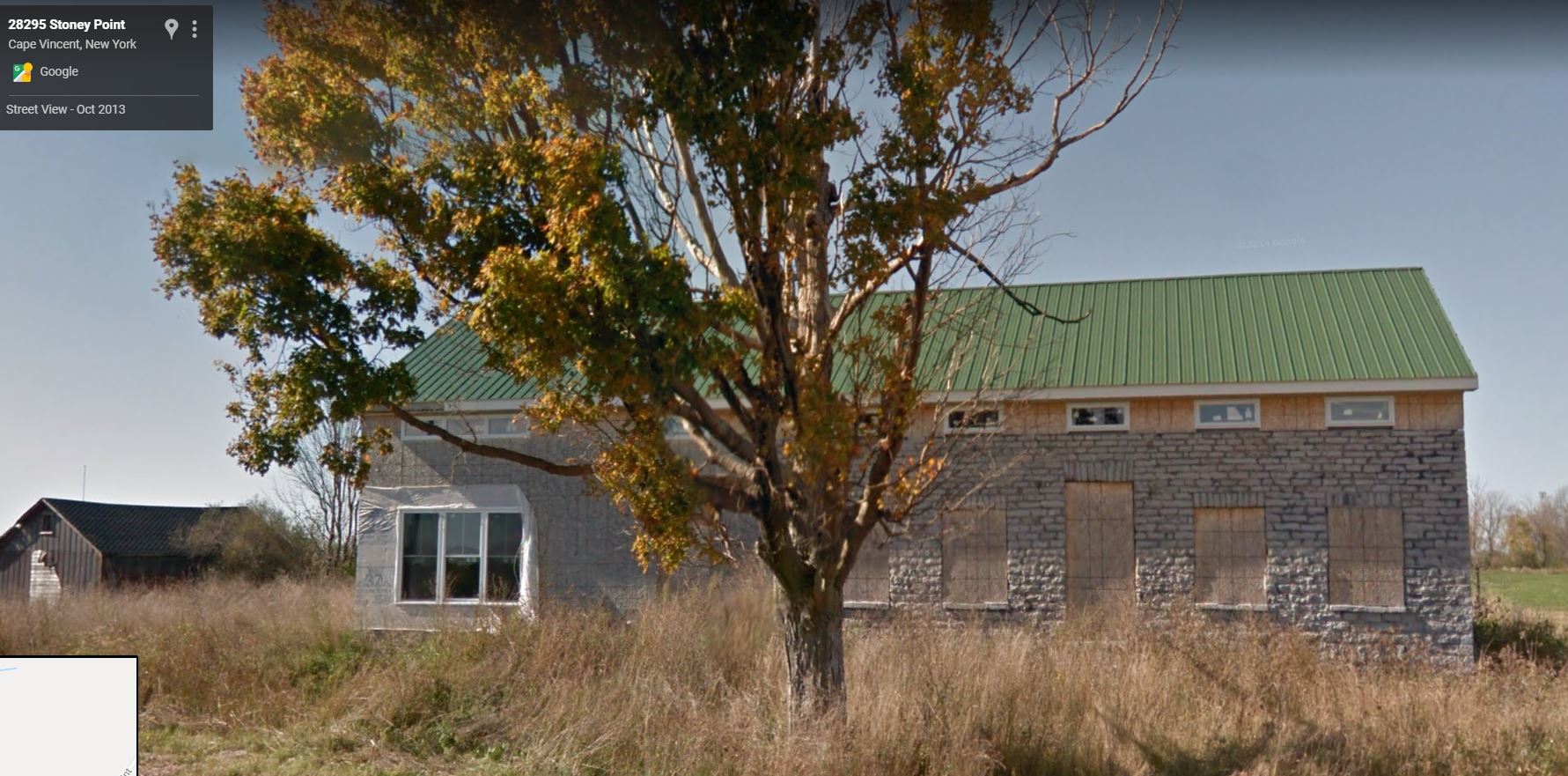
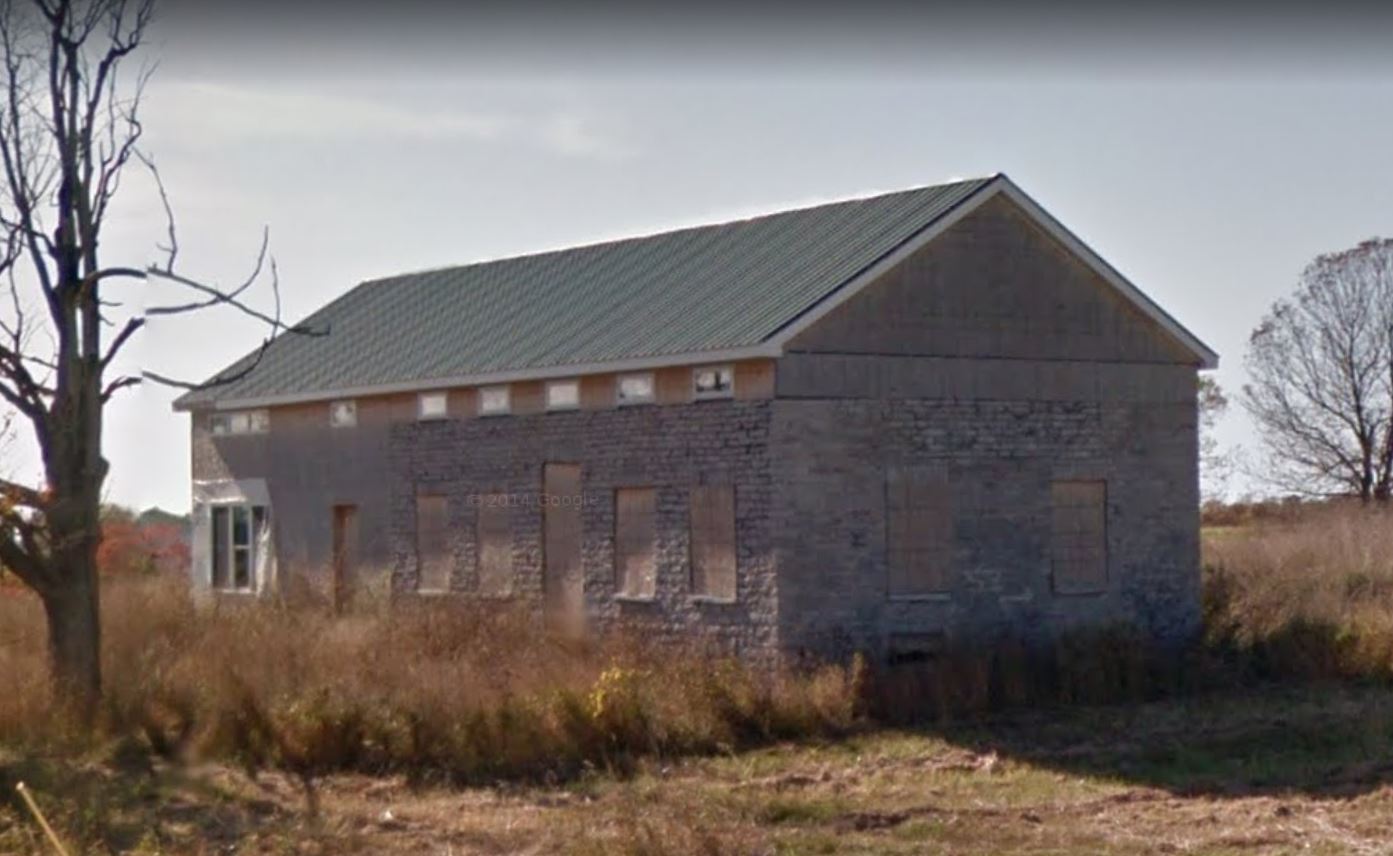
Uniquely attractive is this low house of native limestone which is located on the southeast shore of Wilson's Bay in the town of Cape Vincent. With its 132.7 acres of land, which fronts on the bay and is owned by Frederick A and Leta K Smith, it is known as Bayworth farm. As one cruises up the shore from Cape Vincent village and rounds Tibbett's Point on the way to Point Peninsula, Wilson's Bay is found to be the second one beyond the lighthouse point towards the peninsula. By land Bayworth farm is reached by a road which taps the Pleasant Valley road and this farm adjoins the original holdings of Captain John Tibbett, from whom Tibbett's Point was named. Plain in architectural style this house is unusual with its five low upper story windows. The outlook from the front of the house is beautiful across the bay, whose shoreline is almost a horseshoe, and few are the habitations upon it.
This house was constructed at least 110 years ago and may have been erected for Vincent LeRay for sale purposes, although it was more likely built for George Cough Jr, who came to this country from Germany and purchased 81.44 acres of the land in three adjoining parcels from Vincent LeRay, who was represented by his attorney Samuel C Kanady, in the transaction, which involved a payment of $404.16 on February 25 1831. On March 23 1836 LeRay, through his agent, Patrick Somerville Stewart, sold another plot of 51.26 acres adjacent to the other three to Mr Cough. The Cough family retained the property upwards of 40 years, George and Mary Ann Cough, then of Kingsboro, NY, disposing of it March 25 1876 to Abel G and John Robbins of the town of Cape Vincent for $8,000.
The Robbins brothers were in business together and ultimately John Robbins acquired the interest of Abel G Robbins in the property. They were farmers and on November 21 1892 John Robbins transferred this farm to his wife, Sarah E Robbins, for the nominal sum of $1. On March 4 1893 Mrs Robbins conveyed it back to her husband and later it came into the possession of Harry J Robbins and his wife, Anna B Robbins, who sold it to the present owners on August 21 1934. Harry J Robbins, who now resides in the village of Cape Vincent, was the son of John and Sarah Robbins, and is the father of Everett F Robbins, 384 Brainard Street, a teller at the Northern New York Trust company. Everett F Robbins, who lived in the house until he was about twelve years old when his parents moved into the village of Cape Vincent, relates that the house, in excellent state of preservation, is unusually commodious notwithstanding its low exterior appearance.
The long wooden wing, a part of which shows at the right side of the picture, was built during the ownership of John Robbins
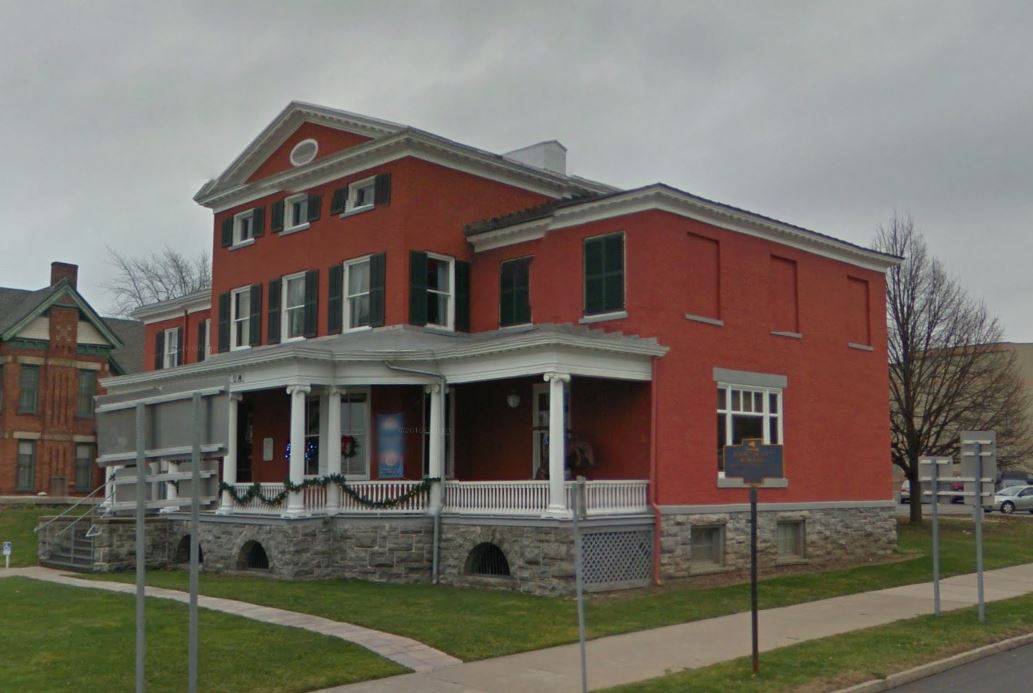
Romance and drama permeate the history of the old Parish mansion at the corner of Washington and State Streets, Ogdensburg. Constructed of brick baked at the corner of Washington and Isabella Streets, it was started in June 1809 for David Parish, millionaire banker and shipping magnate from Hamburg, Germany, who had in vested heavily in North Country lands and early that year purchased the site of Ogdensburg for §8,000.
In 1811 Parish brought Joseph Jacques Ramee from Hamburg to landscape the grounds and design the interior decorations, which were completed in 1812. The woodwork is said to have been fashioned in Rouen, France, and installed in the house by French workmen. Parish interested himself deeply in North Country development and built an iron furnace at Rossie in 1813. In 1816 he returned to Hamburg, was succeeded by his brother, George, as occupant of the house and in the management of his properties, and over a financial dispute with the Rothchilds drowned himself in the Danube river in 1826.
George Parish, who died in Europe in April, 1839 disposed of the property to his nephew, George Parish 2nd, in 1838 for $229,000. Handsome, medium-height, aquiline-featured George Parish, 2nd, brought romance to the mansion in the winter of 1841-2 when he installed there the small, black-eyed brunette, Mine. Maria Elena Amerigo Vespucci, international celebrity who claimed descent from Amerigo Vespucci, early Italian explorer. Variously dubbed "the fair Florentine," "the Tuscan Beauty" and "the Beautiful Italiano," she had been mistress to Ferdinand, Duke d'Orleans, son of French King Louis Philippe. Later she had found warm favor in the heart of President Martin VanBuren, and there is the legend that still later she was mistress to his son, "Prince John."
Romantically the legend has it that Parish won her from "Prince John" in a poker game at Captain John Hoover's brick tavern at Evans Mills that winter of 1841-2 and then domiciled her for 18 years at Ogdensburg, whence, cast off and broken-hearted, she left in the summer of 1859 for Europe and died in Paris October 21 1866. Parish abandoned the mansion and went to Bohemia February 2 1860 and died April 13 1881.
October 1 1879 the Parish properties were sold at auction and N P Woolley bought the mansion and part of its site for $2,600. Later he sold it to George Hall, coal and steamship magnate, and mayor of Ogdensburg, who resided there several years. Ultimately Mr Hall, in association with John C Howard, friend of Frederic Remington, the world-famed painter of the horse and life on the western plains, sculptor and author, altered the house and gave it to the city of Ogdensburg as a museum of Remington's paintings and sculptures. Remington had died December 26 1909. As the Remington Art Museum, it was formally dedicated and opened July 19 1923 and today houses a half million dollars worth of Remington's art creations.
"This old mansion built in 1810 by David Parish was remodelled in 1922 in memory of Frederic Remington by George Hall and John C Howard," is the inscription on the bronze tablet fastened to the front wall of the mansion near its main entrance on Washington Street. That entrance looks past the public library, which was the old Joseph Rosseel mansion across the street, and beyond a little park sees the green St. Lawrence river.
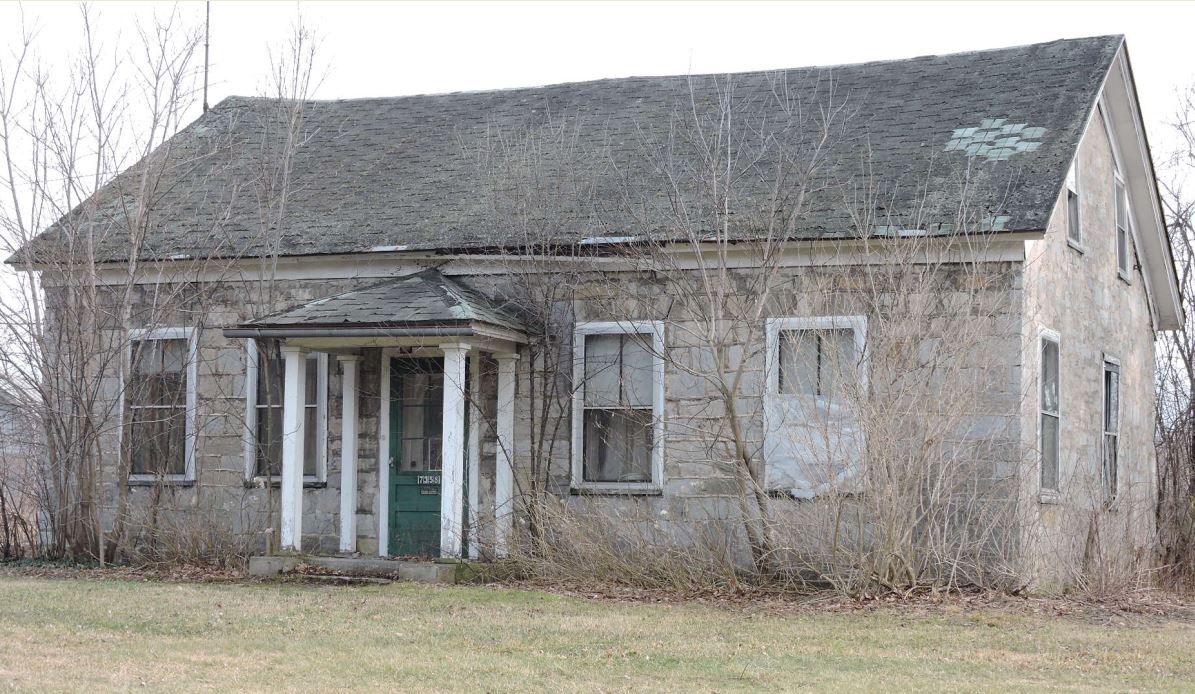
County Rd 138, Calcium NY
The home of Mr and Mrs Claude C Schrodt at Calcium is an especially attractive one. The low house of native limestone was built about 115 years ago and possibly longer than that. It is believed to have been erected by Levi Butterfield, first innkeeper of the town of Rutland. It was in his tavern at Rutland Center April 1 1802 that the first town meeting was held, he and Daniel Eames being elected poundmasters.
Born in New Hampshire in 1770 Levi Butterfield look up 172 acres of land in Rutland in 1799 making him one of the first settlers of what is now Jefferson County. He was twice married and was the father of 15 children. A great great granddaughter is Mrs Eli G Herrick of this city. July 30 1830 he paid Vincent LeRay $1,357.94 for 83.63 acres of land where this stone house is at Sanfords Corners, now called Calcium, in the town of LeRay and it is probable built this stone house at that time, although the price may indicate that the house was standing when LeRay sold him that parcel of land. At any rate he moved there from Rutland and on February 18 1833 bought an adjoining piece of 6.04 acres from Washington Coster of New York City for $44.44.
On April 28 1836 he and his second wife, Isabella, sold the property to Ebenezer Woodward for $2,116.52 and removed to Black River, where he died July 8 1837. During the War of 1812 he was lieutenant of Captain Timothy Tamblin's company of Rutland Silver Grays, consisting of 40 men, most of whom were veterans of the Revolution. This company built Fort Tompkins, one of the American defenses at Sackets Harbor.
The house is on the south side of the road which taps the Watertown-Evans Mills state highway at Calcium and runs past Madison Cooper's to the picturesque Sanford's Corners Union church.
A peculiarity of the house is that it was placed so that its corners point North, East, South and West. Consequently it is not parallel with the road. County records show that Butterfield sold off a five-acre plot to the west of the house containing a tavern, Eli Farwell having been the buyer.
Ebenezer Woodward and his family occupied the property 28 years and April 30 1864 he and his wife Sylvia, disposed of it to James Smith of LeRay for $4,800 but on December 3 of the same year James and Rosetta A Smith sold it to Henry Putnam of Pamelia for $5,000 and February 22 1866 Henry Putnam and his wife, Keziah, disposed of it to Clarissa Rice for $4,800. She retained it until January 26 1893 when she conveyed it to Martin Schrodt of the town of Brownville for $4,620. Mr Schrodt died several years ago but the property is still a part of his estate. Claude C Schrodt, Calcium garage operator, was born in the house and he and his family have made their home there since his marriage July 16 1927 to Miss Doris E Bibbins, a graduate nurse of the House of the Good Samaritan and at that time a resident of this city. Mr Schrodt is the son of Martin Schrodt who acquired the property in 1893.
Roswell Woodruff started settlement of Sanford's Corners, once known as Jewett's Corners, in 1804 and a postoffice was established there in 1828.
8623 LeRay St, Evans Mills
A large and graceful willow lends an artistic touch to the fine old native limestone mansion of Mr and Mrs Perry W Balmat Sr, only a short distance outside of Evahs Mills on the lefthand side of the LeRaysville road as one proceeds toward the latter place. Here once resided some 90 or more years ago the parents of John, Joseph and Patrick Kinney, and part of the 178-acre farm of Mr Balmat, the present owner, abutted one corner of land once owned by Ethni Evans, the man for whom Evans Mills was named. This particular piece of Evans land involved a plot of 50 acres, which Ethni Evans deeded to Sylvanus Evans in 1809.
Ethni Evans was one of the earliest settlers of this section, having come from Hinsdale, NH, in 1802 to do work for Jacob Brown. He was a builder and is reputed to have constructed the first or frame mansion for James D LeRay de Chaumont at LeRaysville 1806-1808. On July 9 1804 he paid LeRay $577 for 192 acres and 22 perches of land of great lot No 566 of lot No 4 of the Macomb purchase and began the industrial development of Evans Mills. The proximity of the Balmat farm to the Evans land is shown by the fact that the line of the Balmat farm began between great lots 565 and 566.
The Balmat housed is probably 125 years old and its earliest history is not disclosed by the county records. For more t han 60 years, however, it was owned by the Woodards.
Darius and Maria Woodard having sold one plot of 115.81 acres of it to Edward Woodard on February 5 1878 for $4,000. On March 1 1880 Ann M Graves, Maria E Sixbury, Martha E Rulison, Belle M Beckwith and Frances R Ray, daughters of Hiram Ray, sold an adjoining plot of 66.73 acres to Edward Woodard for $3,002.85. Hiram Ray was a man of considerable prominence in the county and bought many hundreds of acres of farm lands. On September 18 1880 Sidney A Sixbury of Lowville, as his executor sold another plot of 60.73 acres adjoining the Ethni Evans tract to Edward Woodard for $3,000.
Woodard married Amelia M, daughter of Henry G Potter and she was the aunt of W J G Potter of this city. In his will Henry G Potter provided that so much of his residence as was bought of Jane H Evans be retained by his family.
When Edward Woodard died some years ago he willed his fine stone house and farm to his daughter, Miss Minnie H Woodard, who sold off some small parcels of it to different persons and finally in 1939 disposed of the house and remaining 178 acres to Mr and Mrs Balmat. Their son, Perry W Balmat Jr, who served 18 months in the U S Army Air Corps and who was married to Miss Connie Laura Lucas, daughter of Mr and Mrs Earl N Lucas of this city, April 22 1944 is managing the farm for them. The house is one of the most pleasant in that section of the county
The large and imposing brick mansion at 129 Clinton Street, built probably in the 1820's by Israel Symonds, a prominent Watertown merchant and business man at that time, is best known perhaps as the George C Sherman residence and is richly historic. Since January 20 1941 it has been owned by Drs. Walter S Atkinson and Lawrence E Henderson, eye specialists and used by them in their profession. It was acquired by them from the William L Bones estate. While the first George C Sherman is credited with having built the house, it is likely that it was erected by Israel Symonds who, with his brother, Martin V Symonds, conducted a store on part of the site of the present Watertown National Bank building, for the price of $2,600 paid Symonds March 17 1835 by Mr Sherman would indicate that there was a houseman the property at that time. George C Sherman, born in Providence, Rhode Island, December 14 1790 was a descendant of Henry Sherman of Dedham, England, and a son of Phineas Sherman who settled in Watertown in 1810 and owned a small paper mill on a part of Knowlton Brothers, Inc., present site.
George Corlis Sherman came to Watertown as a boy and later studied law in the office of David W Bucklin, being admitted in 1823 and shortly became Bucklin's partner. From 1833 to 1840 Mr Sherman was district attorney and in June 1838 prosecuted a number of Patriot War offenders, tried here and acquitted. On August 31 1837 he was one of the incorporators of the Sterling Iron company at Sterlingville. From 1843 to 1847 he was a judge of the court of common pleas. He was elected state senator in 1843 and served one term, refusing a second to become a law partner of his brother-in-law, Robert Lansing, under the firm name of Lansing & Sherman. Mr Sherman, who had succeeded his brother-in-law, Robert Lansing, as district attorney, married Mary Ann Hubbard, daughter of Noadiah Hubbard. Mr Lansing first married Maria Hubbard, mother of John Lansing who was father of Secretary of State Robert Lansing, and after Maria's death married her sister, Cornelia. George C Sherman gave up law in 1848 to become a banker. January 20 1839 he had organized the Watertown Bank & Loan company and January 1849 organized the Merchant's Exchange Bank soon merged with the Watertown Bank & Loan Company. He died in April 1863 and January 29 1865 this bank was reorganized as the National Bank & Loan Company with his son, George H Sherman, as first president. The Sherman family owned all of the stock. In January 1897 the bank was again reorganized with the first George C Sherman's grandson, George C Sherman 2nd, later well known paper manufacturer, as president.
After the first George C Sherman's death the mansion passed to his widow, who on November 10 1891 conveyed it to her daughter, Mrs Sarah M Lansing, wife of Frederick Lansing, prominent local lawyer, Civil war hero, state senator and congressman. On October 27 1902 Mrs Lansing sold the mansion to W L Bones, who made several alterations in it and it was occupied by him and his widow until after her death, when his heirs disposed of it to the present owners. W L Bones was a retired New York wholesale dry goods merchant
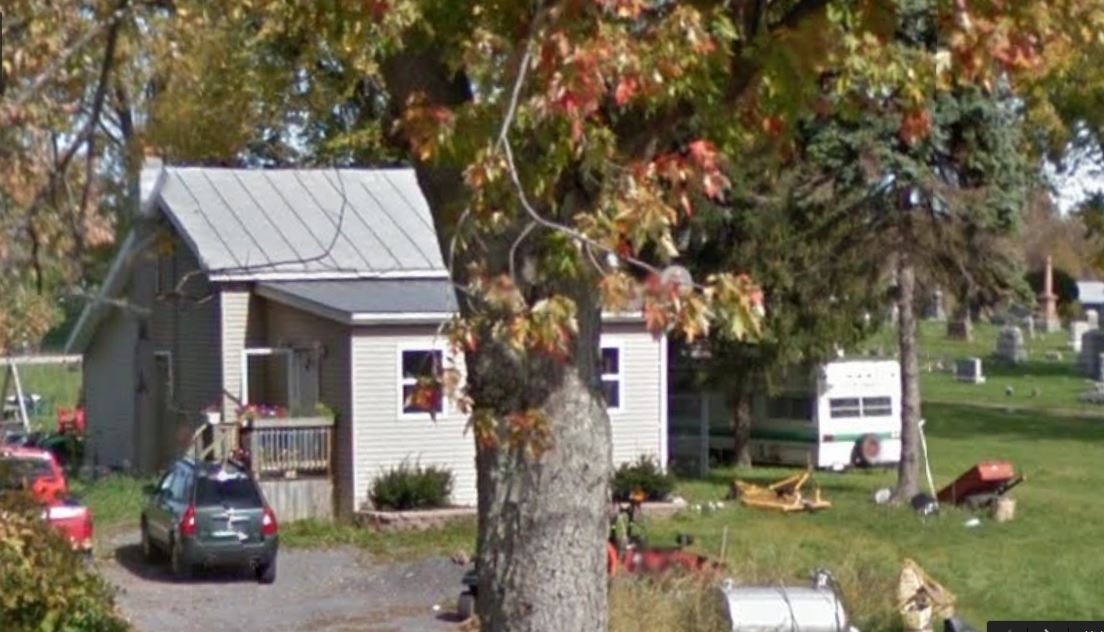
In the vicinity of the Three Mile Bay railroad station which is about a mile and a half north of the village of Three Mile Bay there is an area known as Wells Settlement. One of the founders of that settlemnet was Isaac Wells who bought his first farm lands there as early as April 9 1827 from Vincent LeRay and shortly afterward erected there a fine native limestone house which still still stands in excellent condition. For the past 22 years the house and about 178 acres of land has been owned in the Eselin family of Three Mile Bay, Henry F Eselin having bought it for $12,400 from Earl B and Ada H Cranson January 1 1913 and by January 5 1918 conveyed it to his wife, Mrs Kate Eselin. Today the original exterior beauty of the stonework of the house is somewhat marred by a smooth coating of concrete.
Isaac Wells, who died April 8 1856 at the age of 62 was prominent in the administrative affairs of the town of Lyme. He was an assemblyman from this county at the time he passed away, had been supervisor of his town in 1837, 1848-7 and also had been justice of the peace and town clerk of Lyme to which town he removed after having first settled at Sackets Harbor in 1813 while the War of 1812 was at its height. His wife was Maria Whitney of Newport and their children were Gilbert, Marcus L, Remos, Pamelia, Calista and Ellen. Under his will his widow took a life use of the estate and then it went to his children, Marcus L Wells, joint executor with his brother Gilbert eventually taking over the property and becoming a prominent farmer and livestock dealer.
Marcus L Wells and his wife Lucinda sold the place excepting 3.82 acres which included the family cemetery and the R W & O right of way to Oliver V Hewitt of Lyme for $8,886.50 on April 1 1881. April 1 1893 Hewitt and his wife Nancy disposed of it to Jerry Valley for $8,000. Valley retaining it until April 4 1903 when he conveyed it to Mrs Martha Cranson for $8900. Under the will of Mrs Cranson recorded February 18 1910 the property went to her son Earl B Cranson but he kept it less than three years and with his wife Ada H sold it to Henry F Eselin January 1 1913.
Isaac Wells, the original owner was a son of Hezekiah Wells, a native of Concord, NH who died while en route with his family to Jefferson County. Hezekiah Wells was a son of a native of Wales who came to America and fought in the Revolutionary War on the side of the colonists. Remos Wells, a son of Isaac and brother of Marcus L married Mary A, daughter of Hiram S and Esther Ryder Pomeroy, and became supervisor of Lyme 1862-5. Pamelia Wells, a sister of Marcus, Gilbert, Calista and Ellen married George R Lucas member of a well known Lyme family.
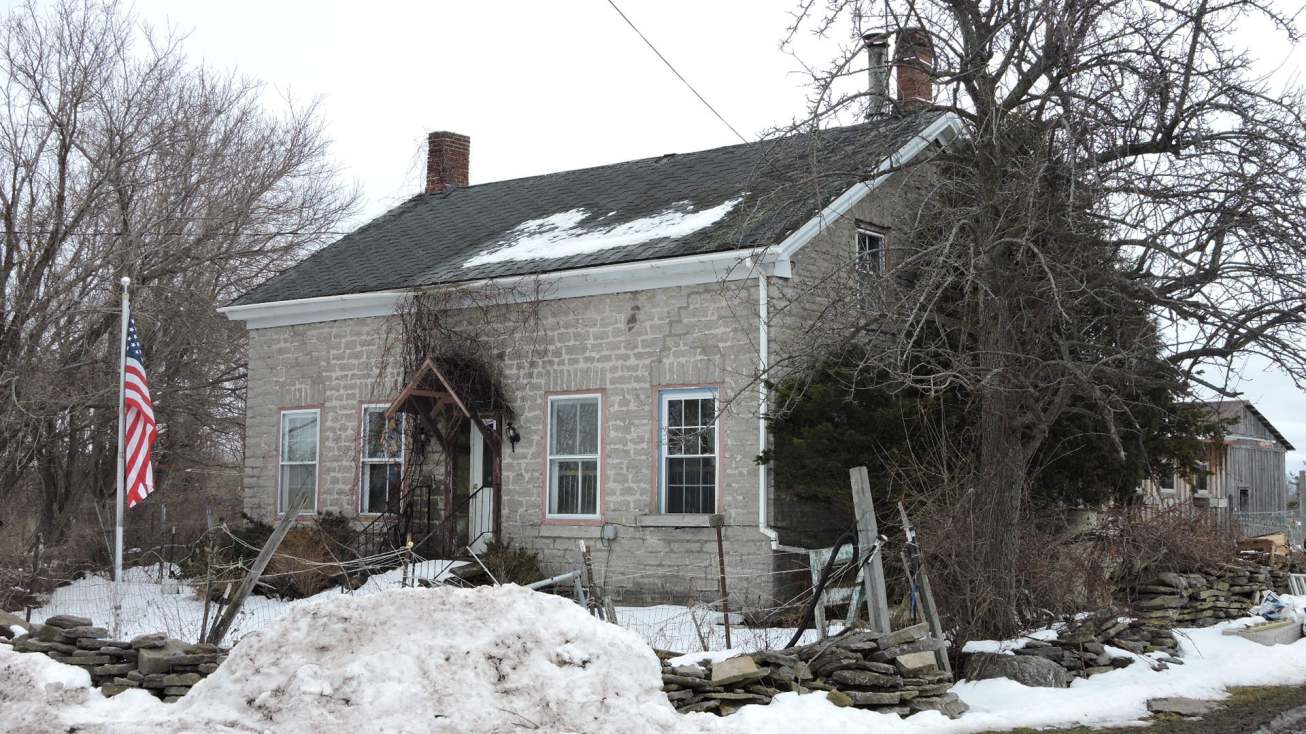
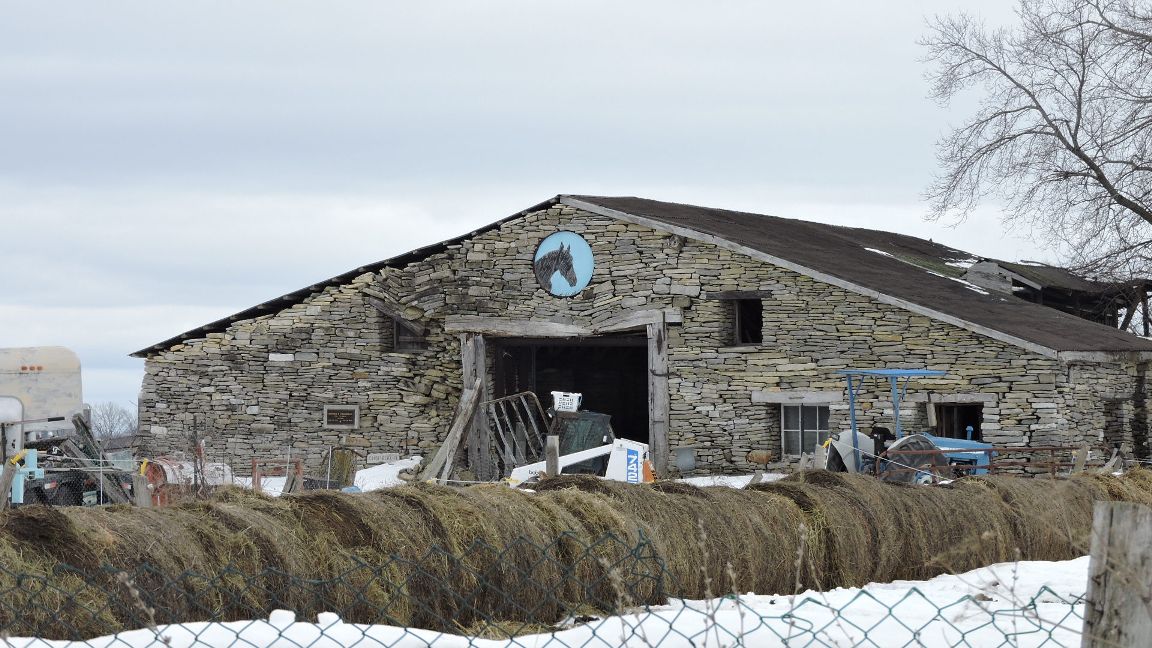
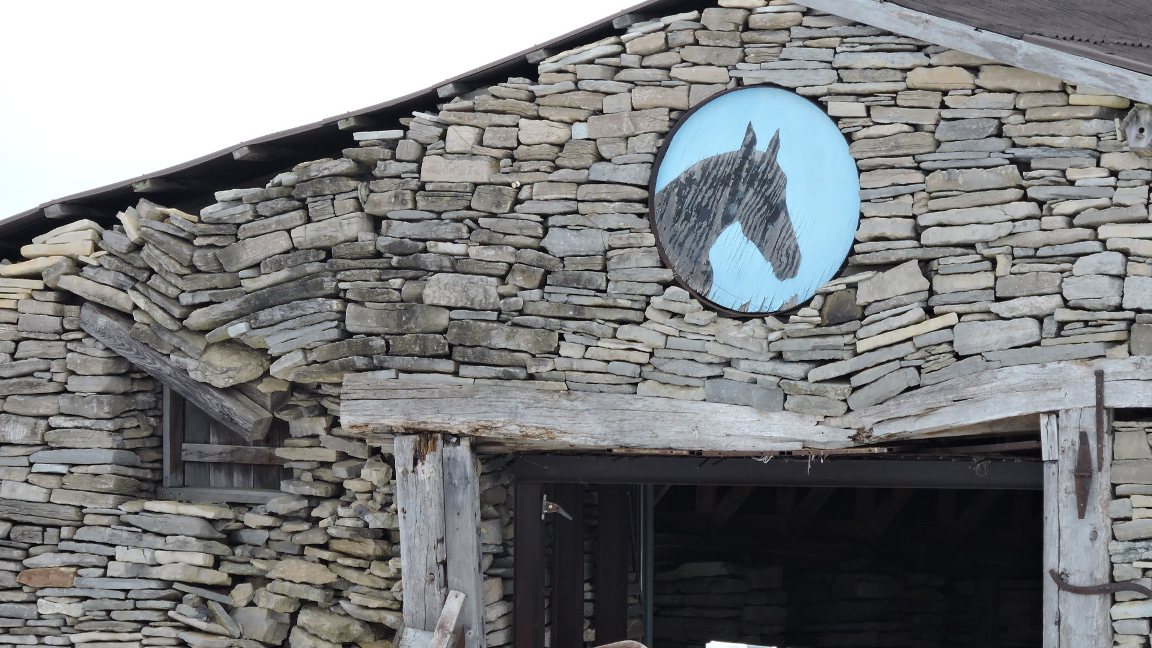

The little limestone house of eight rooms including a neat, modernly equipped kitchen, owned by John C Stumpf for over a score of years, is on the road from Rosiere to Warren and Tuttle Settlement. It was built by Joseph Docteur, one of the early French settlers of the town of Cape Vincent, about a century ago. In the summertime its setting is beautiful amid the colorful flowers grown by Mrs Stumpf. It is the birthplace of Attorney E Ralph Gosier of this city and long was possessed by the Gosiers up to October 1 1924 when Edward A Gosier, prominent Cape Vincent hay dealer and father of Attorney Gosier, sold it and 51.39 acres of land to Mr Stumpf for $1,500.
Joseph Docteur bought the first 31.14 acres of the place from Vincent LeRay January 15 1845 for $269.97 and undoubtedly built the house that year. In 1848 he bought the second tract of 22 acres from Joseph Hempell for $300. The latter plot had been owned by Marie Anne Robail, wife of John B Robail, native of Normandy, soldier of Napoleon in the Russian campaign and interpreter for Cape Vincent's early French settlers. On December 26 1854 Joseph Docteur sold the property to his son, Charles A Docteur, for $500 on condition of fulfilment of certain provisions for Joseph's widow and other members of his family. Charles A Docteur sold to Charles A Gaugien, grandfather of E Ralph Gosier, November 22 1875. Charles A Gaugien willed his widow a life use of the property and then provided that his son, Edward A Gosier, have the first right to buy the place for $4,000 which he did from the estate March 30 1903.
Gaugien, now Anglicized to Gosier, was the name of a proud French family from Rosiere, France, and responsible for naming the hamlet of Rosiere in the town of Cape Vincent. Simon Gaugien, immigrant ancestor of that family, came to America in 1770 and served in the American Revolution under the Marquis de Lafayette. Simon returned to France, however, and died, there in 1813 aged 67. In 1832 his son, Simon Jr, and his wife, Jane Ann Therat Gaugien, with their four children settled in Cape Vincent. One of those children was Charles A Gaugien, who married Genevieve, daughter of John and Margaret Branche, also from France. It is believed that some of the family of Charles A Gaugien was responsible for Anglicizing the family name to Gosier, by which it is now generally known. It was Charles Gaugien who served for the first mass said by Father Simon in the Catholic church erected at Rosiere in 1832.
In the vicinity of this quaint native limestone house once stood a virgin forest of finest white oak and of pine. Early the oak was cut. Shepard, James and Asa Warren came in 1825 and began clearing. Soon they were joined by Edwin Tuttle and between 1832 and 1834 the pine was also taken off. Today the region is a fine dairy and hay country. The Stumpf family, from which the present owner descends, is of long Cape Vincent prominence, John Stumpf having first stopped at Albany for five years before moving on to the town of Cape Vincent.
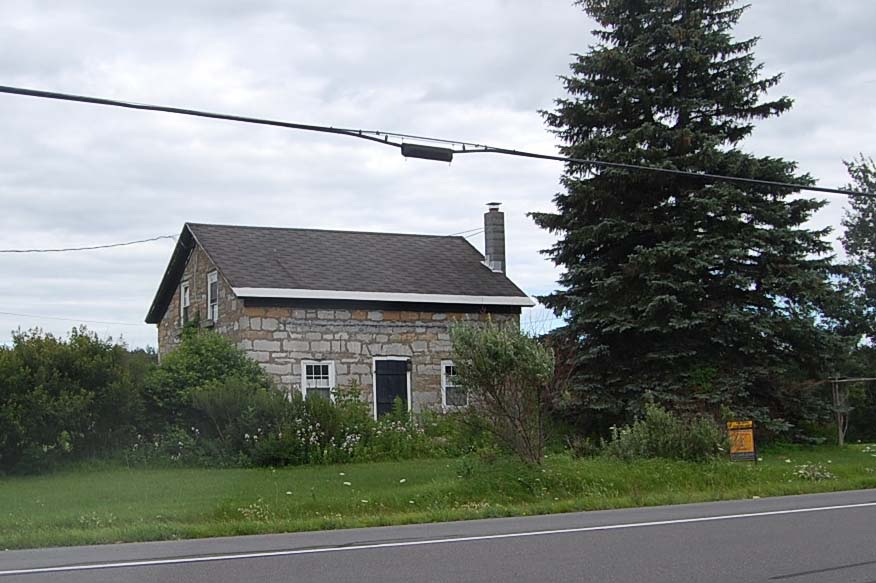
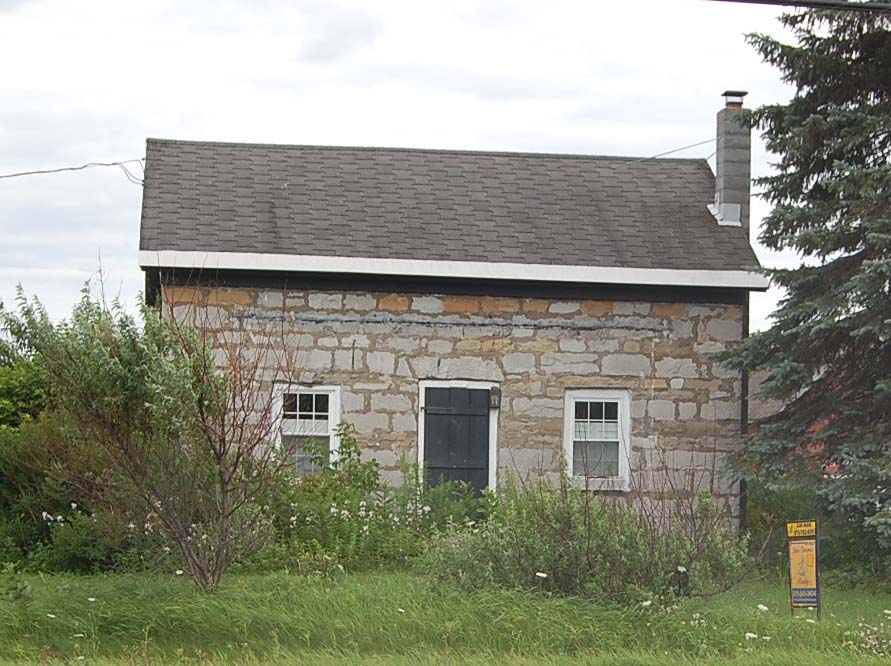
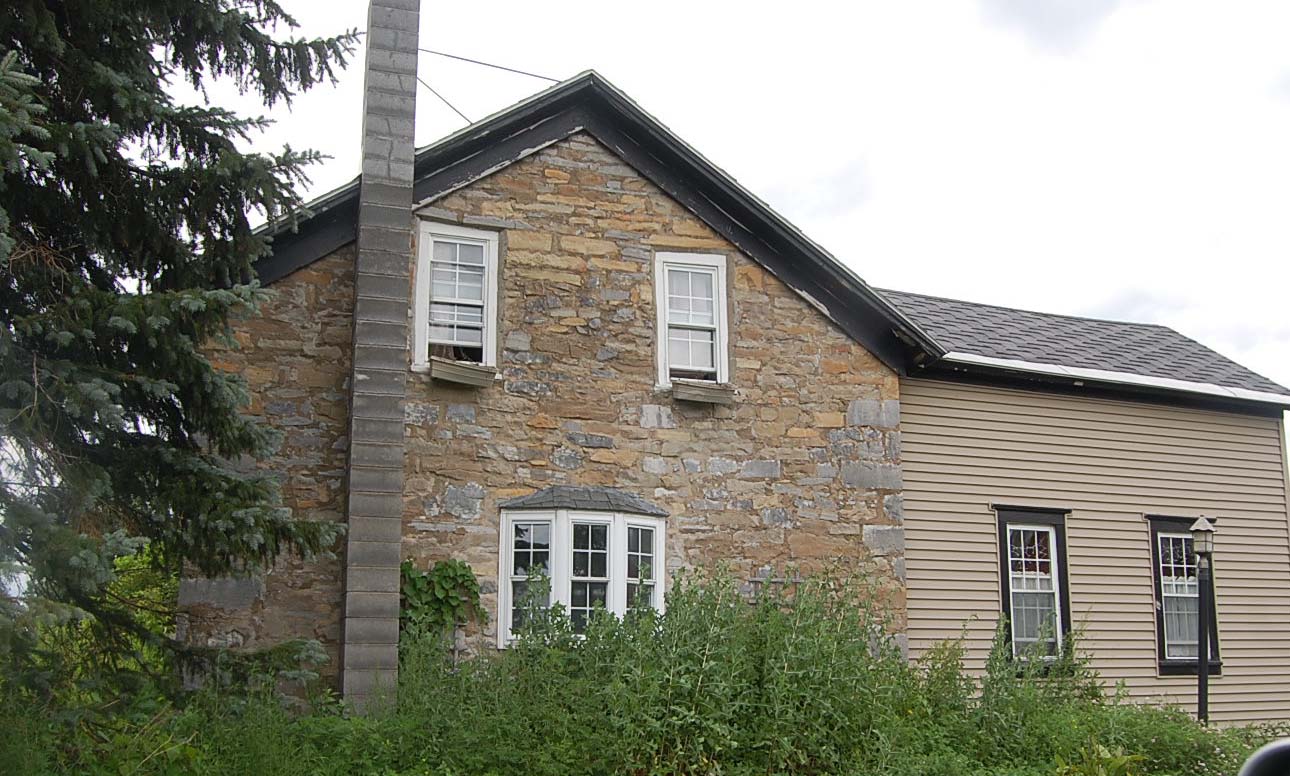
A small and severely plain limestone house a few miles south of Evans Mills on the east side of the old plank road, now the state road leading to Watertown, is one of the first stone dwellings to have been constructed in the town of LeRay. It was built by Paul Anthony Jr, a stone mason born in Rhode Island in 1782. Today it is owned by George B VanBrocklin, a New York Central section foreman. It is within a few rods of Mr and Mrs Elbert W Merry's stone house, which was also built by Anthony and February 21 1866 became the property of Benjamin VanBrocklin, eventually passing to his son, Harvey E VanBrocklin, father of George B VanBrocklin. The latter recalls that there his father had a shop and manufactured the old-fashioned duck-foot cultivators consisting of a wooden frame and teeth shaped like a duck's foot. There were ten of these teeth on a side, George B VanBrocklin still possesses a bronze medal awarded in 1876 to his father by the Jefferson County Agricultural society for the best iron plough in the county. Harvey E VanBrocklin died September 21 1881.
History of today's house probably dates back to the early years of Paul Anthony's residence in this county. When he first migrated to thks state about 1803 he tarried at Boonville, where he built himself a log hut, but in a few years came to the town of LeRay and October 31 1809 bought land jointly with James Anthony in the area of the Merry and VanBrocklin stone houses. Paul Anthony constructed the stone hotel at Brownville, the Redwood glass works and many stone houses.
James Anthony sold his interest in the land to Paul March 13 1835 and March 1 1854 Paul sold 128.32 acres to Nelson Clark for $2,460 reserving about two acres containing the stone house now the property of Mr VanBrocklin. Down through the years and the many transfers to the present time this house and the two acres have gone together. On December 17 1862 Paul and Thomas H Anthony sold it to Israel E Gibbs, who disposed of it April 5 1864 to Lydia Ann Clark and May 7 1870 she conveyed it to Lucetta Reed. In turn Lucetta sold it to William Baldwin March 4 1878 but Baldwin removed to the town of Watson and sold the place to Isaac A Wood January 12 1883.
Wood was a breeder and dealer in purebred Ayrshire cattle and also handled western mortgages, but February 12 1887 he disposed of the stone house and two acres to Lucinda Petrie of the town of LeRay. Later she removed to Chicago and August 20 1905 sold this property to Mrs Eunice E VanBrocklin, mother of the present owner. Mrs VanBrocklin died early in 1934 and by the terms of her will, recorded in the county clerk's office March 6 of that year, her son, George B VanBrocklin, inherited her property including the stone house and two acres. Although small in exterior appearance it has seven downstairs rooms and four bedrooms upstairs.
Wilson's Bay in the town of Cape Vincent is only a short distance by water from Grenadier island, which lies to the southward. North of Wilson's Bay is the Tibbett's Point lighthouse and directly across Lake Ontario is Prinyer's cove in the province of Ontario. At the beginning of the last century most of the land thereabouts in the town of Cape Vincent was owned by James D LeRay de Chaumont, who later transferred it to his son, Vincent, for whom Cape Vincent was named.
On November 18 1800 however, Captain John Tibbett, a Revolutionary war veteran from Troy, was patented 599 acres of land from Wilson's Bay to Tibbett's point and later in that same part of the town Count Real, Napoleon's prefect of police, and the Peugnets, Louis, Theophile and Hyacinthe, also adherents of Napoleon, purchased land from the LeRays.
Something over a century ago the quaint-styled, plastered limestone house, was built on the southeast shore of Wilson's Bay and is the next place lakeward to the old stone house now owned by Mrs Philip Brown of Scarsdale, who uses it as a summer home. This plastered stone house, shown above with its modern wing, has been owned since March 27 of this year by Donald M Milligan. At that time with its nearly 285 acres it was conveyed to him by his father, John Milligan, who recently died, and by his mother, Catherine Milligan. The elder Milligans had owned a part of it prior to that from March 1 1920 when they purchased it from Dwight M Borland.
The other part he had acquired from William and Lovina Anthony February 23 1909. Back of that there has been different ownerships of the parcels that comprise the present farm, the names of such early Cape Vincent settlers as VanSchaick, Borland, Fuller and Wilson having been among the early possessors of parts of it. Patrick O'Neil of Wolfe island had bought three parcels amounting to 132.82 acres of the farm from Charles Wilson November 30 1874. Charles Wilson had purchased the same parcels from Samuel T Borland April 27 1868. The other 150 acres Charles Wilson had obtained from James G Wilson February 5 1845 and the same day sold it to Charles Wilson Jr
James G Wilson apparently bought a large part of the farm from Henry H and Hannah Ainsworth on March 5 1839. Another plot of 50 acres he purchased from Louis D Peugnet July 15 1852 and a plot of 30.6 acres from Buel and Sally Fuller December 11 1846.
It seems now definitely established that this house, 408 Washington Street, one of the most historic dwellings m the city of Watertown, was built in 1828-1829 rather than in 1826 or in 1823 as heretofore believed. Justin Butterfield, one of the strongest and most noted lawyers Jefferson County had in the forepart of the 19th century, was the first owner and occupant of this house. After his removal to Chicago, about 1840 where he became a man of prominence and wealth, this house on the south side of Washington Street was owned for a century by the Otis family. It passed out of that family September 25 1941 when heirs sold it to Augustus S Holmes, investment and housing consultant, present owner.
Upon being admitted to law practice in this county on 1813 Justin Butterfield
first located in Sackets Harbor, but later removed to Watertown and June
23 1828 paid Orville and Betsey Hungerford $400 for a lot on the west
side of Washington Street, across from the First Presbyterian church.
Hungerford, prominent merchant and banker, a founder of Jefferson County's
first bank, later a congressman, and first president of northern New York's
first railroad, had acquired 20 acres of land in that section at Washington
Street five years before.
Butterfield, who is said to have successfully defended Joseph Smith, founder of the Mormon religion, when on trial in Springfield, IL in 1843 for alleged 'implication in he assassination of Governor Bogg of Missouri, removed to Chicago from Jefferson County about 1840.
Mr Butterfield was a resident of Chicago September 30 1841 when he disposed of his residence on Washington Street to Orville Hungerford for $2,500. Mr Hungerford retained the property only until October 18 of the same year and sold it to David Day Otis, a young hardware merchant and native of Saratoga county who had come here in 1827. Mr Otis had a hardware store in the Otis block at 23 Court Street and was at one time a partner of Harris Yale in the firm of Otis & Yale. It was after the big fire of 1849 that Mr Otis built the block, which became the home of the Globe hotel and later the Otis house, which latter was destroyed by fire early in 1903.
On May 1 1863 Henry Court as assignee for Mr Otis sold the residence to Mrs Sarah A Otis, wife of Mr Otis, and under the provisions of her will, recorded in the county clerk's office January 15 1903 a life-use of the residence and contents went to her daughter, Mrs Caroline Otis Greene, wife of Navy Lieutenant Joseph Story Greene of noted Civil war service. Mr and Mrs Greene, who had been married in the house September 28 1871 resided there many years. Mrs Greene died February 1 1926 and Mr Greene December 17 1931. The property then reverted to the heirs of Mrs Sarah A Otis, and one of those heirs, David Bruce Otis Sr, and family resided in the house from that time until Mr Holmes purchased it. That purchase was made from David B Otis, Albert C Otis, Mrs Marion Cadwell Hoerle, Howard O Cadwell and Delos S Otis. It is one of the most attractive-typed of the city's older residences.
John Sanford, for whom Sanford's Corners was named, was the original owner of this house, which is located about two miles beyond what is now known as Calcium. It is at the four corners and lies directly across the road from the picturesque old Union church and diagonally across from the old Sanford's Corners cemetery. The original or stone part, constructed of native limestone, is a quaint and modest type of only four rooms and a pantry on the first floor and a couple of bedrooms upstairs.
Since November 24 1925 when they purchased it from Frank H Bowman of LeRay and Mabel Moistur of Carthage, it has been owned by Robert E and Katherine E Russell. Prior to that there had been some owners for short periods, but from November 17 1870 when George W Fairman of Cape Vincent, purchased it from Annah L Lamb of LeRay it was for 19 years in possession of some member of the Fairman family. Annah L Lamb, formerly of Wilna, bought the property January 20 1870 from Houghton and Sarah N Herrick, who had acquired it December 17 1869 from DeWitt C and Nancy A Jewett, then of Southforks, IA, DeWitt C Jewett was the son of Ezekiel Jewett Jr, and Ezekiel Jewett Jr, was the son of Captain Ezekiel Jewett, the old Revolutionary War veteran who was one of the first settlers of what is now Jefferson County. The record shows that Ezekiel Jewett sold the property to DeWitt C Jewett for $1,500 on August 26 1848 but when and from whom Ezekiel obtained it is not clear. From the recorded description of the property it included a parcel of 22.82 acres, to which there was adjoining on the south another parcel of 24 acres. This 24-acre plot had been purchased upwards 120 years ago by John Sanford from Vincent LeRay De Chaumont.
On November 23 1829 John Sanford and his wife, Polly, then of Mayfield, Montgomery county, sold the 24 acres to Daniel Harbeck of Broadalbin. The price was nominal and there is no indication as to the presence of the house. Settlement was started by Roswell Woodruff at Sanford's Corners in 1805. Woodruff and his wife, Lois, had come from Litchfield county, Connecticut and first located in Turin. On August 6 1805 Woodruff paid Richard Coxe of Lewis county $3,500 for 1,200 acres in the Sanford's Corners area. Roswell and Lois Woodruff were the parents of Norris M Woodruff, builder of the Hotel Woodruff in this city in 1851. On May 31 1819 Roswell Woodruff and his wife sold the 1,200 acres in LeRay to Ezekiel Jewett, then of Whitestown, Oneida county, for $15,710.
History records that Captain Ezekiel Jewett had come to what is now Watertown with Hart and Isaiah Massey and Jonathan Cowan in the spring of 1800 shortly after Henry Coffeen and Zachariah Butterfield had arrived in March. The first record of Ezekiel Jewett having bought land in this county was a plot of 40 acres from Nicholas Low in the town of Watertown December 16 1807. This he sold to his son-in-law, Jonathan Inglis January 3 1814 and five years later bought the 1,200 acres of Roswell Woodruff.
Captain Jewett died June 11 1836 aged 67 years eight months and is buried in the old Sanford's Corners cemetery. Variously that community has been denominated Jewett's Corners, Jewett's School House and Captain Jewett's.
On Dezengremel Road
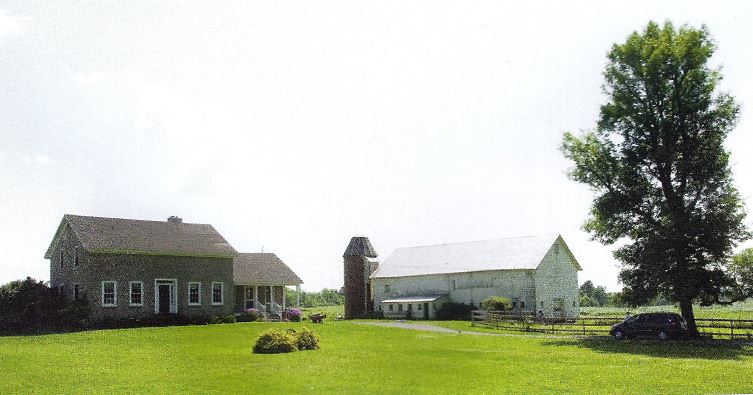
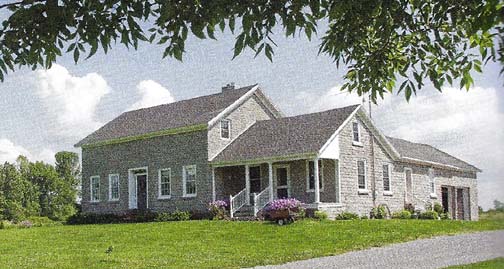
The Dezengremel family is one of the old French families of the town of Cape Vincent and still owned in that family is the old native limestone house built about a century ago for Remy Dezengremel, the pioneer, near the French Settlement on the Kent's Mill road. The family tradition is that the stone was quarried on the farm where Ignatius Wiley, the stone mason who built a number of houses and stone buildings in the town of Cape Vincent, constructed the house.
In 1835 Remy Prosper Dezengremel and his wife, Mane Hetrick Dezengremel, came from France and took up land in the town of Cape Vincent. On June 17 Vincent LeRay sold them 58.17 acres and July 21 Jedediah Mills disposed of 50 acres to them. These parcels were then in in the town of Lyme, Cape Vincent not yet having been set off. With them were their sons, Remy and Francis Peter Dezengremel. Remy had been born in France in 1813 and was 22. At first the Dezengremels lived in a log cabin, but later in time the stone house was built.
On September 22 1850 Remy Prosper Dezengremel conveyed two parcels of 43.39 and 79.63 acres to his son, Remy, for the nominal consideration of $l . According to descendants it was the son, Remy, who built the stone house. In any event Remy Prosper Dezengremel returned to France on a visit in 1858 and died there at the age of 74 on May 30 of that year. His son, Remy,was first married to Melina Delaplace of France in 1844 and had one son Louis R Dezengremel. Second Remy was married to Mrs Elizabeth C Hassler.
Remy died at his home near French Settlement October 19 1888 aged 75. On June 28 1883 he had given his son, Louis R, a life lease of the stone house and homestead and farm of 162 acres, reserving two bedrooms for his own use, the right to use the cellar, one stall in the barn and keep a horse and carriage. After he died his widow was given the right to reside on the farm and receive an income for her care. Louis R Dezengremel who had married Esther Rose Grapotte, daughter of John R and Rosella Cocagne Grapotte October 30 1876 continued to operate the farm until 1901 when they moved to the village. He died October 12 1905 and his wife on October 14 1931. Their three children, Marion C, Estella R, and Alfred L were born in the stone house.
Under the will of Remy, the stone house and homestead farm went to the children of Alfred L Dezengremel, resident of the village of Cape Vincent and operator of a garage, and his sister, Estelle R Dezengremel, are the present owners. The farm is operated by Mr and Mrs Charles Bourquin, tenants there are twelve rooms in the fine old stone house scene of many parties and social gatherings in the olden days for the Dezengremels were wont to maintain open nouse, the large dining room accommodating four sets of square dancers at one time
These pictres taken June 2015:
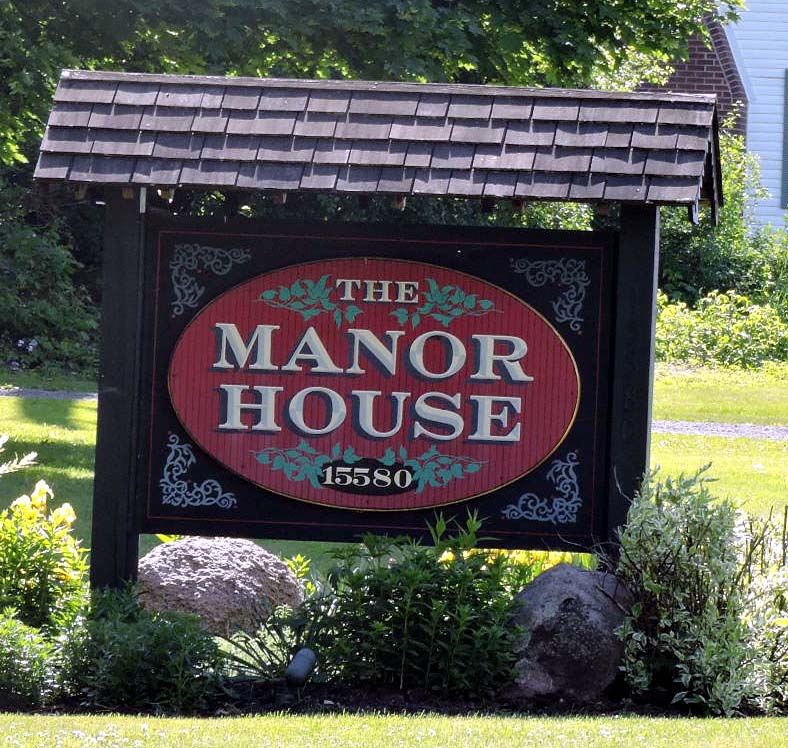
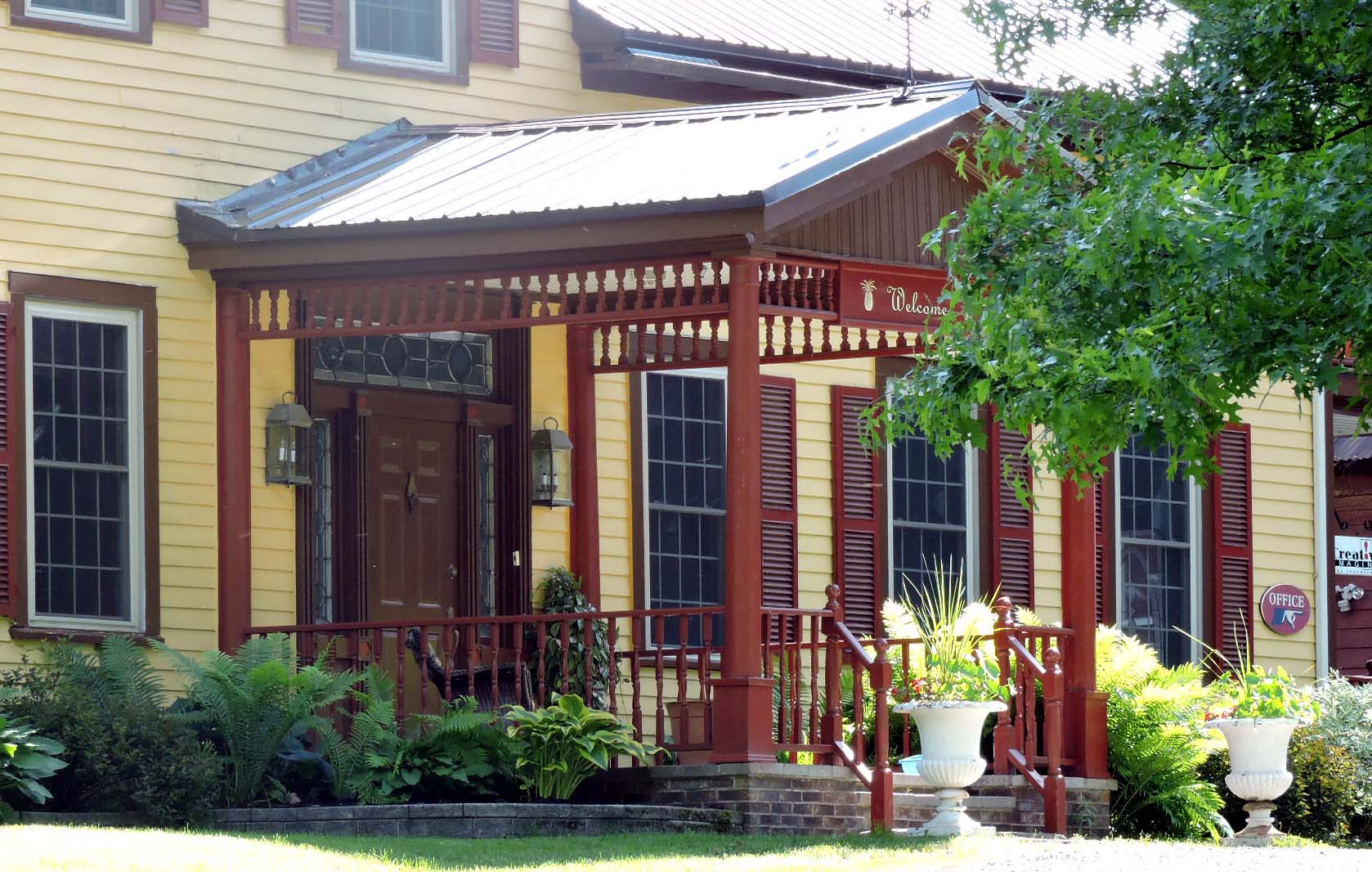
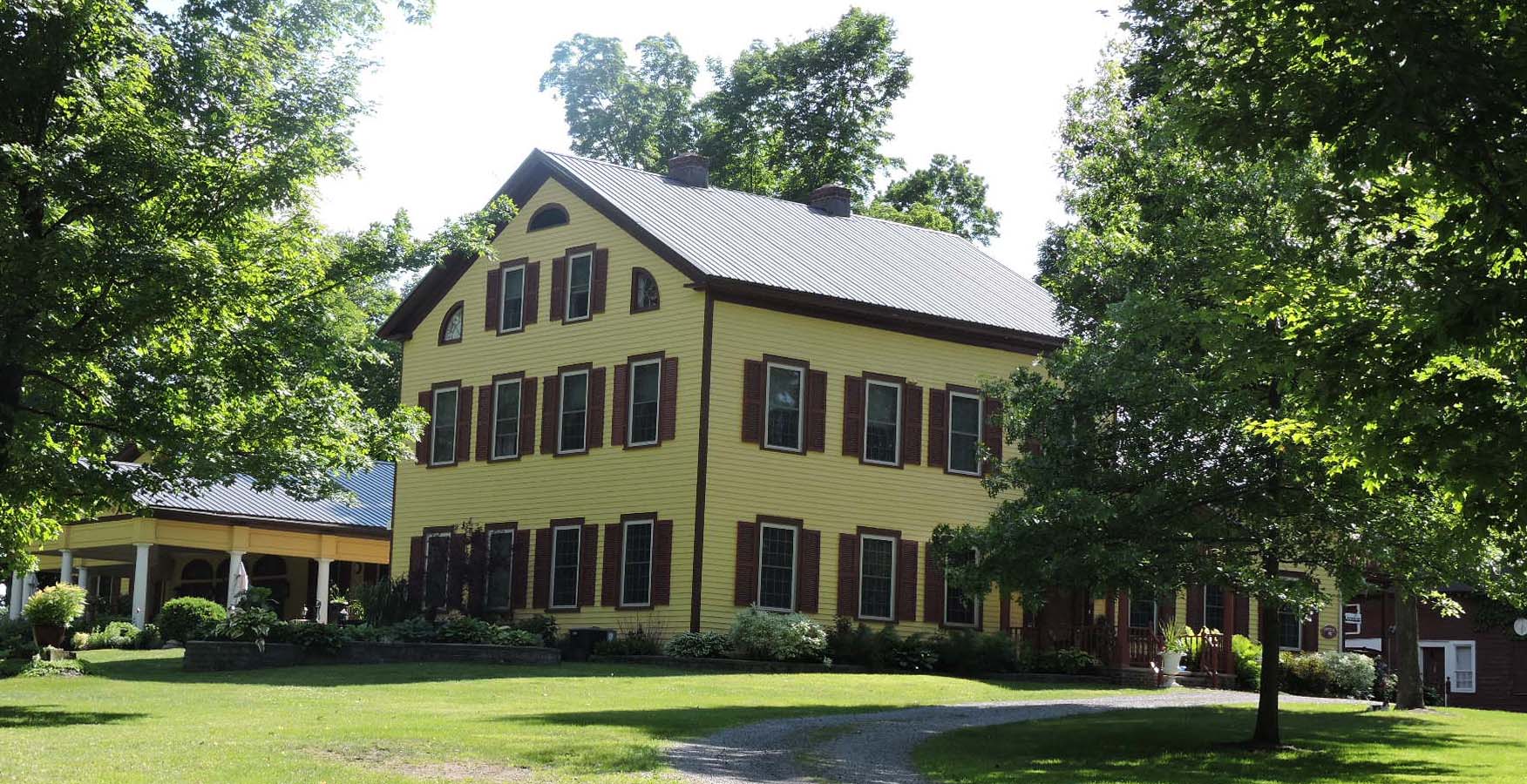
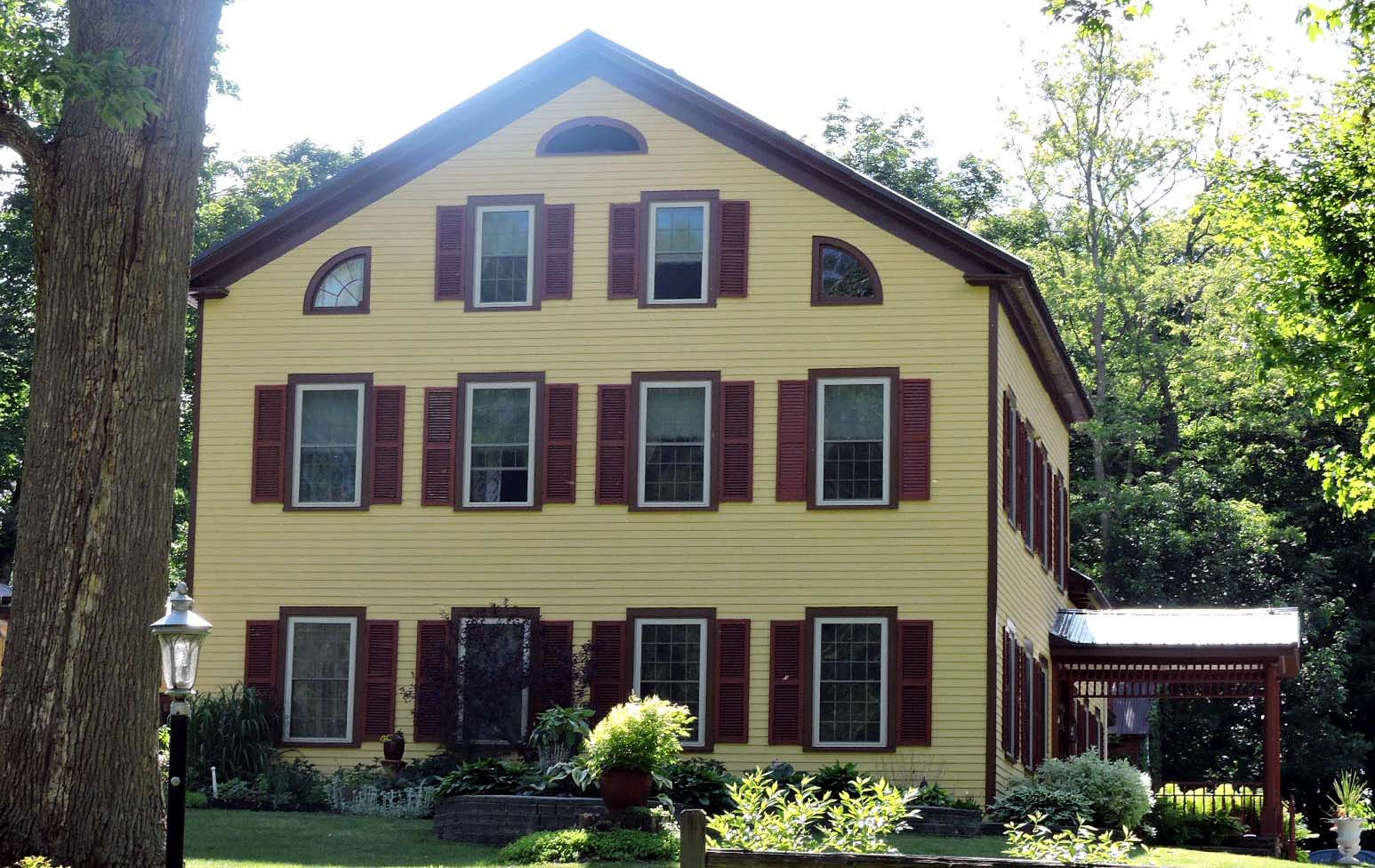
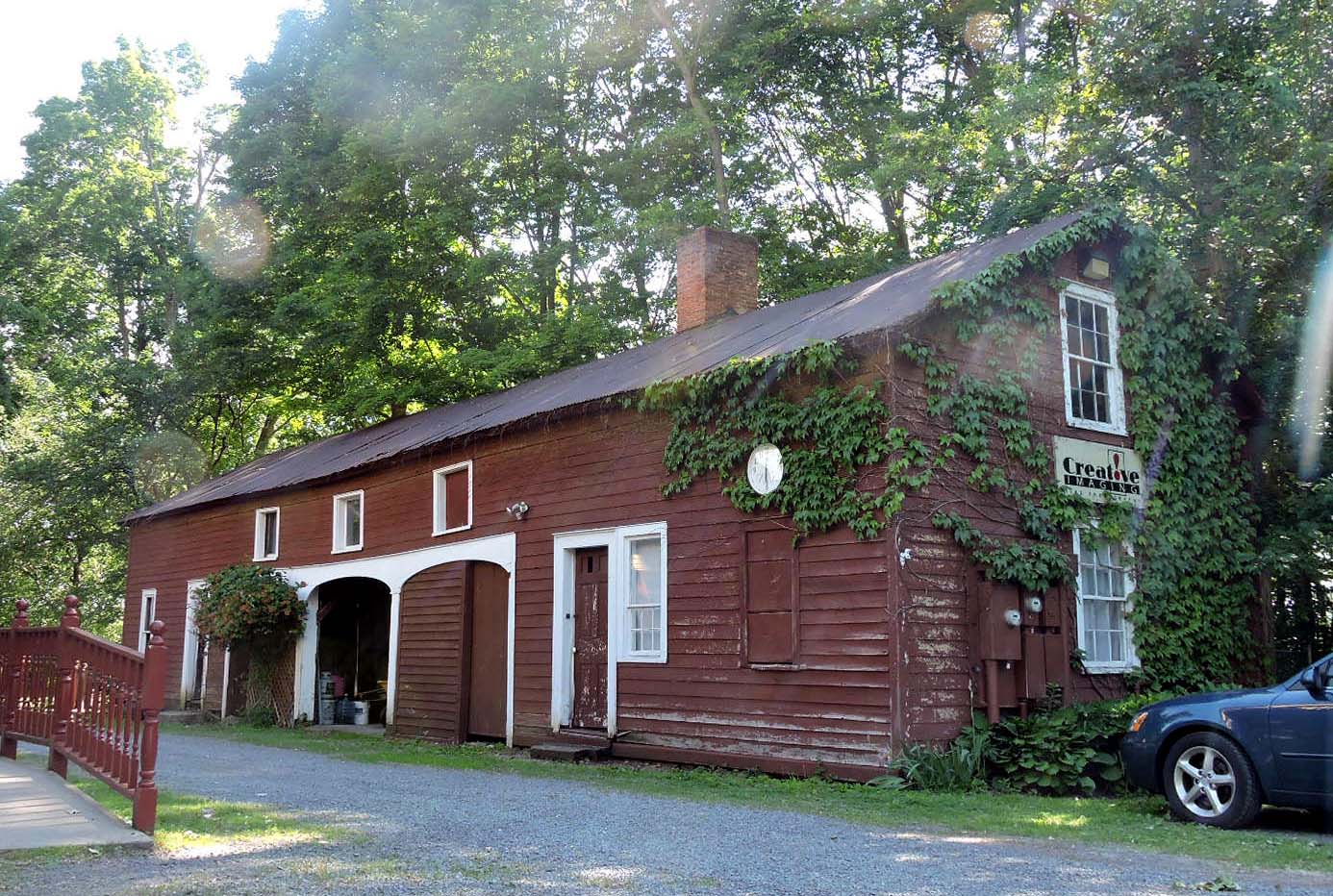
From the time the first railroad train steamed into the hamlet of Pierrepont Manor May 28 1851 almost to the day of his death on December 20 1885 a little man wearing a long cape and followed by a small dog met every train that passed through that community, always with watch in hand to check the scheduled time. It was William Constable Pierrepont, one of the most outstanding citizens this part of the state has ever had, president of the Watertown & Rome Railroad company from April 10 1851 until his death, having succeeded Orville Hungerford, city, first president of this first railroad company who died before it was completed.
A little way up the street that connects the railroad station at Pierrepont
Manor with the state highway from Watertown to Syracuse, William Constable
Pierrepont lived in his big three-story, frame Manor house of 26 rooms.
It was an impressive structure with tall pillars in front and a beautiful
colonial doorway with leaded glass transome and sidelights. This house,
sitting far back from the road in a picturesque grove of trees, was built
in 1826 practically the same time that the LeRay mansion was built, and
occupies 7.17 acres of grounds with its commodious carriage house still
standing at one end and close to the mansion. A more modern, glass door
has replaced the original colonial one. Gone are the tall and graceful
pillars. A porch of more modern type has been built across the front and
pea-green asbestos shingles now cover the exterior.
Inside, however, much of the original beauty and character has been retained.
In Pierrepont's day the house was heated with Franklin stoves. A small
pane of glass gave a tiny window to each bedroom door, and one bedroom
is known as the "Bishop's room," for here the bishop always
slept when in Pierrepont Manor. Pierrepont, of Norman descent, son of
Hezekiah Beers Pierrepont and Anna Maria, daughter of the great North
Country landowner, William Constable, was a great Episcopal churchman
like the Constables and McVickars and in 1836 built Zion Episcopal church
across the street from the Manor house and land-office. Next to the church
is the cemetery, a huge flat slab of gray granite plainly inscribed lying
prone upon the lot where he is buried. Small, curved-top stones designate
the graves of his wife, Cornelia Anna Butler Pierrepont, and his children.
It was in 1822 that Pierrepont came to Pierrepont Manor to manage the lands of his father of Brooklyn, who at one time is said to have owned 500,000 North Country acres. The little two-room land-office was first built, one room containing the vault where he stored his cash. The building is now the public library. At the south side of the Manor house the squire maintained a beautiful sunken garden. In the summer of 1830 he brought his bride from Oxford, NY. In 1840-1843-1846-1847 he served the town of Ellisburg as supervisor. He was also assemblyman 1840-1 and his wealth was estimated at $500,000.
Only two other families have ever owned the Manor house property. December 1 1899 Pierrepont's executors sold the place to William M McConnell and from him it went to his son, Ralph B McConnell, who sold it April 18 1935 to Guy E Mendell, Albany insurance agent, and wife, the present owners, and summers Kent E Mendell, brother of the owner, resides with his wife in the mansion, which was peopled with 35 persons including servants in the days of William Constable Pierrepont.
The Manor House hosts Weddings and has nice Victorian Gardens:
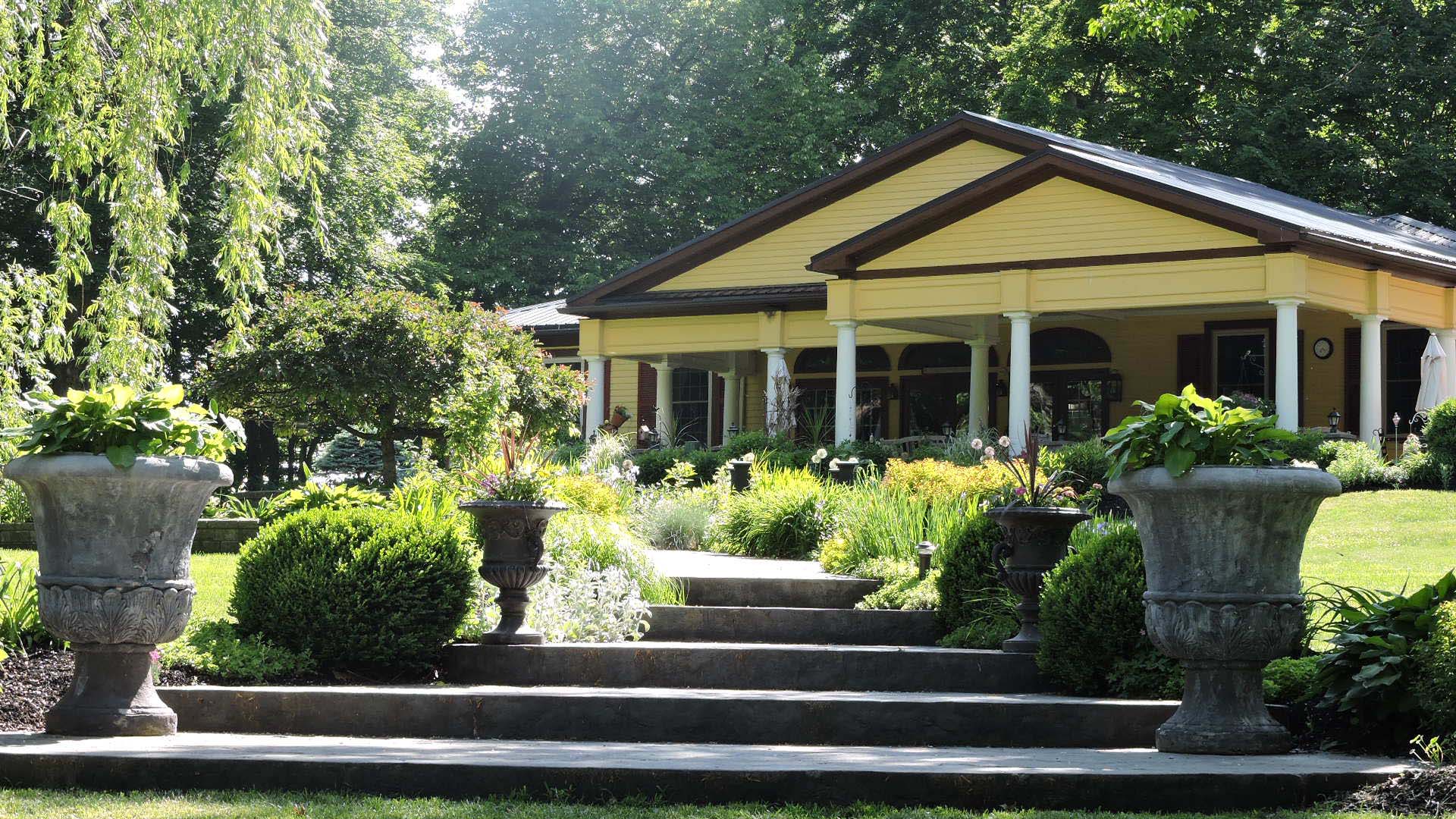
A century ago Joshua Moore, who had been admitted to the bar in this county in 1839 along with Lysander H Brown, N P Wardwell, Allen Nims and others, was suddenly recognized as one of the ablest lawyers of the county and in February 1846 was appointed district attorney. That fall he was elected for a full term, first one under the new state constitution of that year and served until James F Starbuck succeeded him in 1851.
Early in his legal career young Moore, son of Joshua Moore of Clinton county, became a partner of William Ruger, noted teacher and mathematics book author as well as lawyer, under the name of Ruger & Moore. Local newspapers of 1850 show Mr Moore alone in practice over Tubbs' hat store in the east end of "Woodruff's block." In 1852 he formed a new partnership, with Levi H Brown, who had been admitted in 1846 under the name Moore & Brown, but death ended Mr Moore's career April 19 1854 and shortly thereafter Allen C Beach became partner of Mr Brown under the named of Brown & Beach.
December 29 1848 Mr Moore paid $2,500 to Joseph R and Rhoda C Hungerford, parents of his wife, for their Georgian-type brick residence shown above, now known as 240 Stone Street. Mr and Mrs Hungerford had come to this county from Highgate, Vermont, he having on December 16 1835 bought 818.75 acres of Pine Plains timber land from John Felt, Micah Sterling and Isaac Bronson.
This was in two plots, one of 440 acres, two-thirds of which he sold to Stephen S and Samuel W Keyes, also of Highgate, who became partners of his under the name of Keyes & Hungerford in a lumber mill at Dexter. Joseph Burchard Hungerford purchased the brick house on Stone Street from Edward Swain and Esther Bragg Massey April 29 1844 for $2,600. Mr Massey, farmer and brick manufacturer, son of Hart Massey, one of Watertown's original settlers, resided in a brick house which he had built in 1828 on South Massey Street where Attorney Roswell F Taylor's house now is. November 30 1840, E S Massey bought of his father two acres of land on Stone Street between Massey and Sherman Streets.
Apparently he built the Hungerford house there to sell at about that
time and Mr Hungerford after residing in it four years disposed of it
to his distinguished son-in-law. After the death of Mr Moore in the spring
of 1854 the Stone Street residence, which stands between Mercy hospital
and the old John E Kemp stone house, went to his widow, Demaris E Hungerford
Moore who resided there until her death on April 2 1885. Under the provisions
of her will the property went in life-use to her mother, Rhoda C Hungerford,
and then to Miss Sophia Hungerford, cousin.
The latter resided there until her death September 29 1909 and November 25 1911 her executors, Calvin S Hungerford of Corning and Robert Lansing, sold it to Attorney Nathaniel F Breen. August 2 1920 Mr Breen and wife sold it to Mrs Cora LaFontaine, wife of Dr E W LaFontaine of Smithville, local physician, and they have since resided there.
Zillow pics before sale:
AFTER the sale:
Joseph Wells House, 1829
29340 Ashland Rd.
Chaumont, NY (near Three Mile Bay)
Owners: Greg and Rose Hubbard
Just outside the village of Three Mile Bay in an area known as Wells
Settlement, this finely proportioned two-story limestone house sits near
a pond and rolling
countryside. It is built of evenly coursed blocks of stone with a wooden
ell. In the gable end facing the road the dates 1829 and 1906 are inscribed
with the initials J.W.
The original owner was Joseph Wells, one of eight brothers who came from
Concord, New Hampshire. His brother Isaac’s stone house was nearby
but is now lost.
Today’s owners appreciate the rich history of the house and look
forward to sharing some of its stories.
An inscription in the square block of limestone in the very apex of the front gable of this modest old stone house in the Wells Settlement area near Three Mile Bay in the town of Lyme indicates that it was constructed in 1829. Its original owner was Joseph Wells, one of the eight Wells brothers who came from Concord, NH, about 130 years ago to take up farms and found that district now known as Wells Settlement.
One of those brothers was Isaac, who first came to Sackets Harbor in 1813 participated in the War of 1812 and then moved on to Lyme to permanently locate, becoming town clerk, justice of the peace, supervisor in 1837-1846-1847 and assemblyman in 1855. Those eight brothers, sons of Hezekiah Wells, Revolutionary veteran from Concord, were nephews of Luther Rawson who headed a surveying party through the preesent Lyme area in 1797. It is a matter of family tradition that Rawson was responsible for the Wells brothers migrating to this county.
Vincent LeRay de Chaumont sold the land to the Wells brothers, Isaac acquiring his first tract April 9 1827. His brother, Joseph, however, beat him by a few days acquiring a 50-acre plot March 29 1827 from Mr LeRay. There Joseph is said to have first constructed a log cabin, but after getting his land well cleared for a farm he razed the cabin and erected the stone house from limestone obtained near by. From time to time he added to his original land-holdings there until he had a substantial farm. He became one of the leading farmers in the community and his stone house was the next one towards Three Mile Bay from the Isaac Wells stone house on the street or road from Three Mile Bay's Main Street to the railroad station.
Joseph Wells resided upon the farm until his death March 23 1858 his children being John Merritt Wells, Simeon Wells, Mrs George (Anne Sally) Herrick, George Wells, Cerene Wells and Ithamar Wells. On November 1 1867 the estate of Joseph Wells sold his stone house and 75 acres of land to his son, John Merritt Wells, for the nominal consideration of $1. At that time John Merritt Wells had been back from the Civil war only a couple of years having served in Company M, 10th NY Heavy Artillery.
He had gone into the service as a bounty man and lived until about 38 years ago, his farm passing to his estate from which his son, John Merritt Wells Jr, acquired it. The latter and his wife, Jennie O Wells, parents of Dean J Wells of this city, sold the property to William C Constance of Three Mile Bay April 1 1910. Mr Constance resided there until his death December 16 1943. Mr Constance was a native of Rosiere, born May 23 1867 son of Lawrence and Barbara Smithling Constance, and was married February 10 1891 to Miss Addie M Stewart, who pre-deceased him.
Since the death of Mr Constance the stone house and land has been jointly owned by his children Mrs Wesley E (Hazel C) Dick, city, and Willard L Constance, the latter of whom had remained with him on the farm. This, however, has now been reduced to ten acres and Mrs Dick and Mr Constance and their families use the place as a summer residence.
The following information is as it was written in "The Founding Of The Schools in Lyme And The Pioneers Who Built Them"
"THE WELLS (WELLES) FAMILY
The Wells family consisting of the mother, Sarah (Edwards) Wells and her
eight sons came to what is now the town of Lyme about 1819. The land had
been located in 1818 and was about two acres square. Where the Depot
Road is now and the surrounding area, was covered by a hansome grove
of pines.
The father of the family, Hezekiah Wells, died and was buried on the Oxbow
farm on West Canada Creek in Herkimer county. The son Isaac was born in
Dutchess County and the others were born in Bolton, Connecticut. The stone
reads: Hezekiah Wells died June 14 1818 age 50 yrs., 9 mos. 8 das. Sarah
his wife died June 15 1847 age 82 yrs. Their sons were Nathaniel, Deacon
of the Baptist Church, Isaac, member of the State Assemby 1856 died there,
and is buried in the family cemetery on his farm, Joseph, built the
stone house at the forks of the road; the date 1829 is on the stone
peak of the end toward the road, Garry, the railroad was built through
his land in 1852; Harry, Buell, Seldon, (first wife was Nancy White),
she is buried in the Wells cemetery. He remarried and moved to CanadA
All except Isaac and Seldon are buried in the Wells cemetery. Hezekiah
Wells, the father of this family was the son of Hezekiah Welles, a Revolutionary
War veteran, and Phoebe Talcott. The Wells name was originally spelled
Welles. The first Hezekiah was the great-great-grandson of the fourth
governor of Connecticut, Thomas Welles who came from England to America
about 1636 and was one of the first settlers of New Hartford and Wethersfield,
Connecticut. This information on the Wells' Settlement School and the
Wells (Welles) family was given to me by Mrs William Eves of Carthage,
NY. Mrs Eves' grandmother was a Wells. Mrs Eves was Thelma Mattis before
her marriage."
Laurence W Jewett, young LeRay dairyman, owner and occupant, of this attractive old limestone house and its nearly 188 acres of land on the Watertown-Evans Mills state road near the intersection of the Sanford's Corners-Pamelia road, has the distinction of residing in the same neighborhood where two of his great-great-grandfathers pioneered about 14 decades ago. In fact a portion of the farm upon which this house stands was bought by his gi'eat-great grandfather, Fayette Herrick, from James D LeRay de Chaumont 130 years ago and his great-great-grandfather, Captain Ezekiel Jewett, coming with Hart and Isaiah Massey and Jonathan Cowan in the spring of 1800 was one of the very first settlers of what is now Jefferson County.
Captain Ezekiel Jewett was a veteran of the American Revolution and having bought 1,200 acres of land from Roswell Woodruff May 31 1819 Sanford's Corners became known as Jewett's Corners and Jewett's School House. From that time to this there has been a member of this Jewett family among the leading farmers of the area, which has also featured a member of the Herrick family in the same area, and this house shown above is but about two miles from where Captain Ezekiel Jewett lived.
Laurence W Jewett is a son of Mrs Blanche E Herrick Jewett and the late Preston E Jewett, who died May 2 1941 on the nearby homestead farm which had been in the Jewett family since 1835. Preston E Jewett was a son of William M Jewett, grandson of Thomas Jewett and great-grandson of Ezekiel Jewett. Mrs Blanche E Herrick Jewett was a daughter of George W Herrick, who was a son of Houghton Herrick and grandson of Fayette Herrick. Laurence W Jewett, who has attained some eminence in modern methods of cattle-breeding, jointly with his wife, the former Miss Bernice P McClure, former teacher in the Watertown School of Commerce, bought this house and farm September 24 1942 from Fred Gonseth.
The house of native limestone fashioned in the Georgian cottage style was probably built 125 to 130 years ago, except for the frame wing with dormers, which is of modern construction. Not only is the house immaculately maintained in the best state of repair but it retains its ancient atmosphere. The farm is composed of a half dozen parcels, the largest of which was 110 acres.
Mr Gonseth purchased the bulk of it July 8 1940 and the balance July 17 1940 from the estate of Mrs Mary Belle Emond Webert, who had died October 25 1938. Mrs Webert inherited it from her father, the late John F Emond, prominent Granger, Democrat and hay-presser, who one year pressed over 9,000 tons and shipped 900 carloads of hay. He was a son of John B Emond, another outstanding farmer of LeRay who had acquired a part of this farm from Houghton Herrick and who was a son of Joseph Emond. The latter, born 1785 in France, served seven years under Nopoleon fighting in the Battle of Victoria. Joseph settled in LeRay in 1825. June 1 1815 J D LeRay sold 123.67 acres to Frederick and Fayette Herrick in this vicinity for $1,188.63. May 30 1937 Frederick sold his interest to Fayette. Later parcels in the Laurence W Jewett farm were possessed by Houghton and Francis Herrick and in the 1890's were transferred to John B Emond and from his estate to John F Emond.
Perhaps no house in Watertown is wealthier in its history than this native limestone dwelling at 246 Stone Street, despite the fact that for many years it has been used as an apartment property and completely overlooked by the passerby.
Apparently its age is 120 years, for carved in the fireplace mantel of the living room is the inscription: "Kemp Home 1826." That carving was doubtless made long after the house was built, for none of the Kemp family owned it until John E Kemp purchased it from Elijah J Clark and his wife, Jane A Wright Clark, March 23 1866. Unquestionably Hart Massey, one of Watertown's first settlers who originally owned all of that section, or George A Boalt closely connected with the Masseys, built the house.
A map of Watertown 1830-1835 shows George A Boalt living there in 1835 and there was then not another building on the north side of Stone Street west of what is now Arcade Street. George A Boalt was a commission merchant, partner of Edward Swain Massey, Watertown's first coal dealer, and Mary Esther Boalt, probably Boalt's sister, was the wife of Edward Swain Massey's brother, Solon, one of Watertown's early literary figures, author of "A Link in the Chain," that invaluable early Watertown historical series.
October 19 1850. finds Hart and Lucy Massey selling this property to Lott Frost of Albany, for $1,500 and the deed refers to the place as heretofore occupied by George A Boalt. Frost sold to Charles A Bussell May 11 1852 and October 20 1854 Russell disposed of it to Mrs Mary M Grannis. In the spring of 1855 it was bought by Elijah J Clark, then 32 and native of Denmark, NY, who had come here from Adams to join his brother, Samuel, in the milling business.
From the record one concludes that Elijah Clark was not a financial success,
although a man of real greatness and strong character. Born September
30 1823 of Elijah and Elizabeth Parsons Clark he concluded his schooling
here in the old Jefferson County Institute, taught four years, went to
Adams in 1844 starting the Jefferson County Democrat with Josephus C Hatch.
In three years he bought Hatch out and conducted the paper alone until
he sold to Justus Eddy in 1855 and came to Watertown. In December 1856
Clark and Royal Chamberlain bought The Jefferson Union, a Watertown Democratic
weekly, from John W Tamblin. Then in three years Clark purchased Chamberlain's
interest and was editor and publisher of it in the Fairbank's block at
the junction of Court and Arsenal Streets until the spring of 1866 when
he sold to Rensselaer Alston Oakes, editor-historian. That was the time
he also sold his stone house to John E Kemp, a powerful local financial
figure and business man, who early was a member of the drug firm of Kemp
& Walton.
He had made money in mail contracts and transporting Civil war soldiers, and became a founder of the City National bank March 17 1890 and its president the next year. Long before, he had reaped a fortune from South Dakota lands, founding and naming Watertown, SD. He died April 16 1896. The stone house remained in the Kemp family until April 30 1921 when Fred B Marshall, the present owner, bought it and converted it into an apartment house.
After selling the Jefferson Union, E J Clark prospected unsuccessfully in western oil fields, published a Democrat weekly and sold insurance in Kalamazoo and returned here in 1870 to follow insurance almost until he died in a boarding house at 4 Mechanic Street, May 28 1903. The Times said of him: "Mr Clark was a strong, earnest man of great force of character and did his work well in all his working days." It said also that he was prominent in newspaper circles in the state and conducted a strong Democratic journal. His son was George F Clark, retired Brownville Paper company officer, who died March 14 1941.
501 West Main St
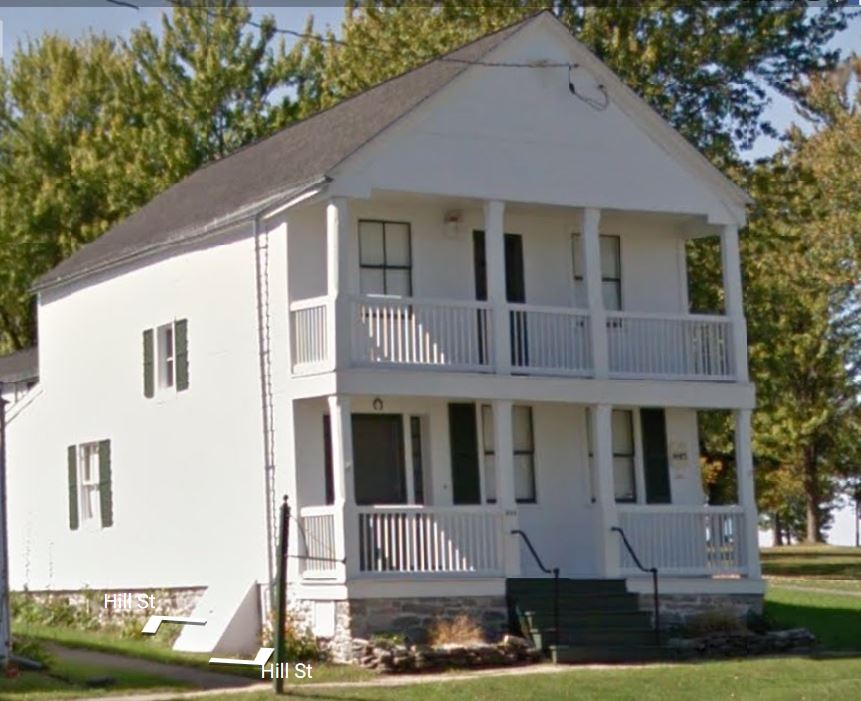
A great deal of interesting history is woven into the story of this old house, now the Pickering-Beach Historical Museum at Sackets Harbor, but the bulk of this history is traditional and only a small percentage of it is documentary. There is in consequence a considerable amount that is confusing and in conflict. The outstanding thing about the house, which faces Main Street and stands at the corner of Hill Street (long familiarly called Bunker Hill Street) next to the old battlefield, is that it was once the home of Captain Augustus A Pickering. Captain Pickering won a page in history for taking the first commercial ship into the port of Chicago. That was on June 14 1834 and the ship is said to have been the 80-foot schooner "Illinois" carrying 50 barrels of flour, 50 barrels of pork and 104 North Country men determined to settle in the west.
When the "Illinois" sailed out of Sackets Harbor May 12 1834 a village character reported that "the cabbing was full of wimming and the rigging was full of waggings," which was a poetic if homely statement. Local genealogists do not seem to have traced Captain Pickering's family tree, but it would seem plausible that he was of the New Hampshire John Pickering line. Exactly when he came to Jefferson County is unknown, but it has been said that he saw Henry Eckford create the warships of Commodore Chauncey's fleet at Sackets Harbor in the War of 1812 and that he himself held the unique post of designer, builder and master of his own ships. His career ended by suicide in the Province of Upper Canada at the head of Lake Ontario June 5 1844 because his new ship "Ariadne" was a shade too wide to go through the canal.
Tradition has it that this house was built in 1812 by Captain Pickering, but there is no deed on record to support this. In fact there are only three Pickering deeds on record in the county clerk's office. The first of these credits Joshua Pickering with having paid Elisha Camp $200 for three lots on the south side of Main Street January 1 1816. This property also bordered on Bunker Hill Street and the sale would indicate that the house was built about that time, but Mrs Amy Beach Ewers is reported to have said the house was used as a hospital in the War of 1812.
The only other deed of land to a Pickering, except Duck island to Joshua June 6 1817 was a lot on Bunker Hill and Washington Streets to Augustus A Pickering July 8 1836. Joshua Pickering died, about 1822. Probably he was the father of Captain Augustus, but there is no such record here. Caroline, daughter of William White, was wife of Augustus, who died leaving six minor children. One was Gustavus A, whose widow January 20 1887 quitclaimed her interest in this house to Mariette Hay, Caroline Fonda and Olivia Beach, daughters of Augustus. The description in this deed makes it clear that the property included the parcels bought by Joshua in 1816 and Augustus in 1836. Olivia was the wife of Lieutenant Gov. Allen C Beach and mother of Mrs Ewers, to whom the place eventually came. Mrs Ewers died in Bermuda January 8 1936. Her will, dated October 18 1935 gave the historic house to Sackets Harbor for a museum and June 10 1941 her executor transferred it to the village.
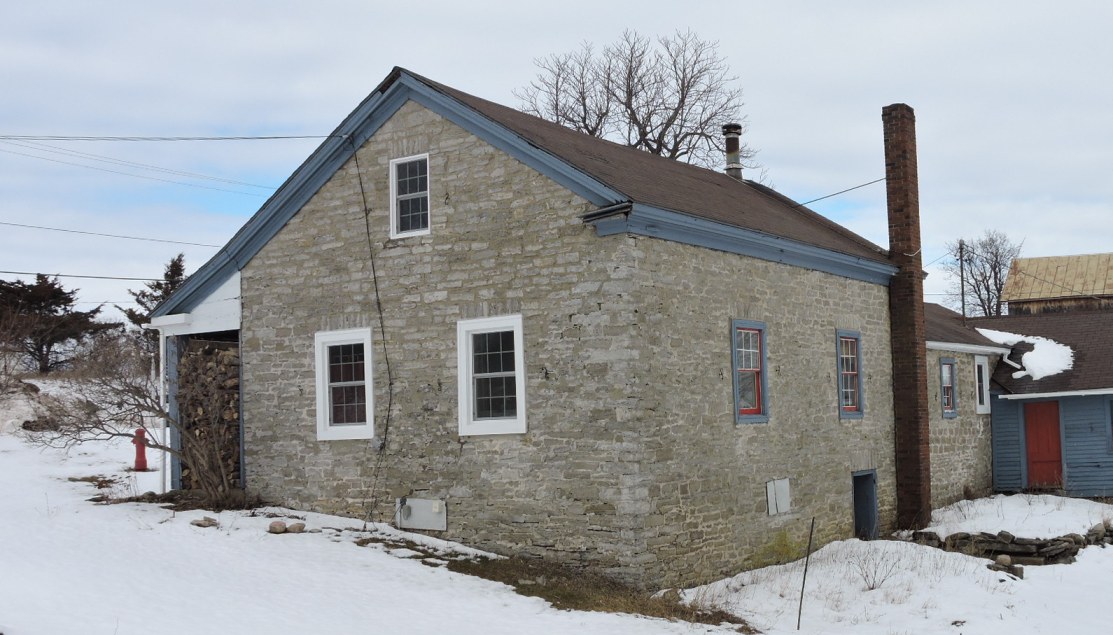
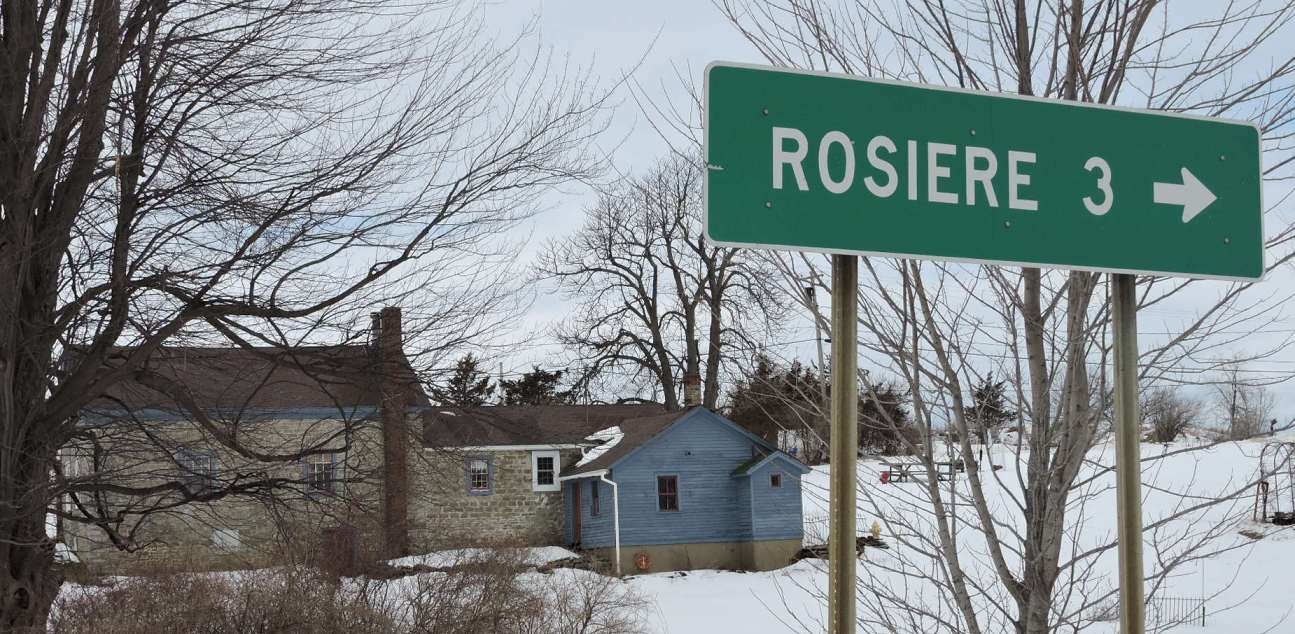
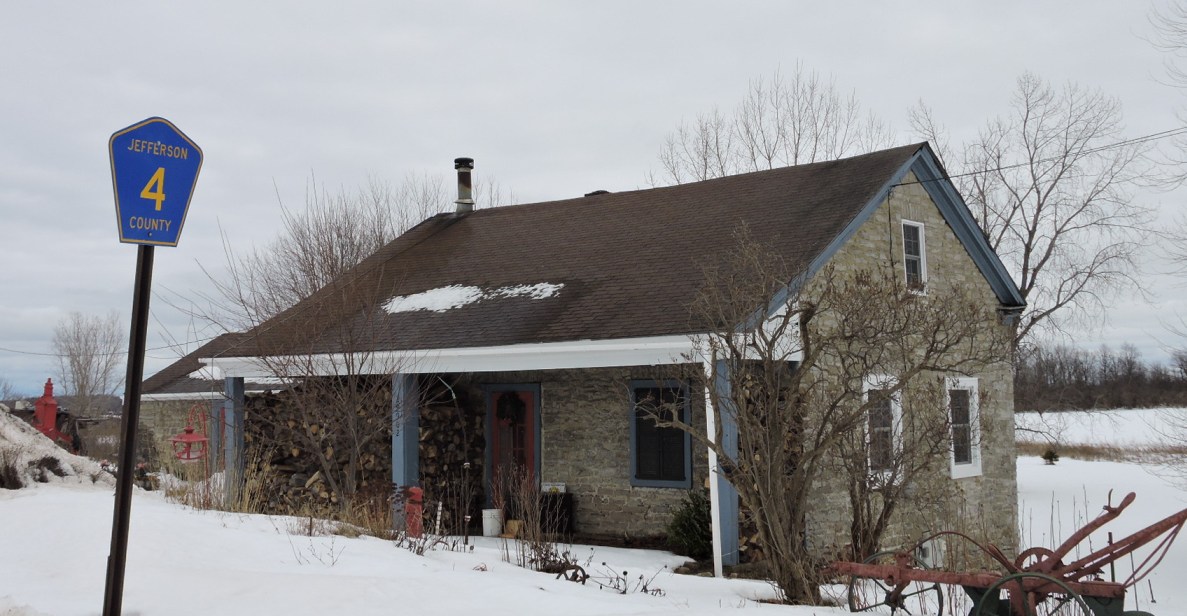
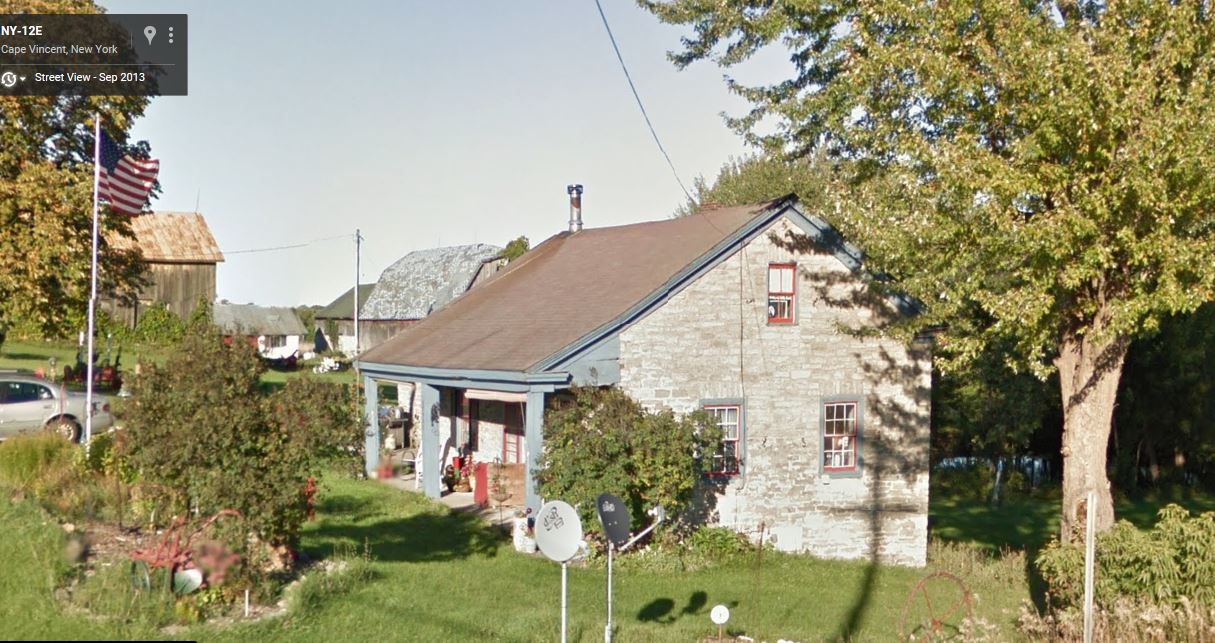
This quaint little native limestone house, eight room residence on a 300-aere farm owned by Edward Docteur of Cape Vincent, and tenanted by Ralph C Docteur, occupies land once owned by Count Pierre Francois Real, prefect of police under the great Napoleon. The house itself is well over a century old, but exactly when or by whom it was built there is no disclosed record. It stands on low ground in the angle where the Rosiere road taps the Watertown-Cape Vincent state highway and directly across the road from it is the historic marker directing the traveler to the memorial altar on the site of the old French Catholic church erected in 1832 by James D LeRay de Chaumont.
Located in that region acquired by the Napoleonic refugees who sought haven in the present town of Cape Vincent after Waterloo, the house might have been built by one of them. It is on what is known as lot 388 of No. 4 of the Macomb tract and the records show that February 17 1820 James LeRay sold Count Real 1,000 acres, which took in part if not all of lot 388. Real was the staunch Napoleonic admirer who built the Cup-and-Sauccr house in the village of Cape Vincent as a domicile for Napoleon if the plot to rescue him from St. Helena were successful. Adjoining this farm was more land which Count Real had bought from Camille Arnaud, another Napoleonic refugee, August 21 1819.
Apparently the original farm of Mr Docteur consisted of 100 acres comprising two 50-acre parcels described as beginning in the center of the old Cape Vincent turnpike a specified distance from Kent's Creek bridge. One of these 50-acre plots Count Real sold to Daniel Fitch December 27 1821. Later it and the companion plot had many ownerships including Roswell T Lee, (second owner of the first grist mill in the town) and by Henry Ainsworth and William Estes who sold to Reuben Dye.
June 22 1839 Dye sold the 100 acres to Philader A Church for $1,500 the price indicating that there was a house on the property at that time at least. March 26 1841 Church sold to George C Sherman, Watertown, who July 2 of the same year disposed of the property to Peter Reff, native of France and probably son of the Peter Reff who had fought under Napoleon and came to America at 40 to locate in Cape Vincent. At any rate John and Julia Reff, children of the younger Peter who died at 35 in 1852 sold the house and lands to Joseph Favret for $3,563 October 15 1859.
From Favret the place descended to his daughter, Catherine, who was married to Edward Joseph Docteur, a New York Central employe who died January 31 1933.
Mrs Catherine Favret Docteur pre-deceased her husband leaving a will recorded October 8 1929 by the terms of which her husband was to have a life-use of the property and after his death it was to go to their son, Edward. The latter succeeded to full title after his father died. That there have been interesting incidents and associations of this property forever lost to history there seems little doubt.
The vintage of this simple-typed limestone house constructed of material quarried nearby is probably of 130 years ago and it is not unlikely that the builder may have been Paul Anthony, that native Rhode Island stone mason who erected a number of stone houses and other stone structures in the towns of LeRay, Pamelia and Brownville is the fore part of the 19th century. Anthony first came tto Boonville from Rhode Island in 1803 but by 1809 was located in the town of LeRay. The house shown here is located a short way northwest from the Watertown- Evans Mills state highway near the intersection of the Ross's Corners road with that highway.
Since October 12 1936 when it and the 63 acres of land which goes with it was sold by Floy L Johnson as executrix for Mrs Hettie L Herrick it has been owned by Floyd J Borland, well known paper maker who for some time was superintendent of the Champion paper mill at West Carthage and later of the Herrings mill of the Taggart corporation. Back of the Borland purchase the chain of title went back through the old pioneer Herrick family of the town of LeRay for more than 120 years.
Fayette and Frederick Herrick were among LeRay's earliest settlers in the region just a short distance northwest of Sanfords Corners. The record shows that June 1 1815 these two Herricks bought 123.67 acres of land where this house is from James D LeRay for $1,188.63 and this house was probably erected shortly after that for the new owners if LeRay had not caused it to be built before for development purposes.
May 30 1837 Fayette Herrick and his wife, Betsey, deeded the north half of this parcel to Frederick Herrick and Frederick and his wife, Betsey, on the same day conveyed the south half to Fayette. It is upon this south half that the stone house stands. The property remained in the possession of Fayette and his wife, Betsey, until March 8 1873 when they transferred it to their son, Houghton Herrick.
Houghton Herrick retained it for more than 30 years, dying in 1905 when it passed to his widow and son, George W Herrick. On April 22 1911 George W Herrick and wife, Hettie E, together with Sarah N Herrick, widow of Houghton Herrick, disposed of the place to Charles G Fountain and wife, Cola L Fountain, and on July 27 1936 they deeded it to Floy L Johnson as executrix of the estate of Hettie L Herrick. George W Herrick was a well known Civil war veteran and lived only a few months after disposing of his interest to Mr and Mrs Fountain in 1911. His death occurred on December 8 of that year
Mr Borland's title to the property shows that it consists of slightly over 63 acres comprised of two parcels, one of 61.885 acres, which is the south half of the 123.67 acres bought by Fayette and Frederick Herrick from LeRay in 1815; and the other of 1.21 acres purchased in after years to add to the former.
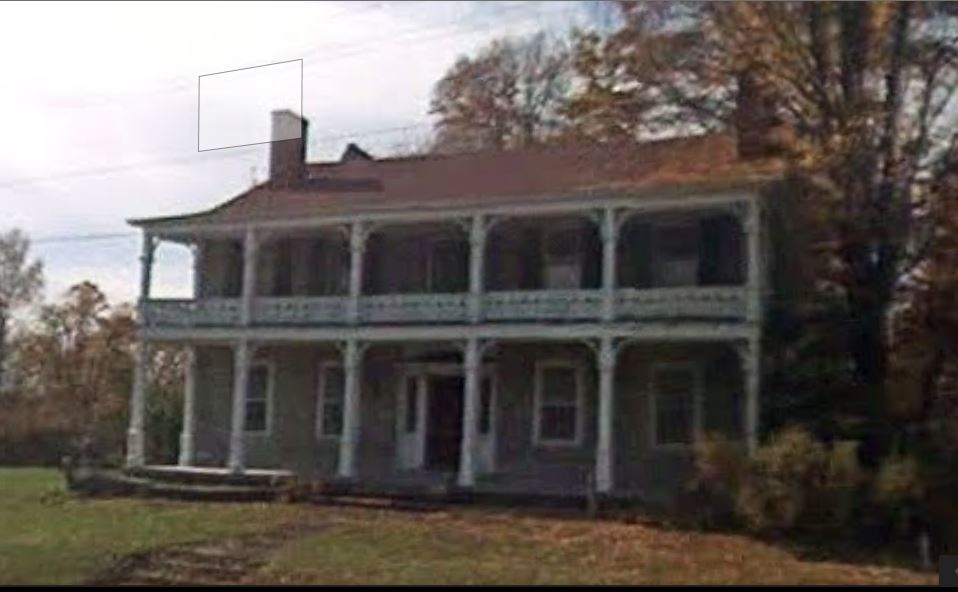
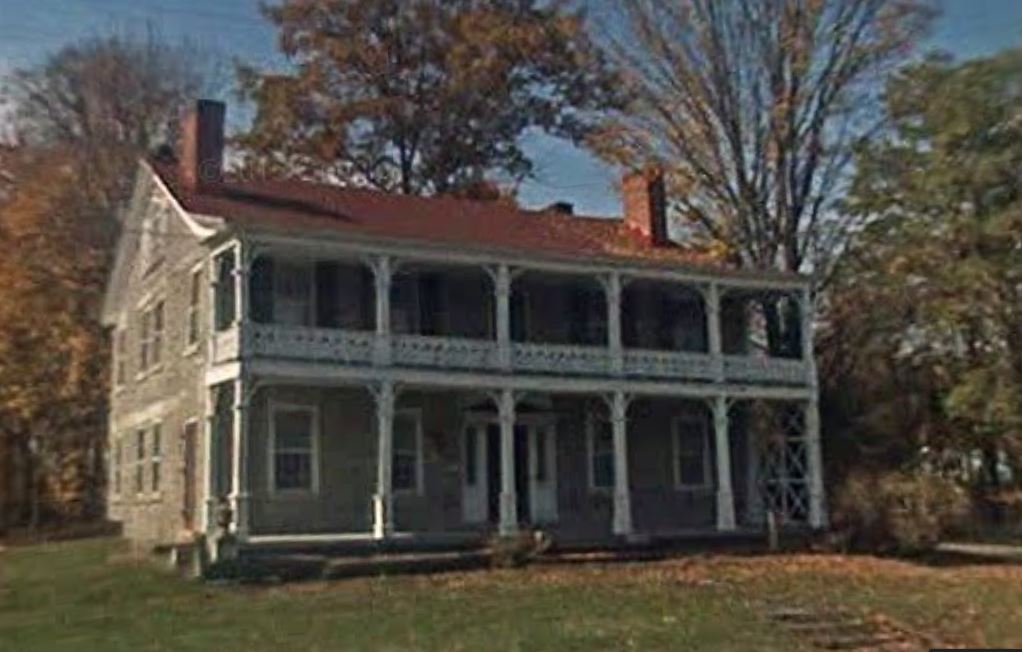
Jesse Talcott, born at Middletown, Connecticut, in 1775 came to the town of Leyden, Lewis county about 1798 with his father, Hezekiah, to take up extensive lands and water rights on the Sugar river founding the hamlet of Talcottville. There, in 1795 Bela Butterfield had built the first sawmill in Lewis county and according to tradition Jesse Talcott started construction in 1800 on the beautiful Georgian limestone house shown above.
The stone was hauled by ox-team from the banks of the Sugar river and it is said that it took four years to construct the house with exterior walls a foot and a half thick and interior beautifully arranged and finished. A handsome front entrance leads into a broad central hall, whence a most attractive staircase leads to the second floor. The inside woodwork is of the finest hand-craftsmanship and at the several fireplaces are white, wooden mantlepieces exquisitely wrought, each with a different ornamentation.
The Talcotts were aristocrats in their ideas and blocked any industrial development of the locality by refusing to sell any waterpower rights or to dispose of village lots to mechanics. When Jesse Talcott died he left this house and farm to an unmarried daughter, who later became the second wife of the grandfather of Mrs Edmund (Helen M W) Wilson of Red Bank, N J, who with her husband, a New Jersey lawyer, acquired the property about 30 years ago and have since used it as a summer home. Mrs Wilson claims no descent from the Talcotts, her grandfather's eight children having been by his first wife. However, the second wife willed a lifeuse of the place to him and then to an uncle of Mrs Wilson. From him Mr Wilson purchased it.
There is a lot of distinction that goes with the history of this house.
Thomas Baker, an early inn-keeper at Talcottville, turned this fine old
house into a high-class tavern of the romantic and picturesque stagecoach
days. It was on the direct route from Utica to the north country and drew
the patronage of many early notables. Mrs Wilson's, Grandfather Baker
was himself of distinguished origin. He was a Jackson Democrat, served
as postmaster and also as assemblyman. His wife's great-grandmother was
a daughter of one of the Earls of Essex.
Mrs Wilson's father was a direct descendant of a sister of Cotton Mather, famous early liberal clergyman in Colonial New England days. Although not related to President Woodrow Wilson, Mrs Wilson's husband, Edmund Wilson, served as attorney general of New Jersey at the same time Woodrow Wilson was governor of that state and they were such warm friends that when Woodrow Wilson became president he offered Edmund Wilson important Washington posts, which he declined. Edmund Wilson attended Exeter academy, was graduated from Princeton in 1885 and later from Columbia law college.
Mr and Mrs Edmund Wilson's son, Edmund Wilson, is the author of several books and for some time has been literary critic on The New Yorker magazine
To Watertown's older residents this imposing native limestone house on the east side of .lower Washington Street, will always be remembered as the residence of this city's first mayor, Colonel George Walton Flower. The number of the house now is 311. Older brother of Gov. Roswell P Flower and of Anson R Flower of the firm of Flower & Company, which once dominated Wall Street, Colonel Flower had not been long back from the Civil war, when he moved from his native village of Theresa to Watertown as a young man of 35 in 1865. He was an ardent Republican and was active in the Fremont and Lincoln campaigns.
When the Civil war broke out, he recruited Company C of the 35th New York Volunteer Infantry, becoming its captain and participating in a number of engagements including Antietam where he was severely wounded. Upon establishing himself in Watertown he engaged in business, became interested in building operations, constructed some fine residential apartment houses, held the contract for building the Watertown & Sackets Harbor railroad and also for the construction of the state armory.
He grew to be one of the state's leading railroad builders, constructed
the retaining dam for New York City's water supply, and built sections
of the Chicago & Northwestern Railroad and the New York & New
England line. It was on February 23 1867 that he paid Elijah R Earll and
wife $5,500 for the stone house designated 31 Washington Street, assuming
a mortgage of $1,000. Elijah 13. Earll had previously operated Earll's
Hotel as a strictly temperance hostelery on Court Street where the New
Roosevelt, now is.
Mr Earll owned the house only a year having purchased it from Mrs Lydia R Ackley, widow of Oliver Ackley, February 19 1866. Mrs Ackley, whose husband had died in 1849 bought it from Roswell Woodruff Sherman and wife, Martha, for $2,800 March 15,1853. Mr Sherman was listed as a speculator or broker. Apparently he inherited the property from his father, Russell Sherman, who died in 1833 leaving a widowr, Nancy, and two minor sons, one of whom was Henry S Russell Sherman, a brother of Judge George C Sherman, it is said. A deed dated April 4 1828 from George C Sherman to Russell Sherman conveys property in this location, bounded on the south by Charles E Clark's residence, for $1,650. This would indicate regarding the price that the house was there then, although it is evident that a brick addition and some ornamentation has since been added. The architectural style is similar to the Elijah J Clark house on Stone Street and may have been built by the Masseys as that one was.
June 18 1830 Russell Sherman sold the property to Peleg Rurchard, who was then occupying it, for $1,200 but on May 24 1832 Rurchard and wife, Sally, conveyed it back to Sherman for the same price.
Colonel Flower, who operated a grocery business when he first came to Watertown, died suddenly of pneumonia in the Union Square hotel, New York City, May 4 1881 and use of the property went to his widow, Mrs Mary Elizabeth Flower, who died in 1920 and willed her son, the late Frederick S Flower, and her daughter, Mrs J S (Mary F) Robinson interests. On May 15 1937 Mrs Robinson as sole surviving heir disposed of the property to Dr Julius Rath and wife, Mrs Elsa V Rath, the present owners and occupants
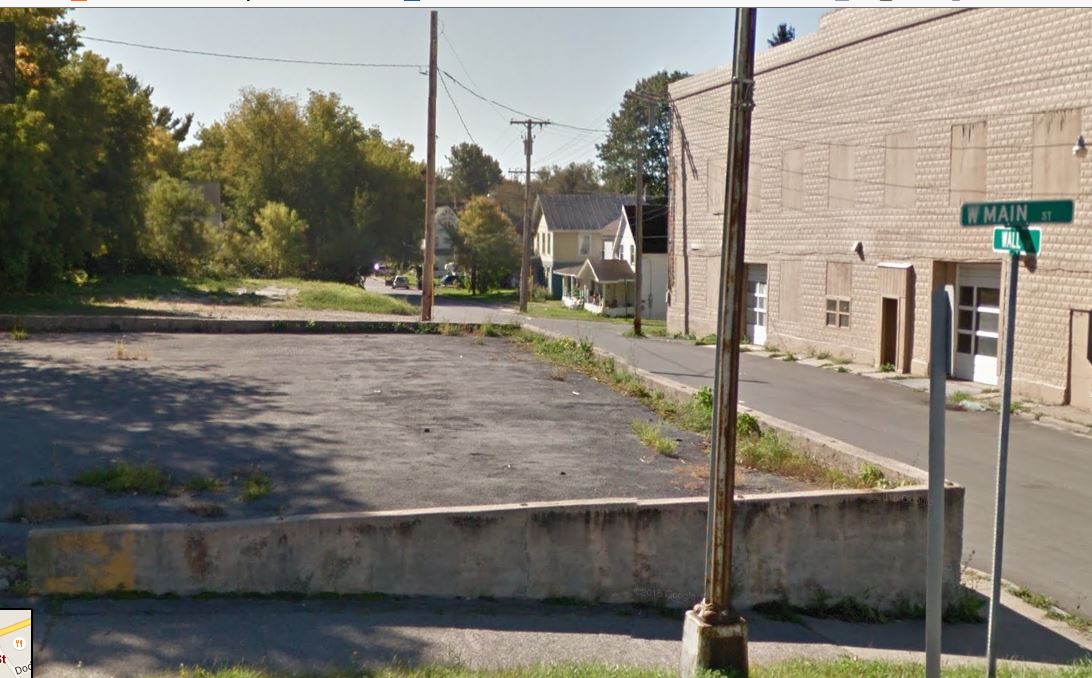
In the heart of Gouverneur is the historic old Red Brick Tavern of Peter VanBuren at 11 West Main Street. It is now the residence of Mrs Hazel Burnett Hudson, whose great-great-grandfather's daughter, Elizabeth Burnett, married Dr John Spencer, purchaser of the property in 1822. Coming from Windsor, Connecticut in April 1807 Dr Spencer was not only the first practicing physician of Gouverneur but one of its earliest tavern-keepers.
Likewise was Peter VanBuren, a native of Mayfield, Montgomery County, who came to Gouvereneur in 1819 as a youth of 16 one of the North Country's first as well as greatest inn-keepers.
Beside the front door of the old house is a plaque bearing the following inscription, placed there by the Gouverneur Morris Chapter, DAR in 1931: "Red Brick Tavern, built in 1818. Maintained by Peter VanBuren, nephew of President VanBuren, as a hostelry on historic stagecoach route, 1831 between Utica and Ogdensburg.
The history of the Red Brick Tavern starts in 1818 when John Brown who opened Gouverneur's first store in 1809 built the small brick house which became the tavern's nucleus, and in 1822 sold it to Dr Spencer who enlarged it and operated it as a hotel until 1824. Then he sold it to Moses Rowley, another early hotel operator and later under an execution it went to James Averell. It was Averell who disposed of it to Peter VanBuren in 1831 and from that time until it burned in 1848 VanBuren conducted it as a hotel. After the fire he rebuilt it as a residence and it remained in the VanBuren family until 17 years ago.
Born November 17 1803 Peter VanBuren located in Gouverneur about two years after his elder brothers, Harmon and Thomas Harvey VanBuren, who came in 1817. At first Peter clerked for Moses Rowley and later at the Hoskins Hotel in Ogdensburg. Acquiring the Red brick tavern in 1831 he soon established a state-wide reputation for his warm hospitality, the completeness of his appointments and the excellence of his food. His broiled steaks and meats, which he insisted on cooking himself, were a magnet to epicurean travelers. May 12 1831 he married Maria Cadwell of Lowville. In 1842-1844-1845 he served as supervisor of his town and in 1851 was Village President of Gouverneur. It was he who planted the trees which graced the downtown plaza and hauled water by stoneboat to keep them alive.
When he died May 24 1870 his widow, Maria, and unmarried daughter Emeline continued to reside in the old red brick house. It was in March 1868 two years before VanBuren's death that James Averill, owner of the tree studded plaza park deeded it to the village fulfilling VanBuren's ardent wish.
February 20 1873 Maria Caldwell VanBuren deeded the red brick house to her daughter Emeline who at age 87 died there September 10 1927. On December 5 1928 her executor conveyed the property to Smith and Beatrice A Collins, Mrs Collins conducting it as a tea room until her death March 3 1942. Later it became the home of Mrs Hudson whose great-great grandfather's daughter became the wife of Dr John Spencer, one of Gouverner's three slave-owners some century and more ago.
So the former old stagecoach tavern has a wealth of history as it stands well kept in picturesque beauty at the corner of West Main and Wall Streets today.
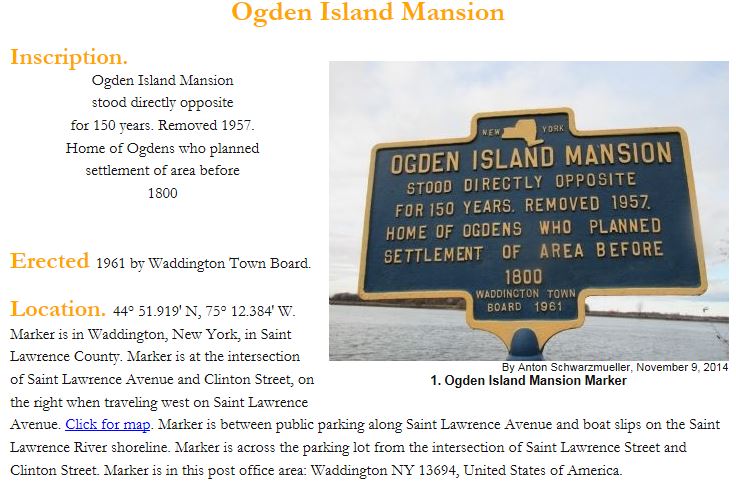
The Ogden family is one of the most noted in this nation. Some of them were intimates of General George Washington, Alexander Hamilton, Gouverneur and Lewis Morris and ether great figures of American Revolutionary days. Some of them also owned extensive lands in St. Lawrence county, and for one of them, Samuel, the city of Ogdensburg was named.
Two others, David A and Gouverneur Ogden, established themselves at Waddington, named for Joshua Waddington, their brother-in-law. For another Ogden, the city of Ogden, Utah, was named. That was Peter Skene Ogden. William Butler Ogden, a founder of Chicago, became first president of the Union Pacific railroad in 1862. All of these Ogdens were descended from John Ogden who emigrated from Hampshire, England, to Southampton, L I, in 1640 and then located in Elizabethtown, N J, in 1664.
May 3 1792 Alexander Macomb conveyed over 90,000 acres of land to Samuel Ogden. This was all of the town of Oswegatchie and part of the towns of Dekalb and Cambray. He was born at Newark December 9 1746 and in 1809 the year before his death on December 1 1810 he sold the site of Ogdensburg to David Parish for $8,000. In June, 1796 his brother, Abraham, and the latter's sons, David A and Thomas Ludlow Ogden, with Josiah Ogden Hoffman paid William Constable $60,000 for the town of Madrid.
In April, 1803 David A and Thomas L Ogden deeded onethird of their interest in the town of Madrid to their brother-in-law, Joshua Waddington, and for him the town and village of Waddington later took their name. The village had been originally called Hamilton in honor of Alexander Hamilton, who had been a law partner of these two Ogdens in New York City.
Just across the south channel of the St. Lawrence river at Waddington is Ogden island, site of today's house. From limestone quarried from the riverbed this vast 52-room house with Its three stories, cellar and subcellar strongly arched for adequate foundation, was built with sturdy walls three feet thick as a residence for David A Ogden. Born January 10 1770 in New Jersey, David A Ogden became a noted lawyer, married Rebecca Cornell Edwards of New Bern, N C, who drew 25 slaves as a part of her dowry and is reputed to have brought some of them to Ogden island. In 1811 T L Ogden and Joshua Waddington conveyed 1,135 acres of land including the island which consists of about 750 acres to David A Ogden and that year he planned to relinquish his New York practice and move to Waddington but the war came on in 1812 and delayed that program. After peace, however, he is said to have moved up, made a large clearing and built the house, which became the rendezvous of outstanding Federalists and many noted personages. But by January 1 1820 Ogden had mortgaged the place, lost it and June 11 1829 died in Montreal. A fire a few years ago played havoc with the interior, but still there is much left of the beauty and master craftsmanship in all but the great stairway and upper floor.
Since October 7 1880 when it was acquired from the Ogden family by Ebenezer and Sarah P Crapser, it has been owned in the Crapser family, former Supreme Court Justice John C Crapser controlling it and the 620 acre farm now and his nephew, Joel M Howard being the manager. Their information is that the house was built 1808-1811 and was designed by Joseph Jacques Ramee, but that is unlikely as David Parish didn't bring Ramee to this region until October 1812 and in January 1813 he left. However, the great mansion is rich in history and still pointed out in it is the "bishop's room," where the Episcopal bishop stayed when in Waddington, where David and Gouverneur Ogden had played such a role in building beautiful St. Paul's in 1817 near which Gouverneur Ogden lived in Ellerslie. From 1817-1821 David A Ogden was congressman from the 18th district composed of Jefferson, St. Lawrence and Lewis counties.
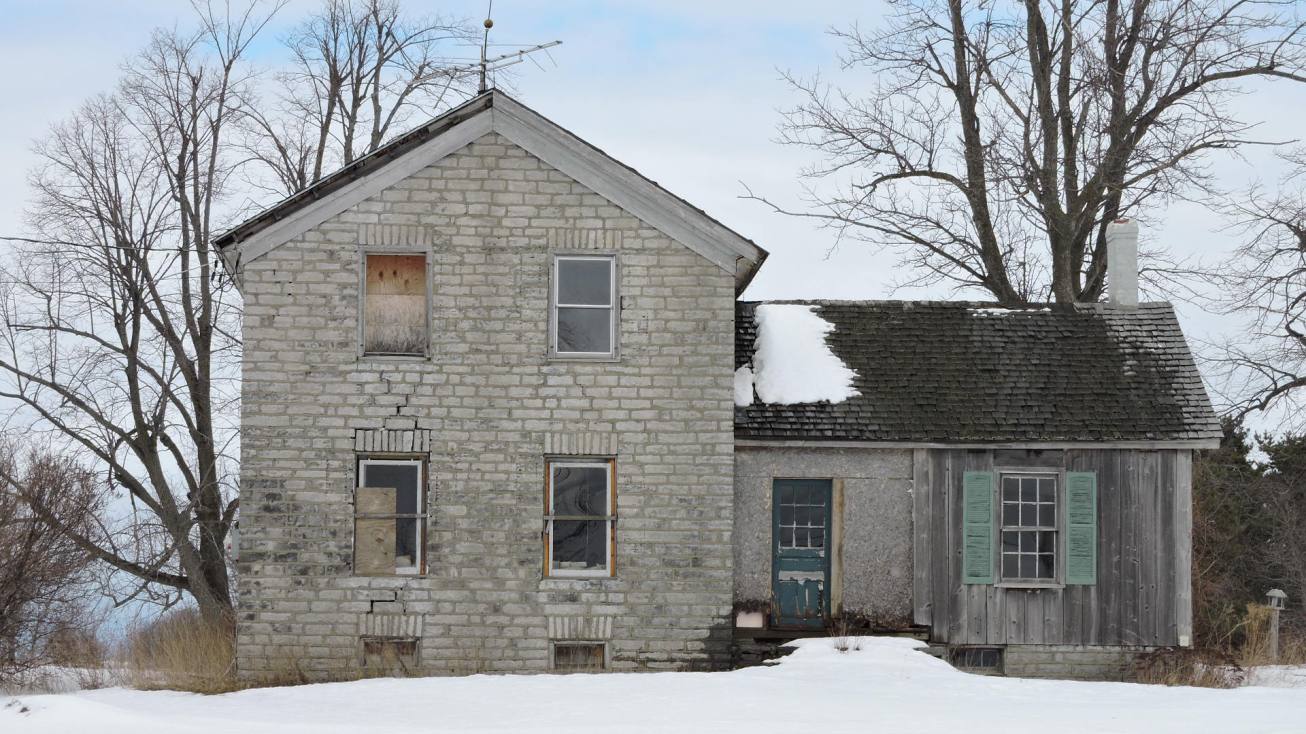
The town of Cape Vincent vies with almost any area of its size in the North Country in the number of its old stone mansions and houses. They stretch from the Wilson's Bay district on the northwest to the Clayton border on the northeast. Some of them are large, pretentious houses. Others are modest little cottage-like homes. Not a few of them are in the Rosiere and French Settlement district.
One of these is the residence of Louis E Chavoustie, farmer, and for some years town highway superintendent of Cape Vincent. That service covered about 16 years and he was rated one of the best town superintendents in the county. He is a son of the late Louis and Nora Sweeney Chauvoustie. His father was a native of the town of Cape Vincent but his grandfather was a native of France. Mr Chavoustie's neat and attractive old stone house and farm is not far from Rosiere on the road which runs from the Watertown-Cape Vincent state highway to Rosiere. The farm now consists of about 80 acres, but when he purchased the house on December 22 1894 more than half a century ago, there was only 48.36 acres of land with it and this was made up of two adjoining parcels.
The property was acquired at that time from the Mance estate, the house undoubtedly having been built for Felix Mance or Mantz, a native of Baden-Baden, Germany, who came to this country some 115 or more years ago, settled first in Rochester before removing to the Rosiere area where he died in 1879 at the age of 80. The year of his coming to the town of Cape Vincent was about 1831.
He had been three times married and it was largely the heirs of his son, Isaac, who sold the property to Mr Chavoustie. The conveyance of the property to Mr Chavoustie in 1894 recites that the same property consisting of one 25-acre parcel and one 23.36-acre parcel, making a total of 48.36 acres, had been deeded to Felix Mantz by Annette Dumastier December 31 1850. However, the 23.36-acre tract had been apparently previously owned by Mr Mance according to a deed of it from him to Annette Dumastier March 15 1844 before the town of Cape Vincent had been set off from the town of Lyme. That deed spells his name still a different way—Mans.
That he had purchased this parcel from Vincent LeRay for $113.25 is evidenced by the record of a deed dated April 12 1842 in which Patrick Somerville Stewart acted as the attorney and agent for Vincent LeRay . It is described as being on the road leading from Lee & Esselstyn's mill to the Cape Vincent turnpike. From other records it seems likely that the 25-acre parcel was first sold by Vincent LeRay to Pierre Barthelemy for $112.50 on July 13 1831 and that it adjoined the east corner of one thousand acres of land sold by LeRay to Count Pierre Francois Real, Napoleon's prefect of police, February 17 1820. Barthelemy was a native of France who served under Napoleon at Waterloo. He died in Cape Vincent at 85. His son, Joseph, married Margaret, daughter of Simeon and Frances Cornaire.
The Mance-Chavoustie house consists of a native limestone upright and wooden wing surfaced with vertical battened boards and embellished with an attractive sidelamp by the doorway
William Rees, a stone-mason, native of Wales, who settled in Lewis county in 1801 was the builder of this unusually fine specimen of stone-house architecture. It is located on the outskirts of Lyons Falls along the road which runs westerly to Collinsville and its possession has never been outside the family, the present owner being Reese M Earle Potter, a great-grandson of the builder.
With the house there is now a farm of about 400 acres, upon which are two quarries of blue limestone, from one of which was obtained the stone used in constructing this house and the one adjoining, which was erected in 1848. It is also owned by Mr Potter and of much less beauty than his own residence. The front door and doorway with its graceful fanlight and elliptic cap make an attractive feature of the facade. As for the size of the house it is deceptively spacious, containing four rooms and a hall on the main floor, five rooms and an oven in the basement, and four sleeping rooms. A low wall of cut limestone borders the front terrace. At the corner of the house towards the village is the small cannon cast at Port Leyden for use in celebrating the arrival of the first railroad train over the Utica & Black River railroad at Lyons Falls in 1867. Since then this piece of ordnance has been used in many a fourth of July and in some political celebrations. The now dilapidated wooden wing was not added to the house until 1850. Seven years later William Rees died and is buried in the little private cemetery upon the knoll across the road. The only other burial in that cemetery is the grave of William Rees.
According to family tradition William Rees, stonemason, and his brother,
John, carpenter, were engaged upon the General Walter Martin house erected
1803-1805 at Martmsburg, the William Constable house built 1809-1819 at
Constableville and probably the Isaac W Bostwick house constructed in
1821 at Lowville. For his work on Constable Hall the family tradition
has it that William Rees was given 300 acres of land at Glenfield. His
brother, John resided in a wooden house at Collinsville. In more recent
years the family added a letter to the name making it Reese instead of
Rees. It is likely that the Rees brothers worked upon many of the outstanding
mansions in Lewis and in Jefferson counties.
A son of William Rees was James Rees, father of Mary who married Marshall Ney Potter, father of Reese M Earle Potter. Marshall Ney Potter was born October 4 1851 at Potter's Corners near Collinsville. Potter's Corners was founded by Joseph and Phoebe Adams Potter and their son, Benjamin Franklin Potter. Joseph Potter was born at Coventry, RI, March 16 1775 and was descended from George Potter who emigrated from England to settle at Aqnidneck, RI, in 1638. From Coventry, RI, Joseph Potter first removed to Vermont, then to the town of Floyd in Oneida county where his son, Benjamin Franklin Potter was born September 29 1817. The latter was a staunch Democrat, taught school in Lewis county nine winters, was married March 11 1846. to Rachel Ann Case of Turin and had several children including Marshall N. Reese M Earle Potter and Alta VanAuken Potter had two sons, Henry Reese Potter and the late Pfc. Ernest Le Roy Potter. 180 th Reg. 45th Division who was killed in action at Anzio, Italy, March 11. 1944 and was posthumously awarded the Order of the Purple Heart.
Built approximately 110 years ago, this limestone house formerly designated 35 and now 275 Franklin Street, is located at the angle where Franklin and Sterling Streets come together, and is believed to have been built by Micah Sterling for his daughter, Emma Bronson Sterling Wardwell and her husband, Nathaniel P Wardwell.
Micah Sterling, Yale graduate of 1804 warm friend of John C Calhoun, prominent Democrat, leading upstate lawyer, land agent for LeRay de Chaumont, congressman and state senator, had built his own fine limestone mansion in spacious grounds a few rods to the eastward in 1826. His son-in-law, Nathaniel P Wardwell, was born at Bristol, RI April 1 1814 and came to Ellisburg in 1820. He attended the academy at Belleville and finished his preparatory education at the academy in Watertown before entering Union college, from which he was graduated in 1837 and studied law. In 1839 he married Emma Bronson Sterling and formed the law partnership of Sterling & Wardwell with her father, but this was to be of but short duration, for young Wardwell died in 1847 at the age of 33.
Early in 1850 this property was sold to Dr James K Bates, Mrs Emma B Wardwell having quitclaimed her interest, and John C Sterling, son of Micah, having acted as guardian for Mr Wardwell's three minor children, Emma S, William H and Nathaniel P Wardwell Jr, in the disposal of their interest. Nathaniel P Wardwell Jr, grew up to be a banker, entering the old Watertown Bank & Loan company, which became the National Bank & Loan company, and then joining with others in 1882 after the Merchants Bank had failed, to form the Watertown National Bank, which he later headed. Mr Wardwell died January 29 1909. Addison F Wardwell and the late Samuel B Wardwell were his sons.
Dr Bates died in 1875 but the property continued in the possession of his family for some time and then the Jefferson County Savings bank acquired it through a mortgage, which it held. Under the will of Dr Bates recorded August 18 1875 his widow, Mrs Serena L Bates, and his son, George Fairbanks Bates, inherited the bulk of his estate.
December 1 1900 the Jefferson County Savings bank sold this house to Mrs Fannie A Waite, wife of H D Waite, local crockery merchant, who had resided there for some time. Later Mrs Waite removed to Brooklyn and on April 19 1923 sold the old house to James Garnett and his wife, Susie Garnett. Mr Garnett, local restaurant proprietor for many years, died several years ago, but the stone house is still owned and occupied by his widow. For a considerable length of time it was utilized as a boarding house. Today it still remains sturdy, facing across towards St. Paul's church at that point where Franklin, Sterling and Clay Streets come together
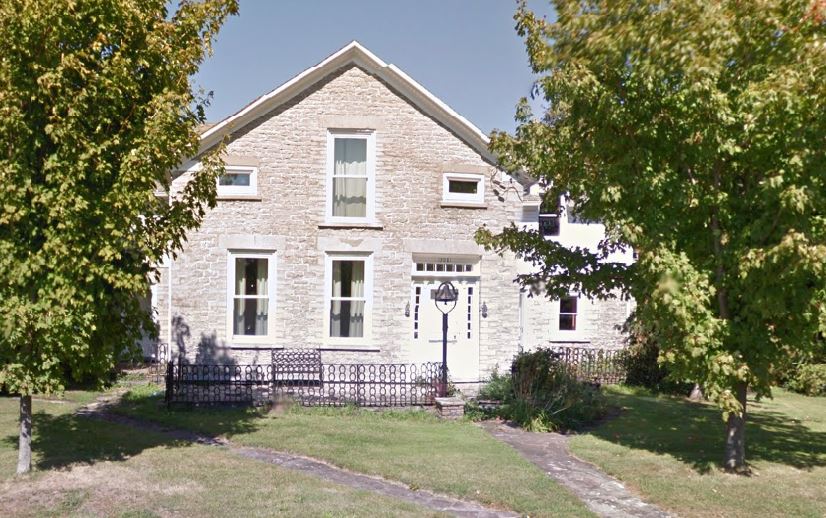
About one mile towards Watertown from Sackets Harbor on the north side of the state road 13981 Dodge Ave) between these two communities is the brick house where resided Dr Samuel Guthrie when he discovered chloroform, first of the anaesthetics, in July, 1831. Next door to the Guthrie house and towards Sackets Harbor is the stone house shown above, owned and occupied by Mr and Mrs Charles W Reed since May 20 1940 when they purchased the property from Mr and Mrs Elon R Howland of this city. Mr Reed, now retired, was for several years county director of the 4-H club. From limestone quarried a few rods to the southward this house is reputed to have been built by James L Jencks about 1818 Jencks having bought a parcel of land in that vicinity from Abram and Diantha Jewett on May 20 of that year. Jewett, who had settled in Watertown in 1800 and established the first brickyard here, later acquired a considerable tract in the Mill creek area of Hounsfield and there a thriving hamlet, named Jewettsville, was set up with the Guthrie and Jencks houses in the heart of it.
Dr Guthrie bought one of his first parcels of land from Jewett August 25 1818. Guthrie added other parcels later including one purchased from Jewett May 30 1821. In these deeds Jewett is said to be a resident of Watertown, although historians claim that he removed from Watertown to Jewettsville in 1818 establishing three brickyards and other enterprises there. Next towards Sackets Harbor from Charles W Reed's house John McDowell Jr, referred to erroneously by some historians as McDole, very early had a frame tavern, much visited by Madison Barracks' soldiers.
Not much is known today about James L Jencks. It is known that Jencks died October 31 1839 at the age of 53 and that Dr Guthrie died October 19 1848. Jencks' widow, Susan, continued to reside in the house and March 1 1872 her heirs disposed of the property to Washington Lee for $2,800. After Lee's death his estate sold the place to Austin R Myrick July 11 1881 and April 18 1882 Myrick deeded to Edwin E Campbell, who disposed of it April 12,1890 to Olin H Lepper. The Lepper heirs conveyed to Thomas E Dorchester June 14 1926 he converting the property into a roadhouse, raising both flanking stone wings from one to two stories. On December 23 1937 Dorchester sold to Mr Howland.
A hasty study of the conveyances between 1872 and 1926 would seem to indicate that perhaps the stone house site was owned by McDowell before Jencks, for there is a deed of September 4 1839 from John and Elmira McDowell to James L Jencks which contains descriptions tallying with those in the deeds onward from 1872. The consideration given in the 1839 conveyance was $350 meaning apparently that the house was not built by Jencks until after that time instead of 1818 on the site which be bought in 1818.
Jencks' name is variously spelled including Jinks and Jenks.
For Sale on Zillow:
Relic of the days when Factory Street was Watertown's finest thoroughfare is this double, brick dwelling, which was owned for 79 years in the Timothy McGowan family. Prior to that it was the property of the Sewall family for 27 years, Mrs Mary Catherine Sewall having acquired it April 10 1840 through Hoel Lawrence and her son, Henry F Sewall as trustees, from Dexter Parker and his wife, Candace. Parker, who had built the first house on the north side of the river between Juhelville and the Court Street bridge, purchased this Factory Street site from Marinus W Gilbert and John Sigourney April 24 1827 and shortly thereafter erected this two-family brick house.
The house is beautiful in its architectural simplicity and down through the years from 1828 to the present it has remained unspoiled by garish modernizations. Not much is known today of its builder, Dexter Parker, and his wife, but much is recalled of its later holders. In the earliest years of the house, was located east of it Roswell Bingham's bell foundry, in which was recast the bell of the First Presbyterian church. Up and down Factory Street the Sewalls owned much real estate.
Born at Marblehead, Massachusetts, in 1786 Henry Devereux Sewall was prominent in commerce and shipping in Boston, Montreal and New York until the crash of 1827. Agent for Gilbert & Sigourney, Watertown cotton textile wholesalers, and husband of the former Mary Catherine Norton, whose family had extensive realty holdings here, he was influenced to locate in this village. Sewall's island was then Norton's island, Frederick A Norton owning the bulk of it.
Consequently Mr Sewall began construction of a fine limestone house in the center of this island in 1828 moving into it October 17 1829. In 1834 he erected a large woolen factory and February 10 1835 was a founder of the Hamilton Woolen Mills. Several brick stores were built by him on the east side of Factory Square in 1834-5-6 and at the same time he built a number of dwellings along Factory Street. The first structure of the Bagley & Sewall shops was erected by him and he bore most of the cost of old Trinity church on Court Street. In December 1840 his wife died and June 8 1846 he died in his fine house on the island. On April 15 1864 his heirs sold the latter property to Alfred D Remington and the house later became the superintendent's residence of the Remington Paper company.
Edmund Q Sewall, son of Henry Devereux Sewall, was partner in the Bagley & Sewall Company and father of Mrs C W Valentine, city; Mr Kendall Emerson, New York, and Mrs John R Searles, Detroit. Then October 30 1867 the Sewall estate sold the big brick house on Factory Street to Timothy McGowan for $1,900. Born in Ireland, Mr McGowan was two years old when his widowed mother and her children landed at Sackets Harbor. They located here, he received his education in the local schools, for a time he worked around the Micah Sterling residence and then learned the tanner's trade, being employed in the leading tanneries of the community. He was married to Miss Elizabeth Murphy about the time he bought the big brick house with its deep lot running to the river bank, and upon the lot he developed the real estate project known as McGowan's Court, which yielded him a good income, during his latter years of poor health. He died January 6 1913 but the house continued in ownership and occupancy of his family until last December 31 when his daughter, Miss Anna A McGowan, sold it to Clarence K Eddy, town of Watertown. The only other living children of Mr McGowan are Mrs Caroline Simpson, widow of William J Simpson, and Mrs Florence F Charlebois, widow of Albert Charlebois, both of this city.
This house of native limestone is the old Willard Ainsworth place on the Pleasant Valley road near Kent's creek in the town of Cape Vincent. It is probably well over a century old, stands on the east side of the highway and is not far from the Deer Lick farm of J R Newton.
Neat and attractive, it is owned by the estate of Frederick Constance whose parents came to this county from Germany about a century ago. Mr Constance, a well known and thrifty farmer who died October 27 1891 acquired the property from the Ainsworth family several years prior to his death. Its present owners and occupants are his surviving children, Catharine S, Elizabeth K, Clara M, Mary M, and Frank F Constance, who operate the 240-acre farm.
Willard Ainsworth, the first owner of the property, was born November 22 1791 at Pomfret, Vermont, son of Henry and Frances Throop Ainsworth. He was a brother of Dr Avery Ainsworth, first physician in that part of the county and also a resident of the Pleasant Valley road. They were great-great grandsons of Edward Ainsworth who was born in England about 1652 and who with his wife, Joanna Hemmingway, became residents of Roxbury, Massachusetts. Dr Avery Ainsworth, who was eleven years older than Willard, first bought land in Cape Vincent from James D LeRay de Chaumont December 15 1809. About nine years later Willard, then a resident of the town of St. Arbans, Vermont, paid Avery $1,400 for his first acreage in this county and the deed describes it as on the road from the village of Cape Vincent to Kent's Bay, which road is now known as the Pleasant Valley road. The price would indicate that there was a house on the land at the time of the purchase and this may well have been this house. Since the house was built a number of alterations have been made. The original, small-pane windows have given way to larger ones. A modern verandah has been added to the front and there has been expansion with dormer windows at the rear. The front entrance, with its witch's cross door and rectangular framing lights, has been kept in its original form. There are nine rooms in the house and one fireplace in the front. The house sets on high ground and the outlook is beautiful with the lake in front and gorgeous sunsets striking it full in the face.
Willard Ainsworth, who married Miss Sally Green of St. Albans, daughter of Nathan Green, August 21 1815 died at his home on the Pleasant Valley road October 18 1865. His wife died October 24 1866. Both are buried in Riverside cemetery. They were the parents of several children, one of whom, Willard Jr, born March 6 1830 at the homestead on the Pleasant Valley road, was a federal customs officer at Cape Vincent.
For more than 125 years the Ainsworth family has been prominent in the town of Cape Vincent and the Constance family for almost as long. There are many descendants of both still residing in the town, among those of the Ainsworth family being David R Otis, Charles Ainsworth and S Kelsey Ainsworth
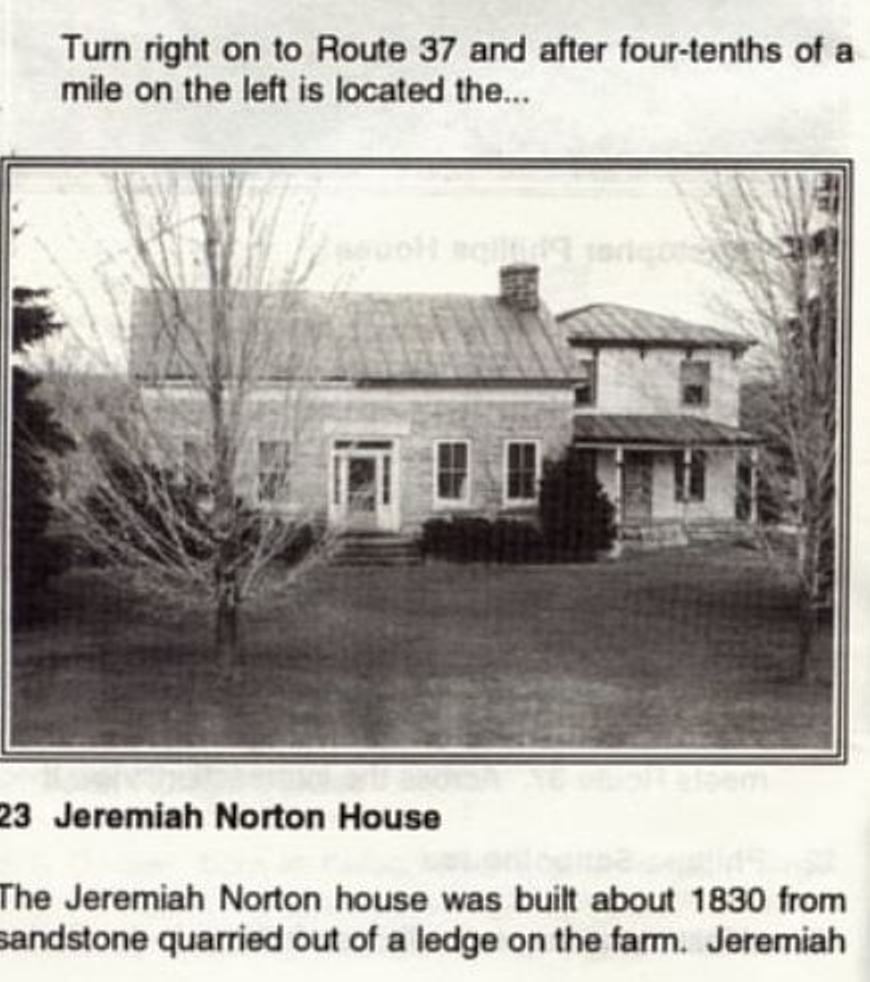
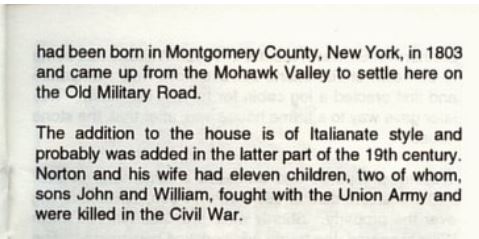
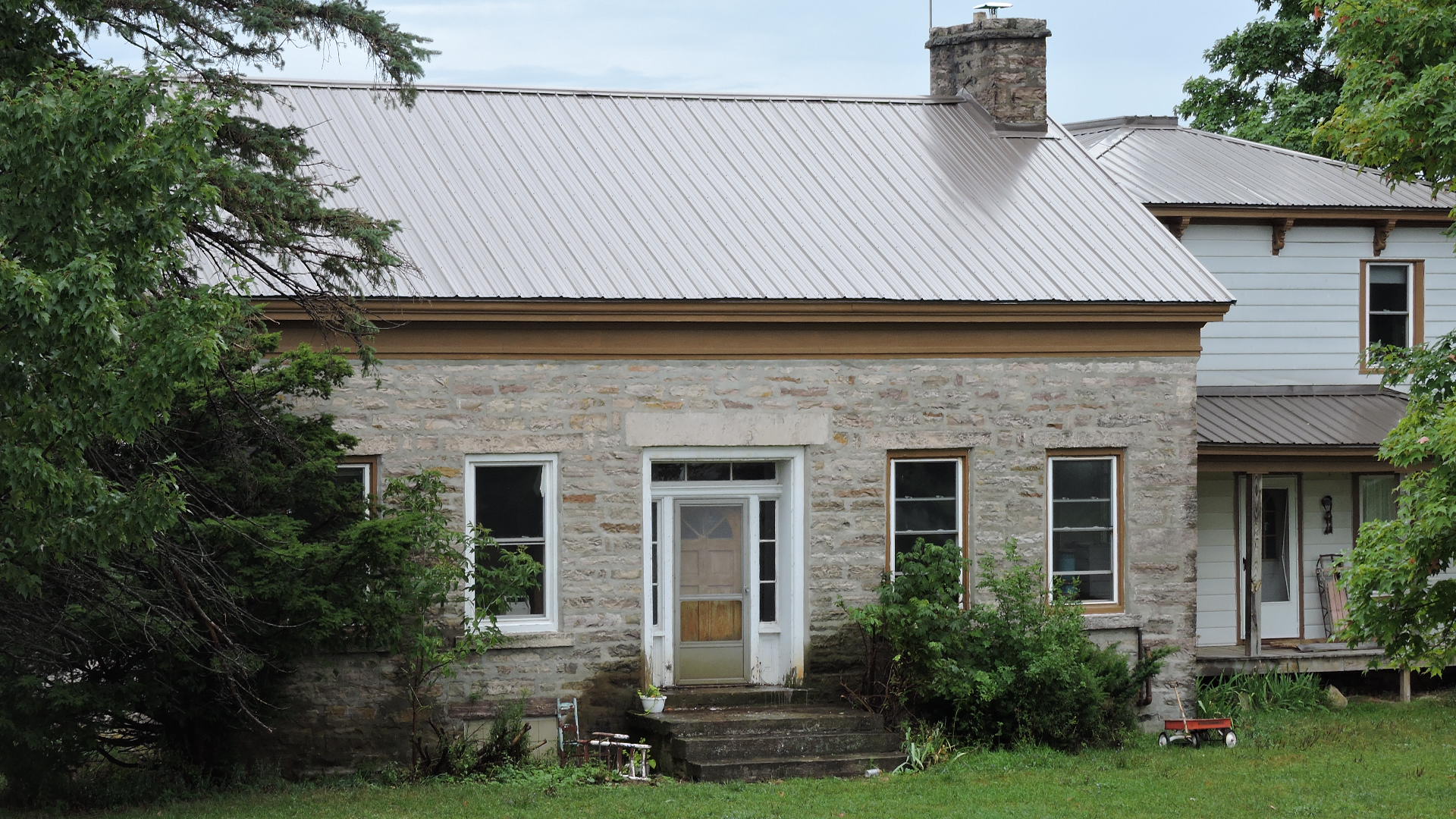
The motorist who travels over the state highway from Watertown through Redwood to Ogdensburg is attracted by the little house of native sandstone which stands upon the south side of the road in the South Hammond area. It is not far inside of St. Lawrence county after having crossed the Jefferson County border and is owned by Murray A Norton, whose grandfather, Jeremiah Norton, built it about 116 years ago. With it at the present time is a farm of 216 acres, which is operated by Mr Norton in dairying.
It was approximately 1830 that Jeremiah Norton caused the house to be built from sandstone quarried out of a ledge on the farm. The stonemasons who laid up the walls were John Leadingham and Amos Rogers. In more recent years a two-story frame addition, which does not conform to the fine architecture of the original stone upright, has been built, but in the original stone house there are five ground-floor rooms and four sleeping rooms on the second floor. Originally there was a fireplace in the house, but that was long ago dispensed with. Georgian in its architecture the stone house, which is of the cottage class, has a beautiful central front entrance with the original six-paneled door opening into a central hall. The door is flanked with rectangular sidelights and has a narrow rectangular transom light to match. The walls are staunch and true, the stone having been carefully quarried, shaped and laid.
This house sits well back from the road and at one side the curving trunk of a large tree bends gracefully to enhance the beauty of the place. Jeremiah Norton, first owner of this house, was born January 16 1803 probably at Oppenheim, Montgomery county. On January 16 1825 he was married to Mary Osterhout, who came from the same part of the state and was born September 5 1806. They had a family of eleven children. Mr Norton died February 2 1885 at the age of 82 and his wife passed away May 22 1893 at the age of 87. Two of their sons, John and William, fought in the Union army and were killed in the Civil war. Aaron, father of the present owner, was born June 18 1845 and died February 17 1917.
The town of Hammond, in which this property is located, was erected March 30 1827 and was named for Abijah Hammond, wealthy New York City merchant and brother-in-law of David A Ogden, prominent New York lawyer and extensive northern New York landowner. Abijah Hammond bought the 28,871 acres of the town early in the 19th century and in September 1814 disposed of it to David Parish. The old Military road, which was constructed after the War of 1812 went through the south part of the town en route to Plattsburgh and in the south part of the town is a vein of excellent building sandstone, such as that from which the Norton house was constructed. In fact a number of stone residences were erected by the early settlers, who included a number of Scotch immigrants between 1818 and 1821. At first the town was noted for its wheat crops, but now it is thoroughly a dairy country
New images, courtesy of Stuart DeCamp:
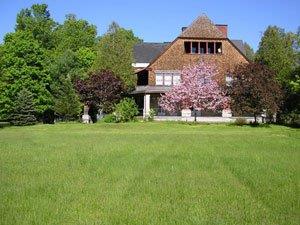
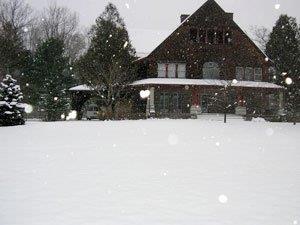
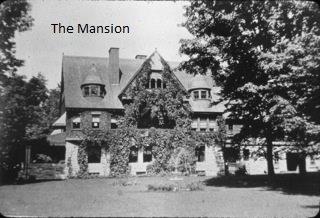
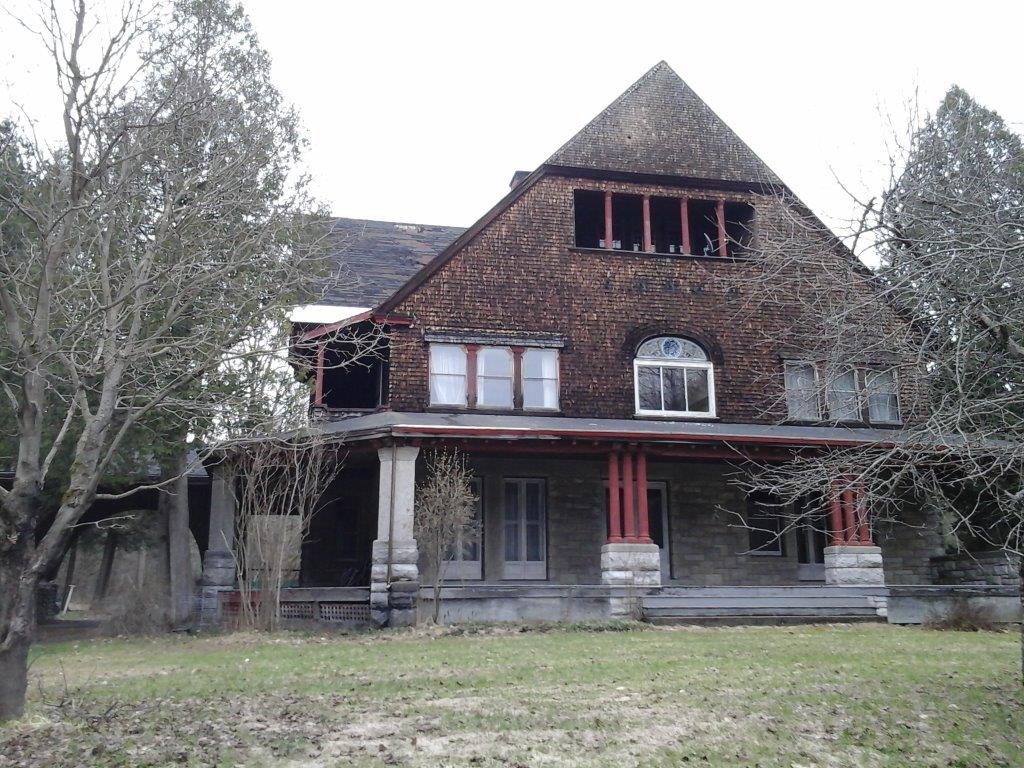
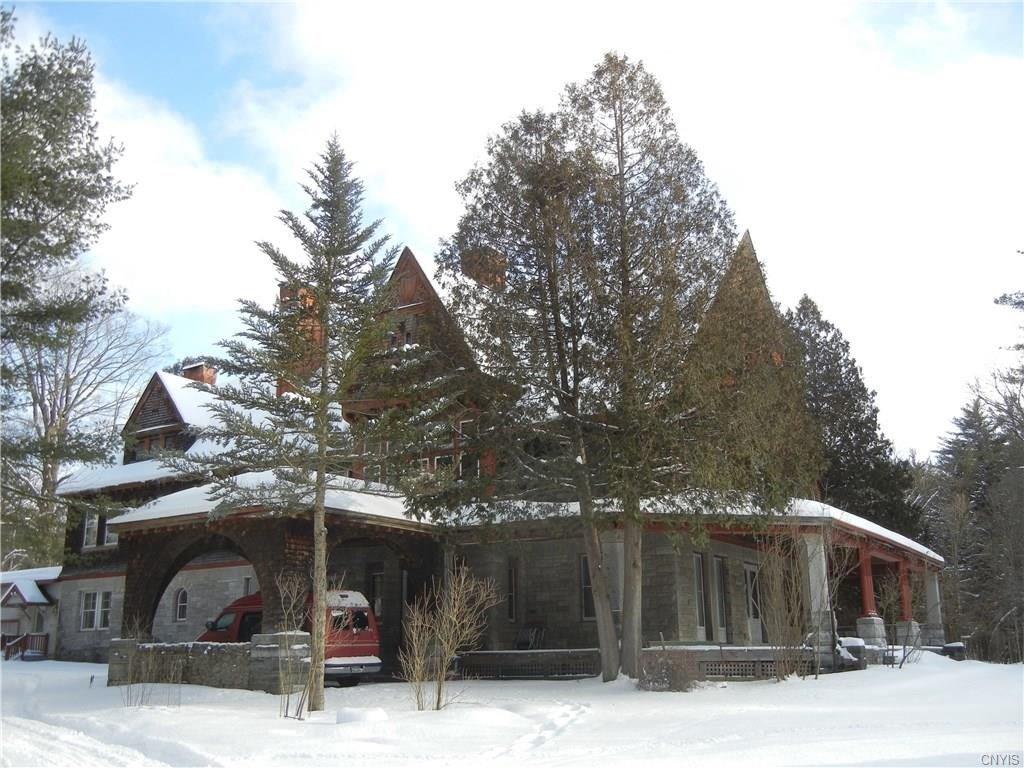
These photos were online because the place was for sale in Feb 2017....amazing!
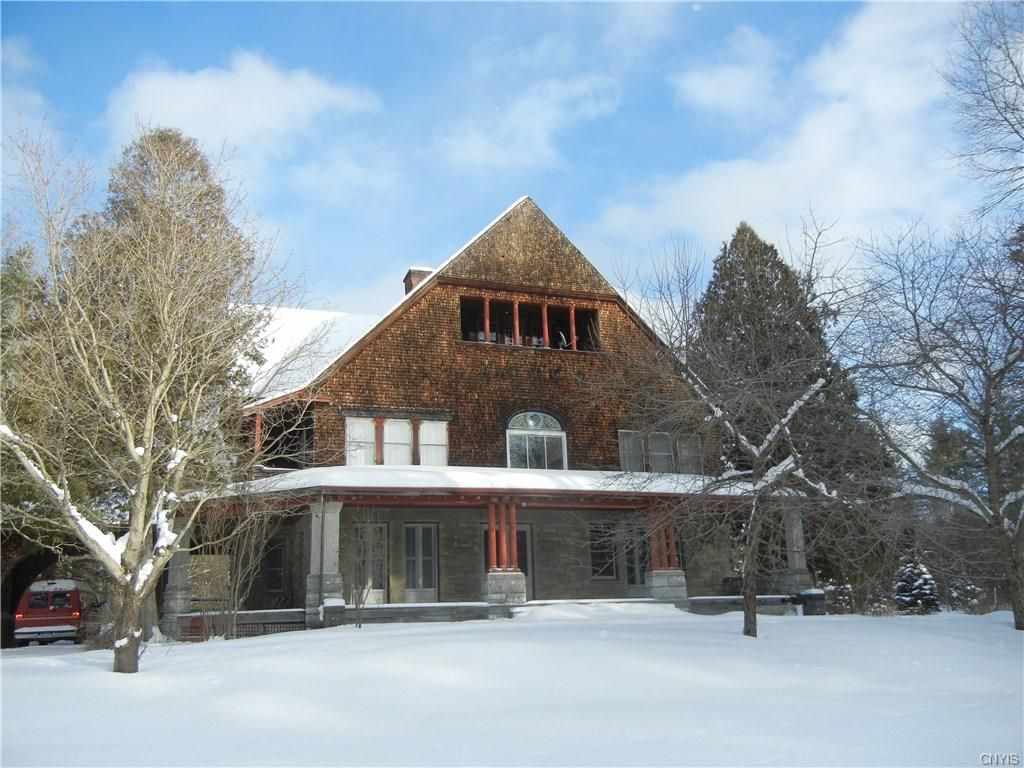
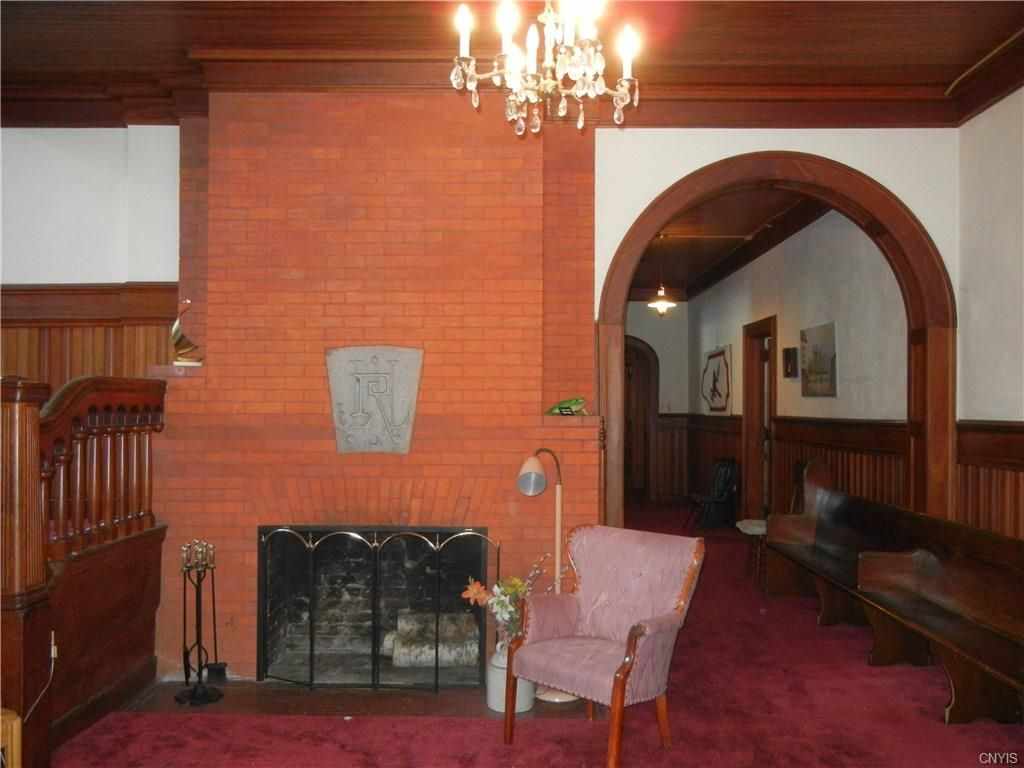
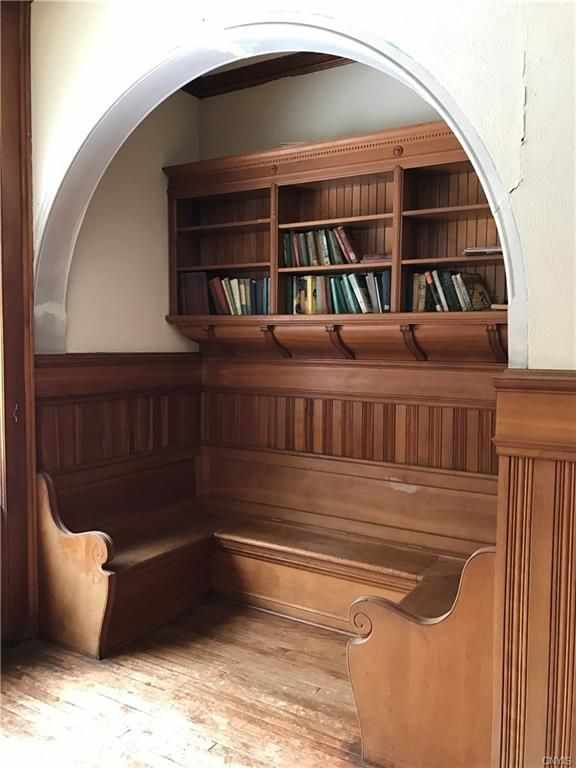
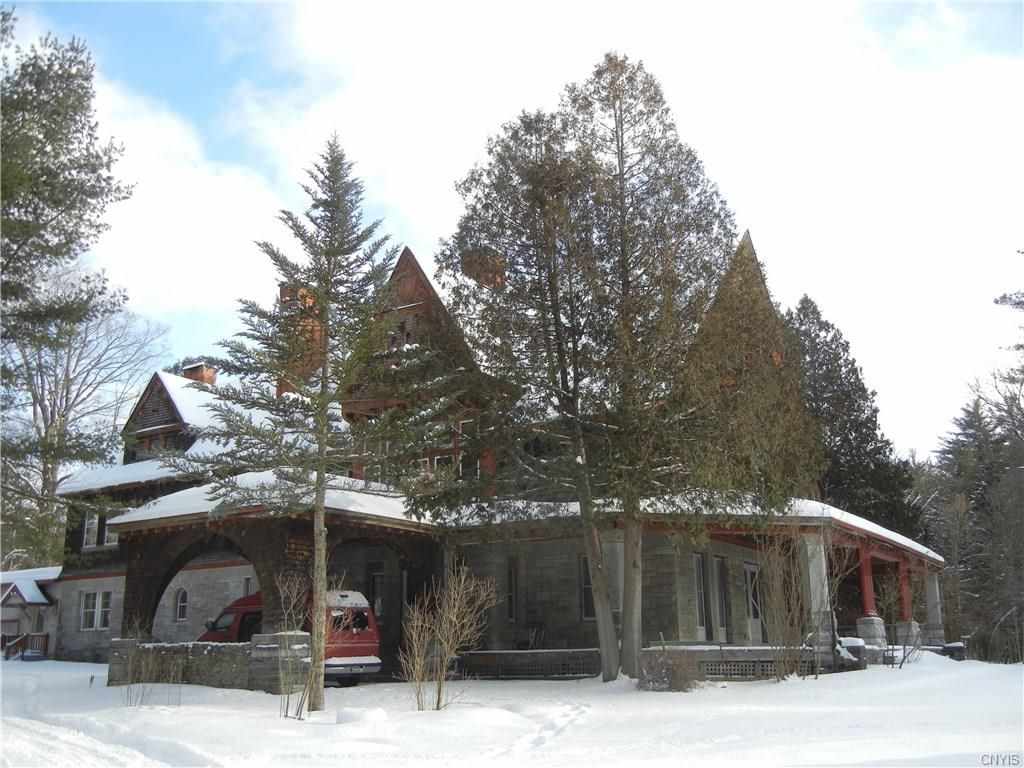
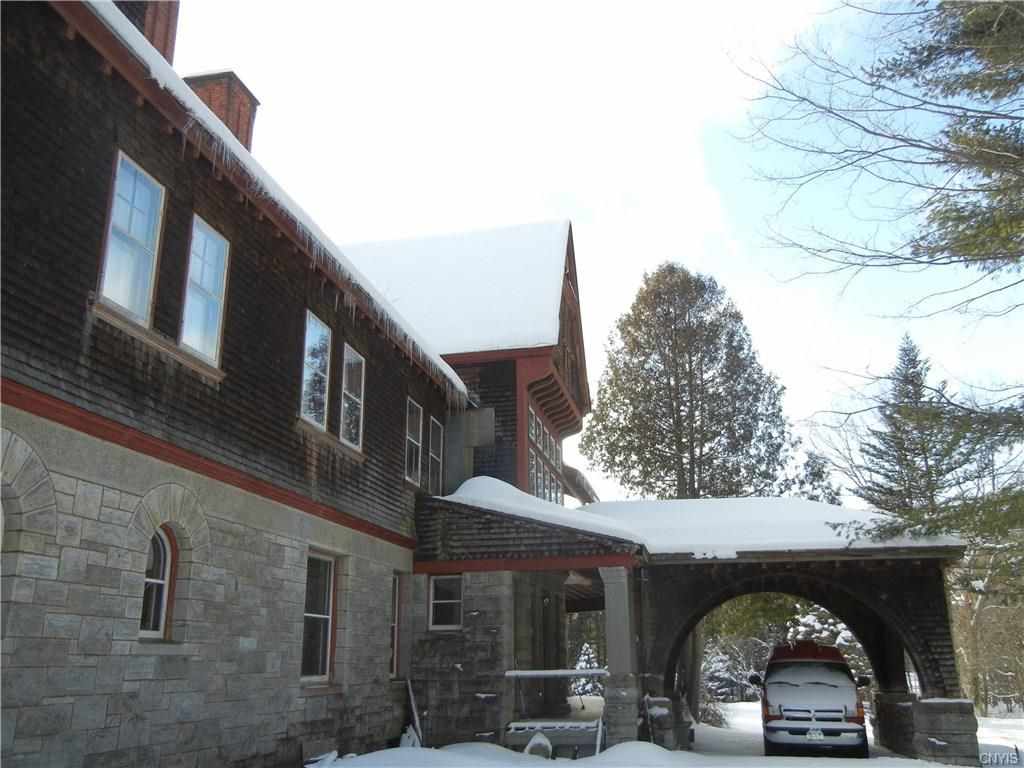
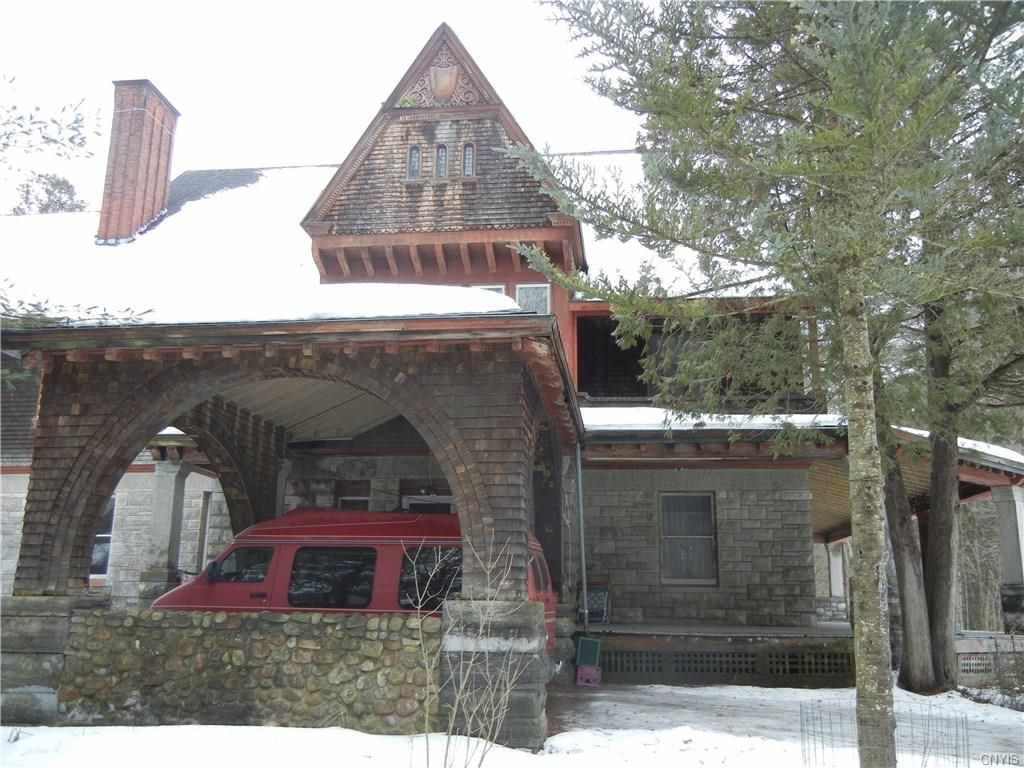
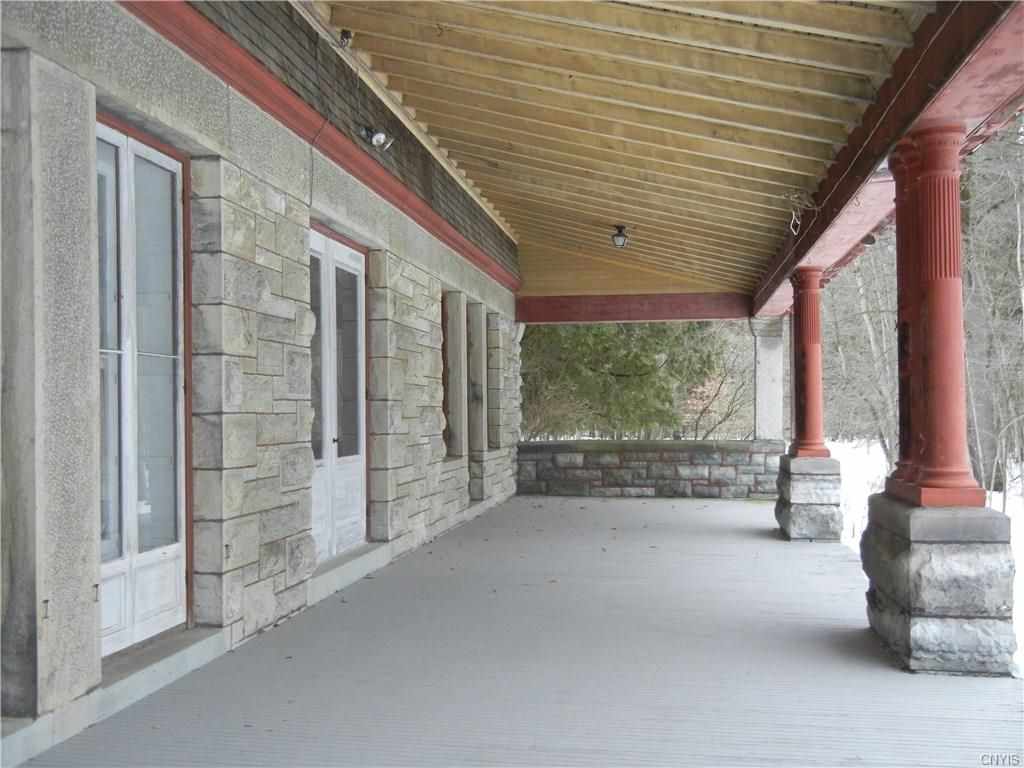

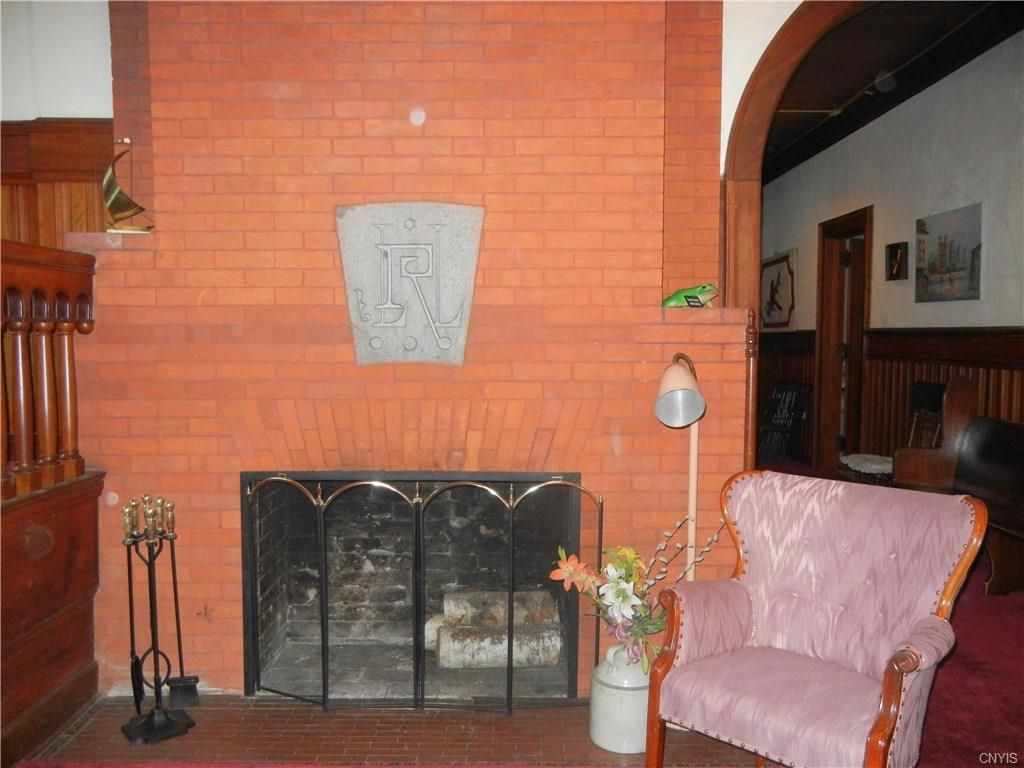
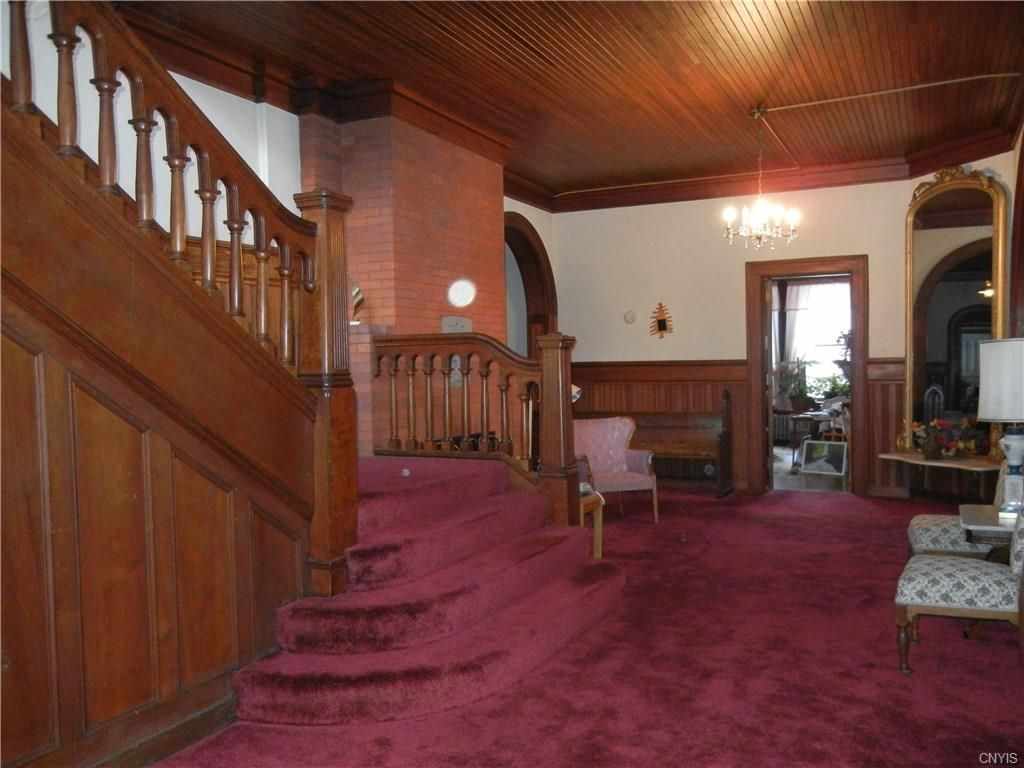

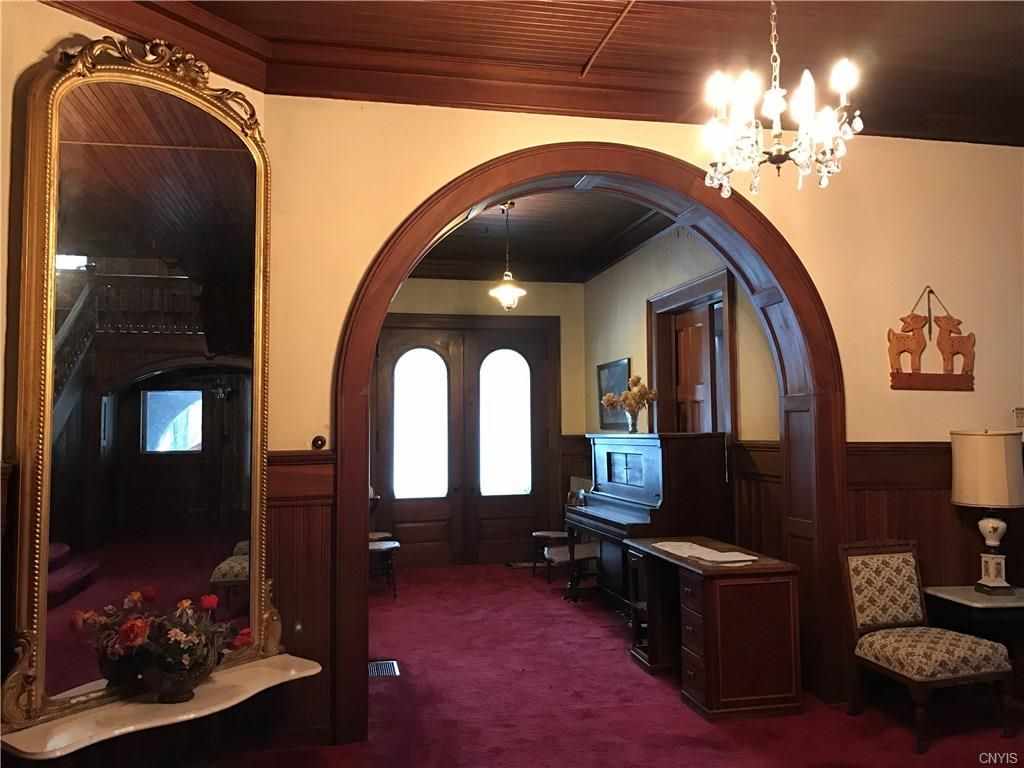
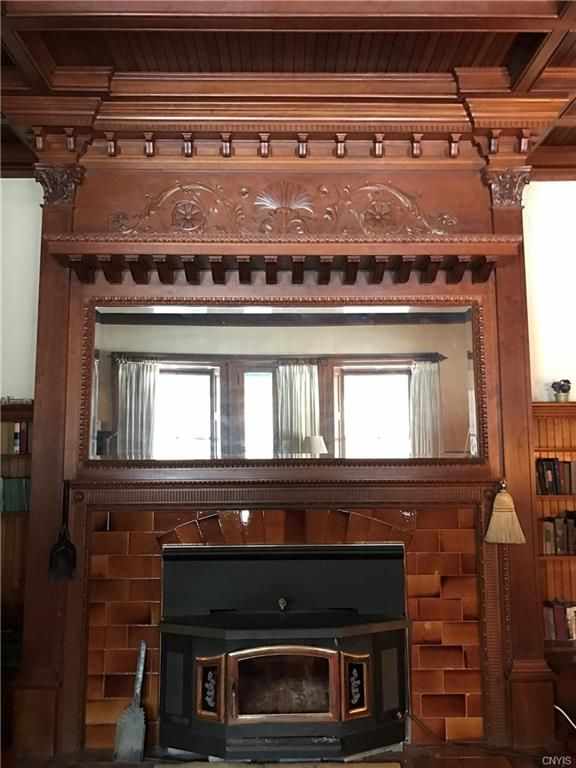
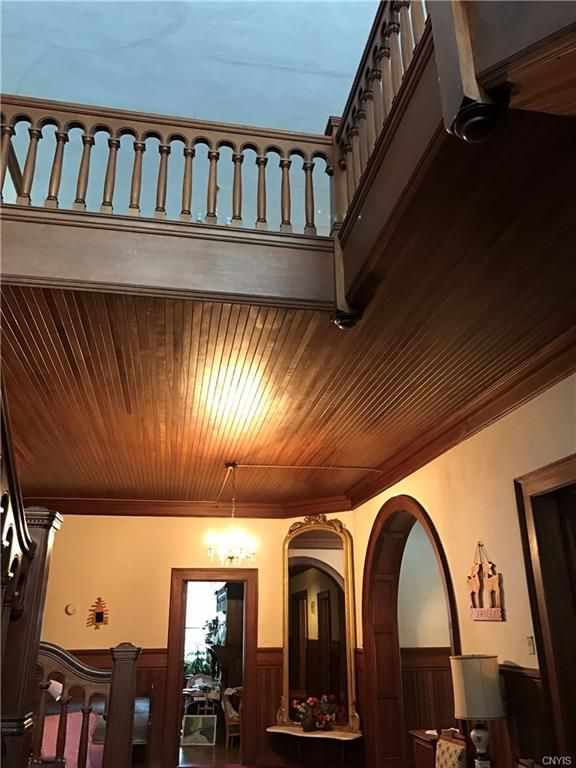
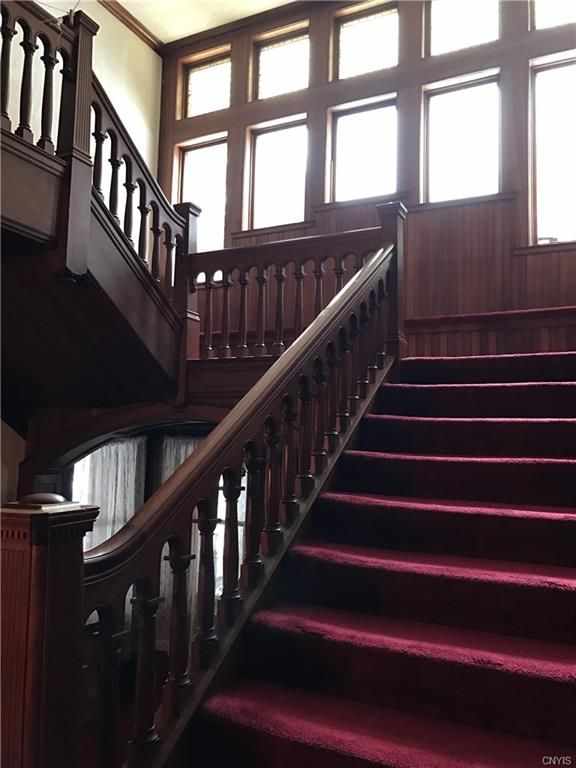
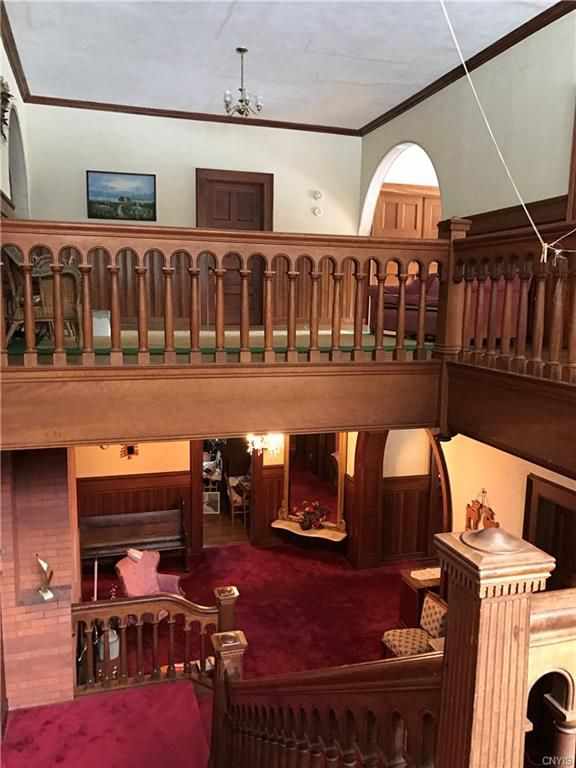
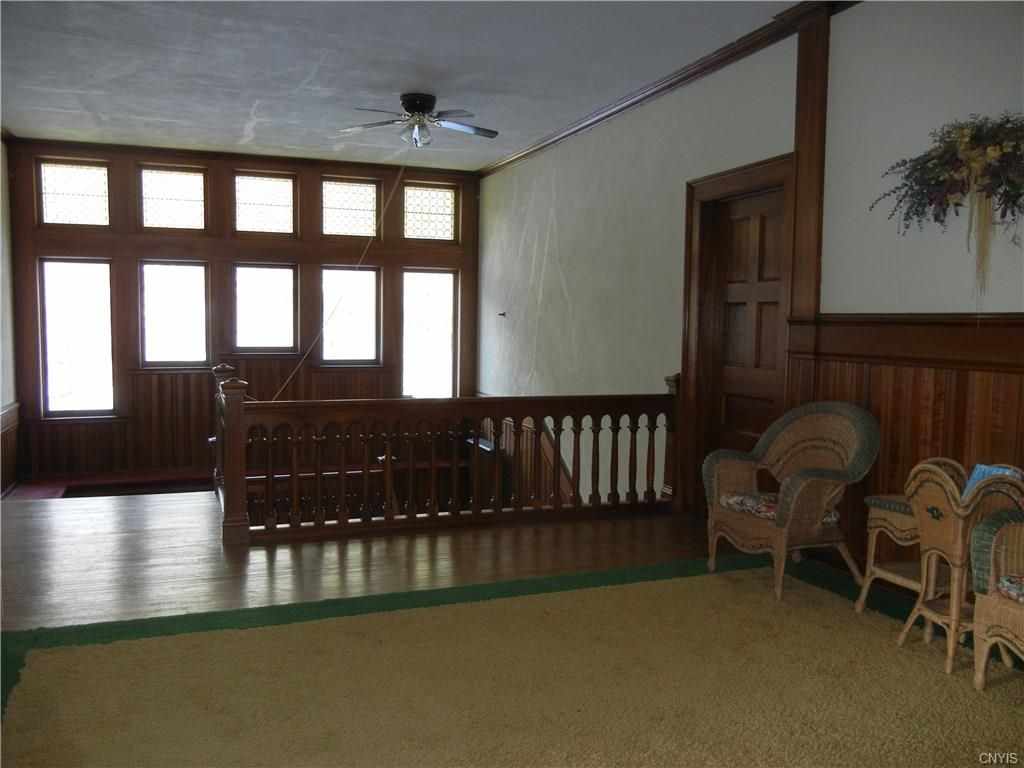
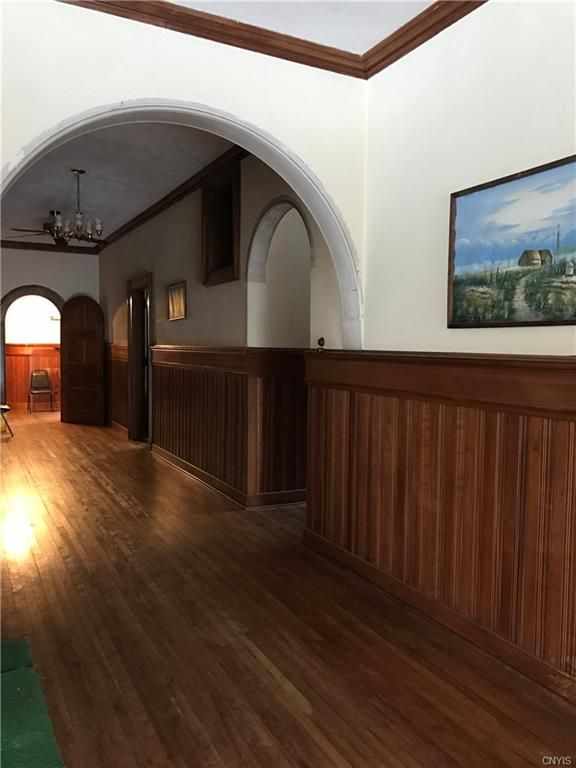
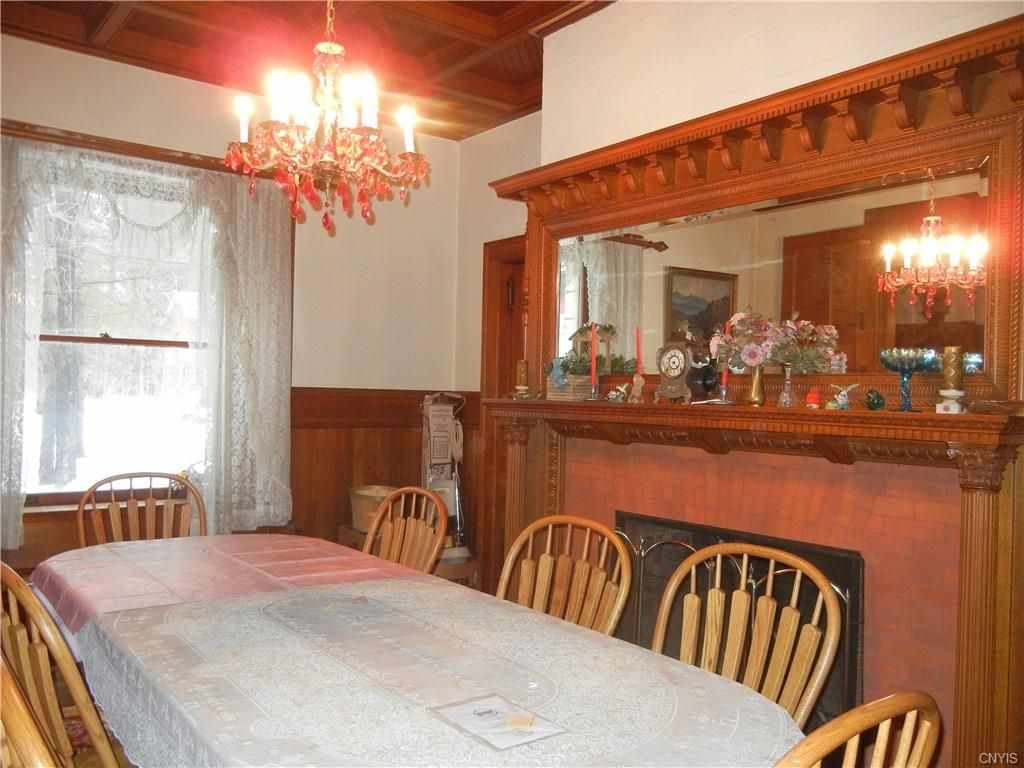
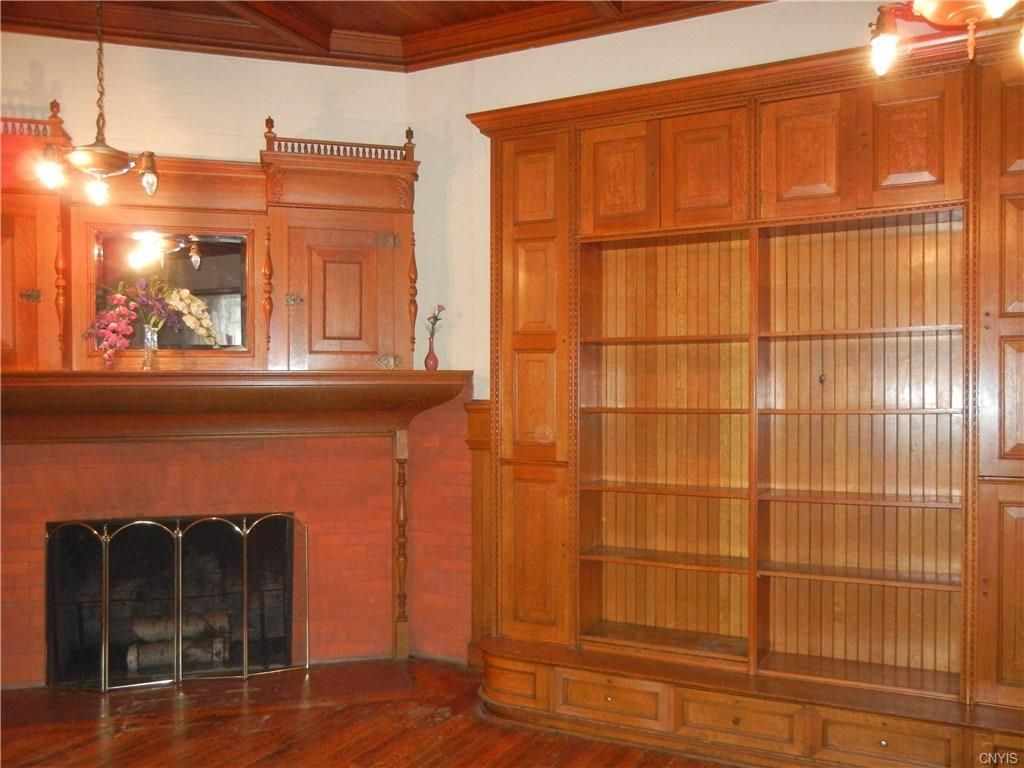
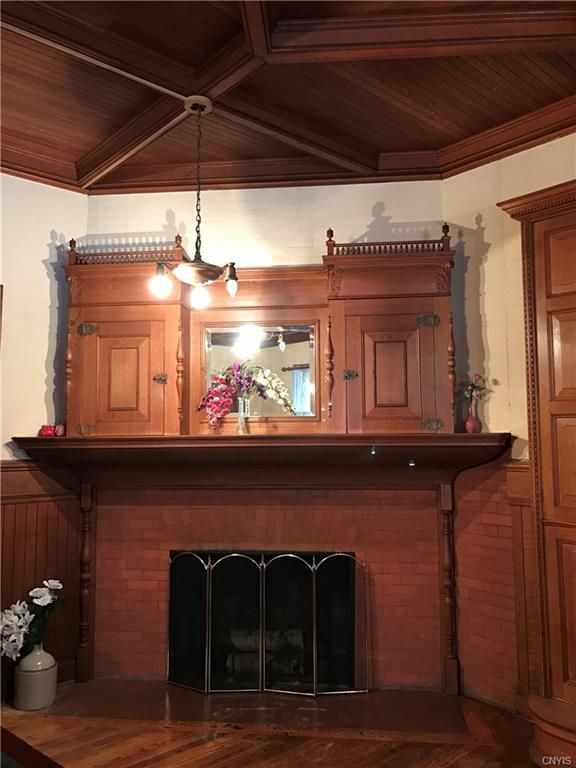
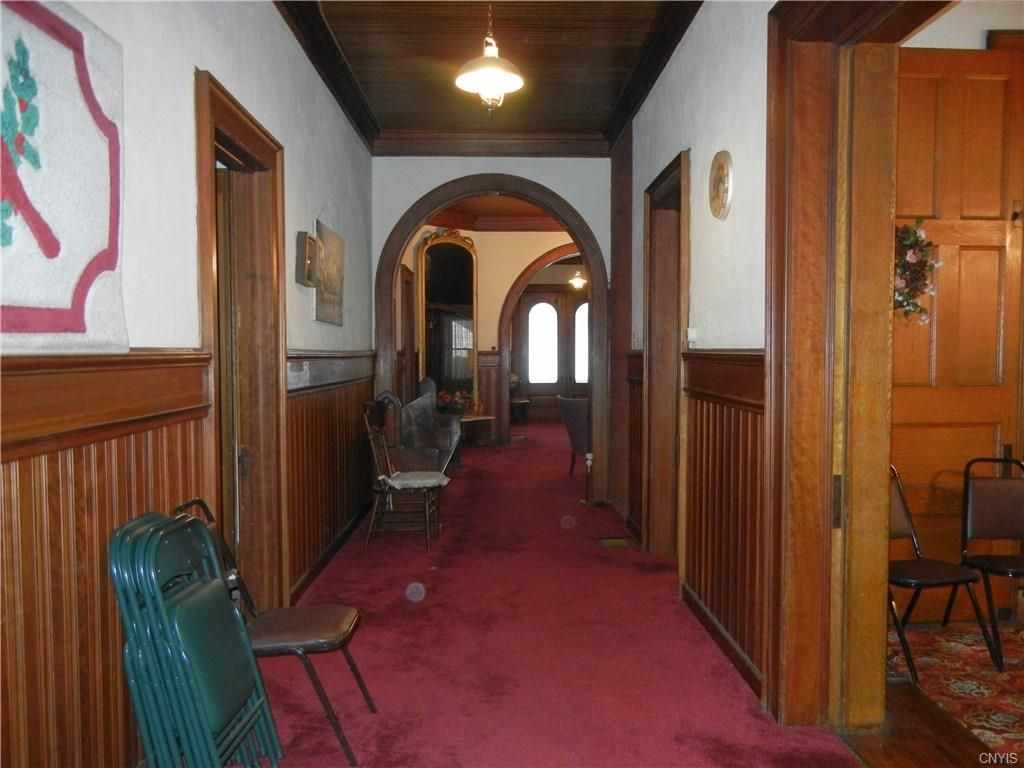
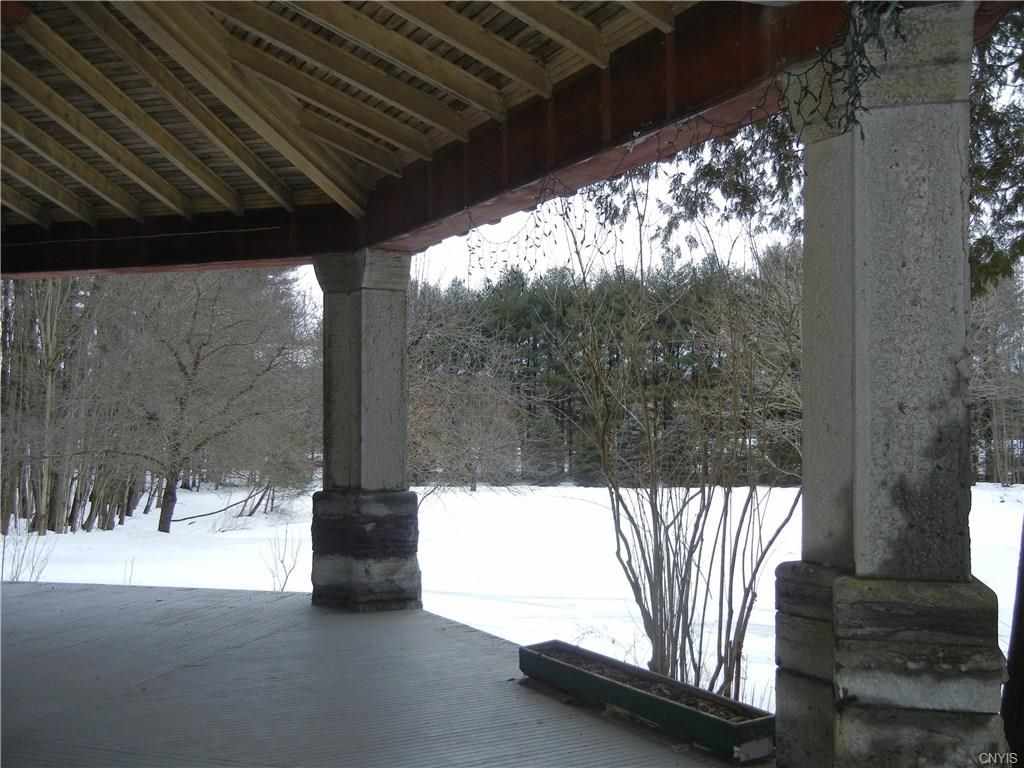
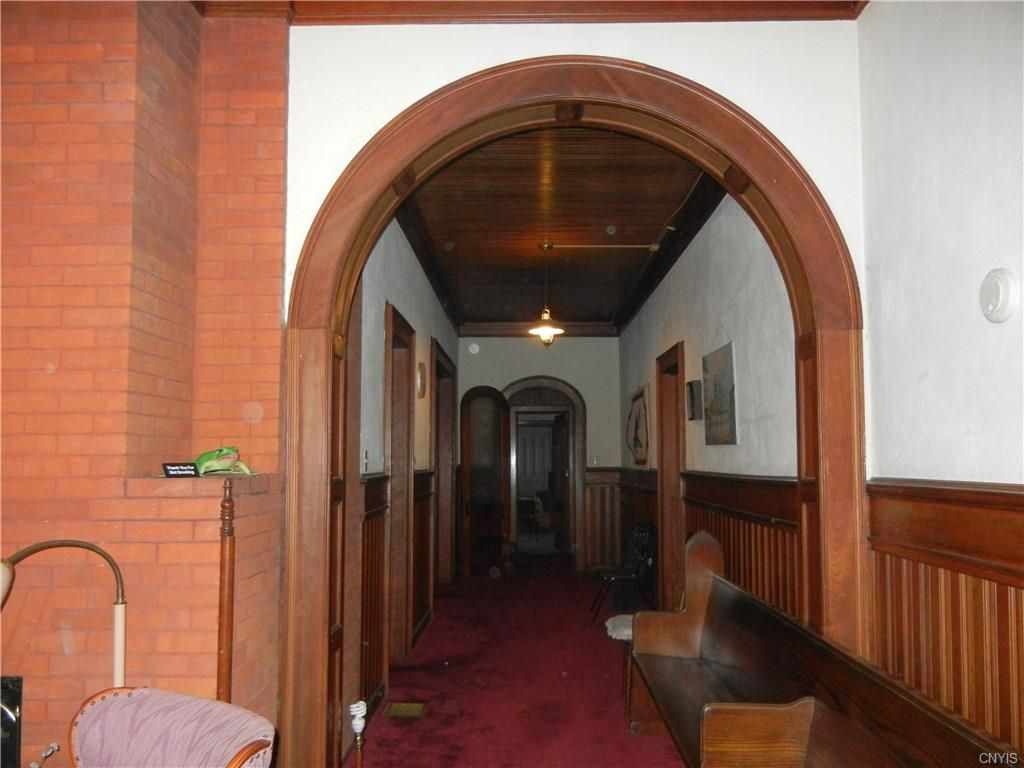
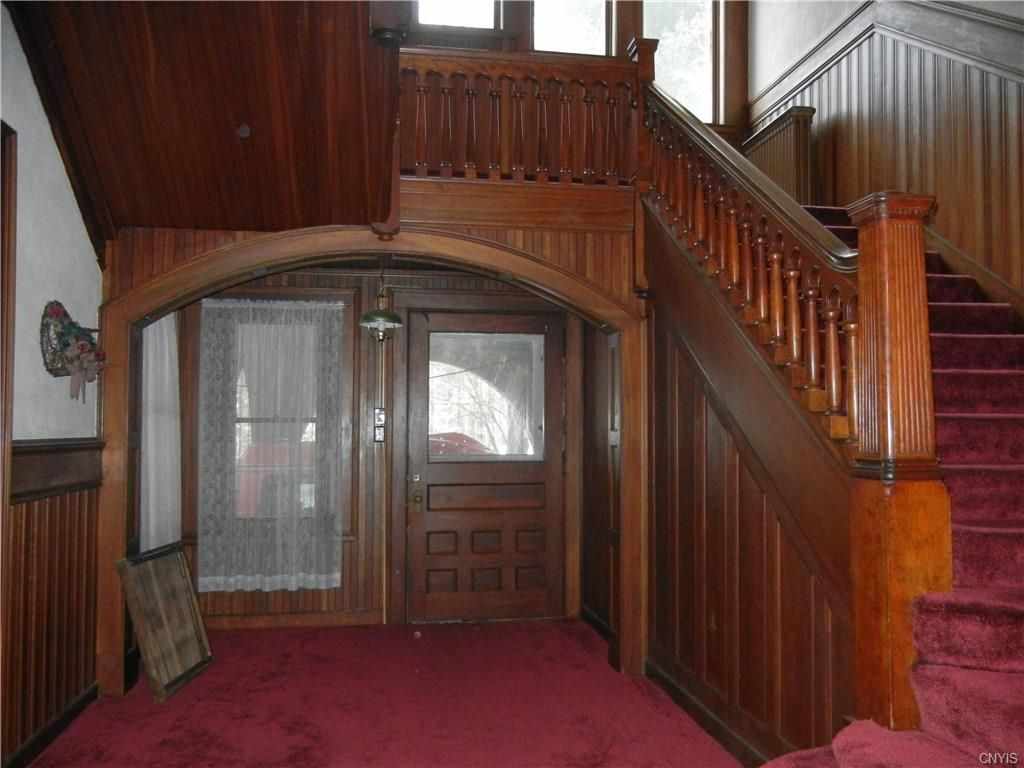
Caleb Lyon, born in Connecticut in 1761 son of a Revolutionary war captain of Scotch ancestry, was made sole agent of John Greig in September 1818 and bought 10,000 acres of forest at High Falls on Black River, establishing one of the most colorful families in Lewis county. He married Mary, daughter of Major Jean Pierre DuPont, nephew and aide to Montcalm. His Lewis county home was at Lyonsdale, and both of his sons, Lyman R Lyon, who was born in Wayne county in 1806 and Caleb, born at Lyonsdale in 1821 were men of distinction. The elder Caleb, close friend of DeWitt Clinton, was elected to the assembly in 1824 and took a deep interest in canal transportation. He died suddenly September 15 1835. His son, Caleb, scholar, lecturer, poet of no small talent, campaigner under the slogan "the poor Black River boy," was the politician par excellence. Garbed in loud checked coats and flaming Windsor ties, with silken hair falling upon his shoulders, the suave poet-politician was appointed consul to Shanghai February 15 1847 but entrusted the duties to a deputy and went to California in the great gold-rush. There in 1849 he was paid $1,000 for designing the seal of California. Returning east he was elected assemblyman in 1850 resigned April 26 1851 went to the senate as successor to Alanson Skinner, who had resigned and in the fall of 1852 was elected to congress.
There he became the warm friend of Lincoln with the result that later he was appointed territorial governor of Idaho, a post which he resigned in 1866. His elder brother, Lyman Rasselas Lyon, who became one of the largest landowners and men of wealth in the North Country, was more of the business and less of the showman type.
However, he too was elected to the assembly in 1859 and worked hard to secure locks and dams for the Black River canal. Educated at Trenton and at Lowville academy he early engaged in the lumber and tannery business and erected a large frame house on the east side of Black River, almost on the site of this pretentious 19-room house shown above.
Then about 1860 some distance east of the house, he built a huge barn famed by Walter D Edmonds in his novel, "The Big Barn." About 1869 he completed a fine limestone house on the site of the one shown today. On his way home from Florida he died suddenly at Savannah, GA, April 7 1869 and in the division of his property among his three daughters, Mrs Mary L Fisher, Mrs Julia J DeCamp and Mrs Florence L Merriam, the house property went to Mrs Merriam. On December 9 1886 the stone house with its beautiful interior woodwork of black walnut was destroyed by fire. Shortly afterward Mrs Merriam built the present sumptuous residence, "Florissante," using the stone of the old house for the first story and employing cherry, sycamore and oak for the interior finish. From front entrance to the kitchen's rear door is 100 feet. A mountain spring brook is piped to the house and fountain on the front lawn, which faces the village of Lyons Falls across the river.
Here amid a collection of antiques which includes a rare Queen Anne cupboard of burled walnut with five secret drawers, which originallv came from Sterling Castle in Scotland, live Mrs Delia Merriam, widow of Lyman Lyon Merriam, and her daughter, Mrs Carl Trube. Besides the Queen Anne piece there is a little knee-hole desk of burled walnut, an 18th century corner cupboard from Kentucky in heavy mellowed oak, a French portrait doll of 1790 and many other articles. Mrs Merriam's husband was a grandson of Lyman R Lyon. Prior to her marriage she was Miss Delia Brandreth, granddaughter of Benjamin Brandreth, patent medicine king who settled upon the Hudson.
VISIT THIS LINK TO THE LYONS FAMILY HISTORY PAGE
The beautiful white Georgian residence with the flanking wings at 1709 State Street, at the southeast corner of Eastern boulevard will best be remembered by older residents as "Maplefield," owned and occupied for many years by Frank A Hinds, one of the most outstanding citizens of the north country. Of English descent his ancestor, John Hinds, landed in New England in 1635. Thomas Hinds of Mt. Holly, Vermont, grandfather of Frank A Hinds, settled on a Champion farm in 1809 and was brother of Corlis Hinds, first supervisor of the town of Watertown. Thomas Hinds fought in the Battle of Sackets Harbor in the War of 1812.
Franklin A Hinds was born on a Jefferson County farm to Earl Bent and Almira Allen Hinds November 17 1843 began studying civil engineering in this county, went to Portland, Ore., at 21 and continued study under the city county surveyors for two years, then finished at Yale and for a year worked with an engineer and landscape architect in New York City. Returning to Watertown he was married December 25 1867 to Mary R Thomson, descendant of John Alden of Mayflower fame, her parents, William and Mary T Thomson having moved here from Houseville, Lewis county in 1857.
It was on March 1 1859 that Mr and Mrs Thomson paid Harman Burnam and his wife, Maria F, $8,500 tor this fine old house, outbuildings and 85 acres of land on the north side of upper State Street and on June 7 1876 Frank A and Mary B T Hinds purchased the house and 65.95 acres of land from the Thomson estate, adding more acreage later. About the house they developed a beautiful grove of sugar maples. Off the rear of the farm a right of way had been sold to the Carthage, Watertown and Sackets Harbor railroad. Eventually a right for Eastern boulevard was sold through the farm.
Mr and Mrs Burnam had bought the place from Frederick and Lodema Woodruff
April 5 1848 for $3,400 and Mr and Mrs Woodruff are said to have purchased
it early in 1839 the price indicating that the house was then there.
Incidentally they were of a prominent early Jefferson County family. Son
of Jonah Woodruff, Mr Woodruif who married Lodema Andrus, fought in the
Battle of Sackets Harbor also. Two of his sons, Gilbert and Walter N
built Washington Hall, the Henry Keep Home and many fine residences here
nine decades ago.
But to the record of Frank A Hinds. He surveyed for the C & A railroad in 1868 and later became chief engineer of the C W & S H R R. Then he designed and surveyed Thousand Island Park, Westminster Park, Round Island Park, Central Park and others in the Thousand Island region. He had charge of the surveys for the Kingston & Pembroke railroad, the New York & Boston Inland railroad, was for some terms Watertown's city engineer, surveying the city boundaries, and, at the turn of the century made the surveys for Thompson Park. For many years he was a member of the city water board, which envisioned and began the municipal power development. Mr Hinds died suddenly August 23 1913 at Hampton Beach, Massachusetts, while on a pleasure trip.
Eventually his house with its eight by eight roof timbers, its bricked in outer walls and its lands went to a number of ownerships and most of the land was sold off.
March 29 1929 William D Moran bought it from the State Street Land Company, Inc., repaired, restored and remodelled its 16 rooms, residing there since that time. Mr Moran, co-manager of Carl M Loeb, Rhoades & Co., has been campaign director of the Watertown Community Chest, president of the Jefferson-Lewis Bankers' association, a former vice president of the Northern New York Trust company, president of the Watertown Golf club, clerk of Emmanuel Congregational church congregation, and for 14 years chief clerk to the division engineer of the St. Lawrence division, New York Central prior to September 15 1919. He is a native of Pulaski.
To the northeast of the hamlet of Rosiere in the town of Cape Vincent and perhaps about a mile and a half from the Millen's Bay area of the St. Lawrence river is this old native limestone house. It is situated on the Maple Street or Music Street road and for the past 33 years has been the farm home of Joseph M Mason. Mr Mason is one of the most prominent farmers in the town of Cape Vincent, a near descendant of a German family that came to this country from Saarburg. In the days of the old Water-town Produce Exchange he sold cheese on that board and his membership on the directorate of the Citizen's Bank of Cape Vincent has been extensive. Also he has been an assessor of the town and for a lime served as town superintendent of highways.
It was on February 18 1913 that he purchased this house and farm from Mrs Delia Vautrin and her husband, Claude Vautrin, and Mr Mason relates that Mr Vautrin built the house himself about 95 years ago from limestone quarried from a deposit considerably nearer the St. Lawrence. This stone is of excellent building quality and is nicely cut and faced and has been laid by a careful workman. In fact there is something about the house, perhaps nothing more than its squareness, which reminds one of the Major General Jacob Brown mansion, a more pretentious structure, at Brownville.
Mr Vautrin, who is credited with having built the house, was a member of one of the early French families that settled in the Rosiere and French Settlement region of the town of Cape Vincent. That he was an interesting and colorful character is the reputation which has been handed down of him.
The county records show that Claude, Francis and Alfred Vautrin of the town of Cape Vincent bought the farm from Luther Stedman and wife, Laura, of the same town March 17 1853 and that on April 28 1857 Francis and Alfred quitclaimed their interest to Claude for $1,261. It is interesting to note that Luther Stedman was bom at Hartford, Connecticut, in 1789 £on of Timothy and Hannah Gillman Stedman, that he served in the Battle of Sackets Harbor and that he settled in the town of Cape Vincent in 1839. There, he died in 1875 and it seems extremely likely that be came from the same antecedents as Edmund Clarence Stedman, noted American poet, editor and critic, who died January 18 1908 and who was born in Hartford in 1833 son of Maj. Edmund Burke Stedman and Elizabeth Clementine Dodge Stedman.
Undoubtedly the immigrant ancestor of both Luther and Edmund was Isaac Stedman, a London merchant, who settled in Scituate, Massachusetts, in 1637. Luther Stedman acquired this property from Eli Farwell and Abner Baker March 26 1852 it having been a part of what,was known as the Farwell & Baker Purchase, the firm of Farwell & Baker of Watertown having been composed of Eli Farwell, stone mason, early contractor and miller, and of Josiah W Baker. Mr Stedman's purchase of this farm may have been influenced by the fact that he was married to Abner Baker's daughter
